- PREMIUM Panmunjom(JSA) tour with a North Korean defector
- Panmunjom / DMZ Combined Tour
- One Korea Special/The 3rd tunnel
- One Korea Baekhak/The 1st tunnel
- The 3rd Infiltration Tunnel tour in Western Front Line
- Panmounjom's location
- The History of Panmunjom
- The Joint Security Area(JSA)
- Panmunjom Areas of Interest
- Villages in the DMZ
- Camp Bonifas, The Forward Most UNC Base
- The Demilitarized Zone(DMZ)
- 155 Miles of Armistice Line
- The Environment of the DMZ
- The Western Front Line Tour
- The Middle Front Line Tour
- The east Front Line Tour
- Infiltration Tunnels for Southern Invasion
- Location and Size of the Tunnels
- The Process of the Korean War
- The Armistice Agreement
- The Tragedy named 'War'
- UNITED NATIONS COMMAND
- Establishment and roles of headquarters
- a list of UN forces attended
- Pictures that show attended to Korean War
- injuries of UN forces attended
- Paticipation in the Korean War and Cherishing the Memory
- UN Memorial Cemetery
- Media coverage
- PREMIUM Panmunjom(JSA) tour with a North Korean defector PREMIUM Panmunjom(JSA) tour with a North Korean defector Panmunjom is located inside the Demilitarized Zone(DMZ) and is the closet location to Nortth Korea for visitors to see. The tension is very high and only a limited number of people are allowed to visit Panmunjom at one time.
- Panmunjom/DMZ Combined Tour Panmunjom / DMZ Combined Tour Panmunjom and 3rd Infiltration Tunnel etc. This program has been condensed from a two day experience into a one day tour for those who with to see all the sites.
- One Korea Special/The 3rd tunnel One Korea Special/The 3rd tunnel This tour program has been developed to give tourists an accurate understanding of the North Korean regime and the implications of its policies and philosophy on the countries around it, as well as the rest of the world.
- One Korea Baekhak/The 1st tunnel One Korea Baekhak/The 1st tunnel Experience the fierce confrontation between South and North and have a chance to visit the Special DMZ tour program.
- The 3rd infiltration Tunnel tour is Western Front Line The 3rd infiltration Tunnel tour is Western Front Line Experience the fierce confrontation between South and North and have a chance to visit the Special DMZ tour program.

Customer Call Center
- T : 82-2-771-5593~5
- F : 82-2-771-5596
- E-mail : [email protected] [email protected]
Tour Schedule
- 2020 Best DMZ tour Programs by KATA... 2020-12-13
- Notice regarding JSA(Panmunjom) tou... 2020-03-10
- Notice of temporary closure 2020-03-06
- Alternative tour running 2019-11-04
- Japan Self-Defense Forces team tour... 2019-10-28
- U.K. Coronavirus Vaccine: Side Effe... 2020-12-08
- Tours to inter-Korean border villag... 2020-10-04
- Panmunjom tours likely to resume on... 2020-05-21
- Paju, Quarantine spot checks carrie... 2020-01-28
- [NEWYORK TIMES] Life Inside the DMZ... 2019-12-04
Blog / Review 더보기
- combined tour review 2019 2019-10-23
- combined tour review 2019-05-19
- Fantastic review from Alex & MJ 2018-06-12
- Review for ★ONE KOREA TOUR ★ 2018-02-09
- ♥Premium Panmunjom♥ tour review 2018-02-09
- One Korea special tour from Backpac... 2018-01-16
- ★JSA tour review★ 2017-06-29
- ◆Panmunjom tour revirew ◆ 2017-06-15
- ★One Korea Tour Review from Brazil★ 2017-05-24
- One KOREA Tour review from tourist 2017-04-11
- Review from The Bloger from Netherl... 2017-04-07
- Review from The Budget Savvy Travel... 2017-03-10
- Review regarding 2016-12-29
Panmunjom Tour (Without pick-up service)
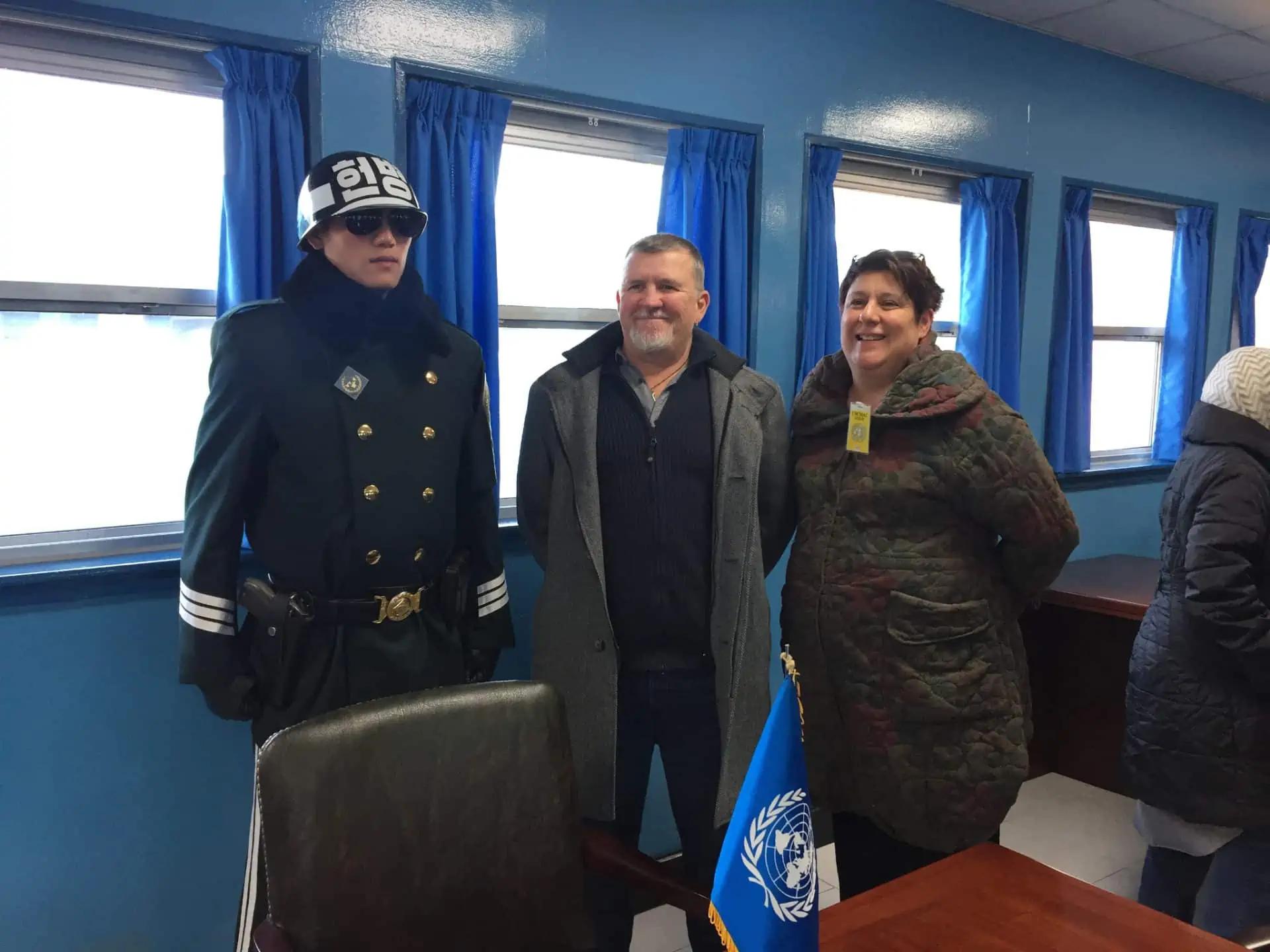
The ultimate Korea must-see for international travellers is a visit to Panmunjom. This area is rich in history, both factual and emotional. There are a few key sites to explore and things to see inside. Don’t miss this opportunity of a lifetime! Discover the most quintessential piece of Korean history on our Panmunjom Tour!
* Panmunjom tour bookings must be made at least 72 hours before your tour date. * Children under 12 years old are not permitted.
- Description
- Reviews (1)
What is Panmunjom? – Where the North meets the South
The original village where the Korean Armistice Agreement was signed is called Panmunjom. Today, this village is located a little north of the demarcation line (inside North Korea). However, these days, discussions between North and South Korea have moved to what is known as the Joint Security Area (JSA).
The JSA and Panmunjom are only 800m apart. Technically, the actual area where Panmunjom tours take place is the JSA, but nowadays, both terms (Panmunjom and JSA) are used interchangeably to refer to the JSA.
Panmunjom is the place often seen on the news, where the North Korean and South Korean border guards stand facing one another. The area is located 53 kilometres from Seoul and just 10 from North Korea’s Kaesong city.
Highlights and Logistics of our tour
There is a minimum age restriction of 12 years for children wishing to visit Panmunjom, and a parent or guardian must accompany them. Everyone needs to book at least 72 hours in advance to comply with the UNC restrictions and allow for a seamless experience.
There is also a restriction on the number of people who can visit Panmunjom each day. Unfortunately, this often results in tours becoming unavailable once that number is reached.
Alternatively, if you wish to see the history and key points of the DMZ without worrying about advanced booking and limitations, we welcome you to have a look at our Half day DMZ tour , which is, in fact, our number one DMZ tour by popularity and offers more convenience and flexibility.
Our Panmunjom tour includes lunch, transportation (excluding hotel pickup), entrance fees, and a visit to the infamous border between North and South Korea.
What you will see on our Panmunjom Tour
One of the best ways to experience the historical significance of the Korean conflict is by visiting Panmunjom. However, as this is a UN military-controlled area operated by the United Nations Command (UNC), the only way to visit Panmunjom is on an official tour with a fully licensed tour guide.
During the tour, you will see the following essential sites.
Imjingak Park – explore the emotional dimension of the Korean War
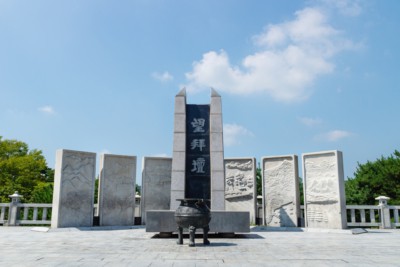
Imjingak Park is a special place. It was created as a safe zone to console the refugees who fled the North, seeking freedom. Here, you can see the train called “The iron horse wants to run”. It was made to symbolise the railroad that connected North and South Korea, which was dismantled during the war.
Next, on our Panmunjom Tour, you can see Mangbaedan. This is an alter where refugees bow to their ancestors lost in the North. You can walk the Freedom Bridge, which was built to free 12,773 prisoners in 1953. Finally, take a gander at the Unification Pond, which is the shape of the Korean Peninsula. Use this opportunity to take beautiful photos here!
The Unification Bridge (Tongildaegyo) – wishing for unity
Built in 1998, this bridge was a physical representation of the wish for the unification of North and South Korea. The bridge was constructed by the Hyundai Business Group of South Korea and stretches over the Imjingang River.
The bridge also serves as a passport checkpoint. While we pass through security, stop and have a look at this iconic construction.
Camp Bonifas – a commemoration of courage
Camp Bonifas is where the UN-controlled Command Forces stay and have jurisdiction. The area was named after the late Captain Arthur Bonifas, who was killed in an act known as “the axe murder incident” on April 18, 1976.
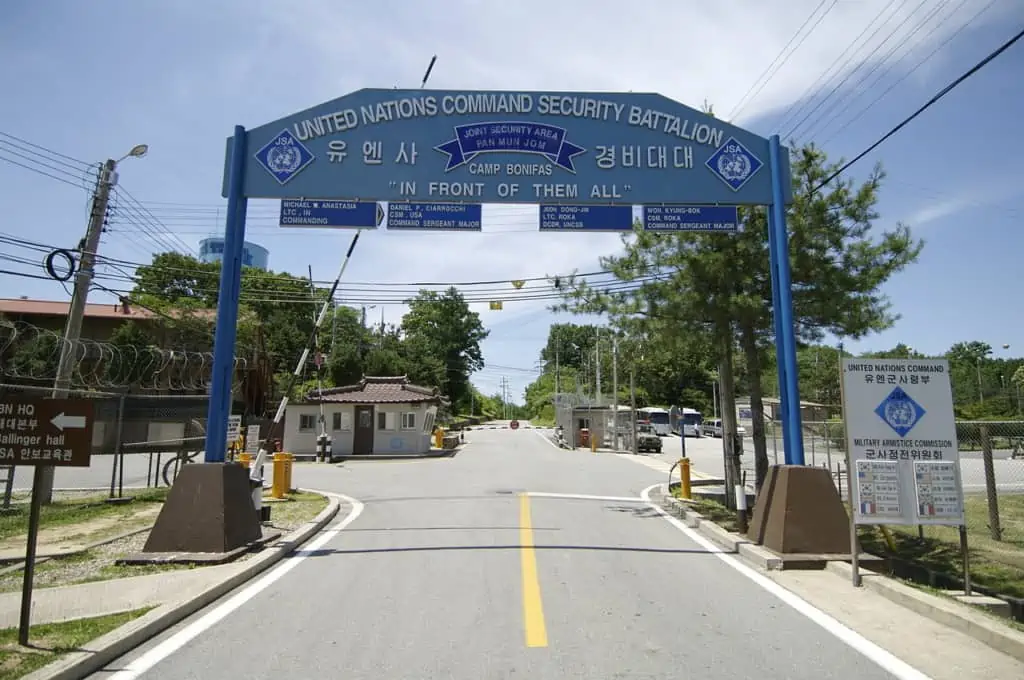
The UN guard forces came to Panmunjom in 1952 in order to protect and promote peace. By the time the Korean War was over, there were 1900 soldiers on the ground. Today, there are about 400. Witness the splendour of the military! Here, you will see a slideshow and have a briefing explaining the area’s deep history.
Freedom House – a space for peaceful negotiations
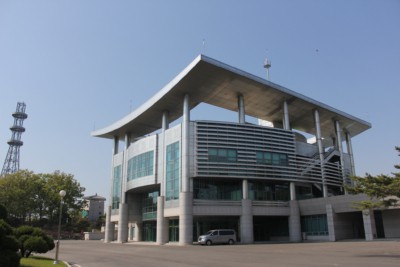
Another essential landmark we will see on our Panmunjom Tour is Freedom House. It was built as a safe space for negotiations between the North and the South. Construction took place back in 1965. Red Cross volunteers helped out, serving as a liaison between the two countries.
Today, the house still sits on the border, although it has been renovated since it was first built. You will see a sleek and modern design with four stories and a transparent roof, so take your camera out and snap some photos!
UNCMAC Conference Room – the room where crucial decisions are made
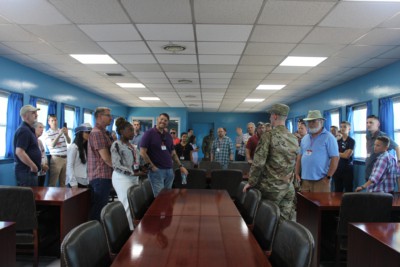
UNCMAC stands for the United Nations Command Military Armistice Commission, which was established at the end of the Korean War in 1953.
Its goal is to ensure that the Korean Armistice Agreement is being honoured. The United States president who spearheaded this commission was Dwight Eisenhower, who advocated for peace between North and South Korea.
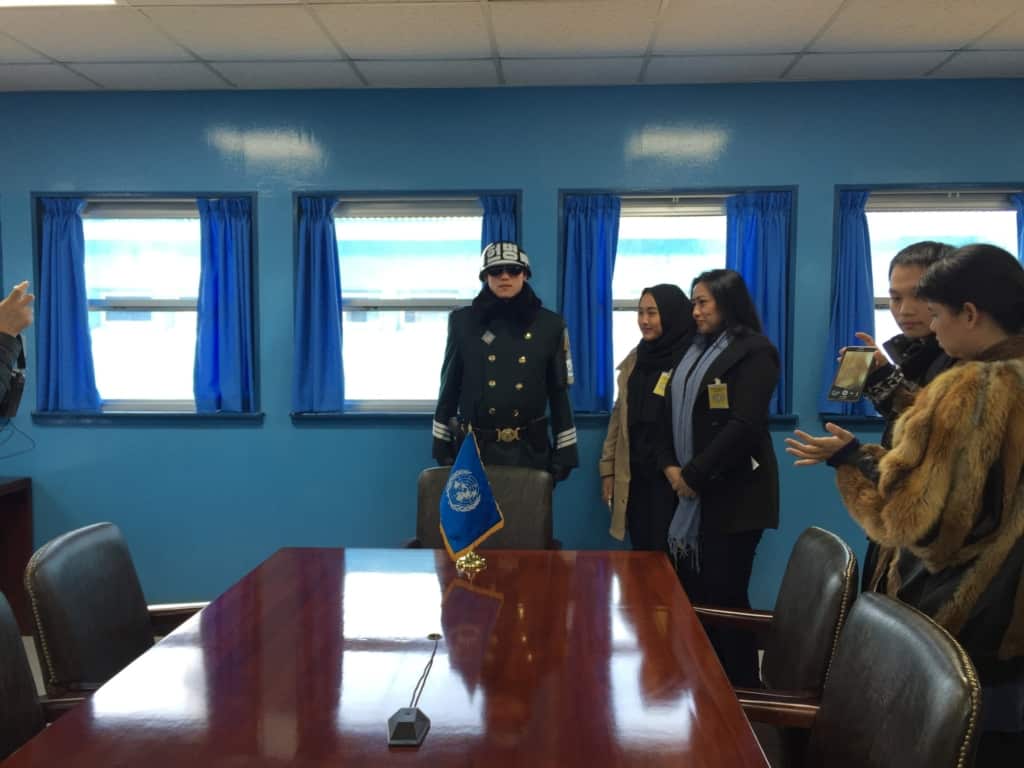
Here you will have the chance to enter one of the UNCMAC conference rooms briefly!
Peace House – the centre of non-military negotiations
The Peace House is where all political talks that don’t have to do with military issues occur. It is located 130 meters from Freedom House.
The building was temporarily erected in 1980 specifically for the meeting of the North and South Korean Prime Minister. It was later rebuilt in 1989. Its design is modern and clean, with a circular park neatly lined by trees.
Tongilgak – a space for discussion
Located in the northern part of Panmunjom, Tongilgak (Unification Pavilion) was meant to be a conference hall back in 1985. Then, in 1992, it began to function as a “liaison” between North and South Korea and has been used as the place for critical political talks. The meetings held here are only those that have to do with non-military matters.
Panmungak – North Korea’s home in the JSA
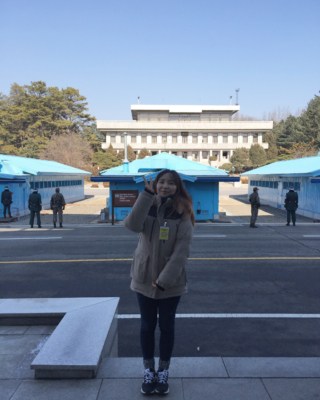
Next, on our Panmunjom Tour, we will see Panmungak (Phanmum Pavilion), the building that represents North Korea in the Joint Security Area.
Located 80 kilometres from Freedom House, this building was completed on September 2, 1969, and is where the offices of North Korean officials are located. Representatives from the North come here to prepare for armistice talks with the South.
The building has also been used to devise propaganda against the South every year on the 15th of August. One such example is the “8.15 Pan-Korean Convention”.
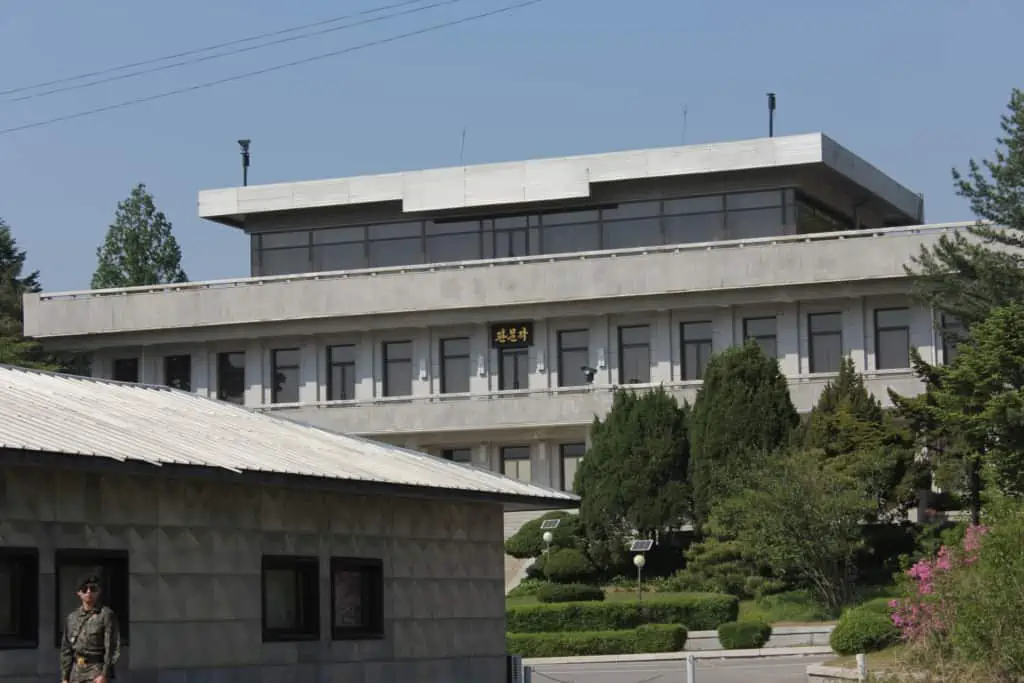
Initially, this building was not opened to the North Korean public, but this changed in 1964. So don’t miss the opportunity to see North Korea’s representative building!
The Bridge of No Return – a crossroads between the North and South
The Bridge of No Return crosses the Military Demarcation Line (MDL) and was used as the only entrance to the JSA from Kaesong city in North Korea.
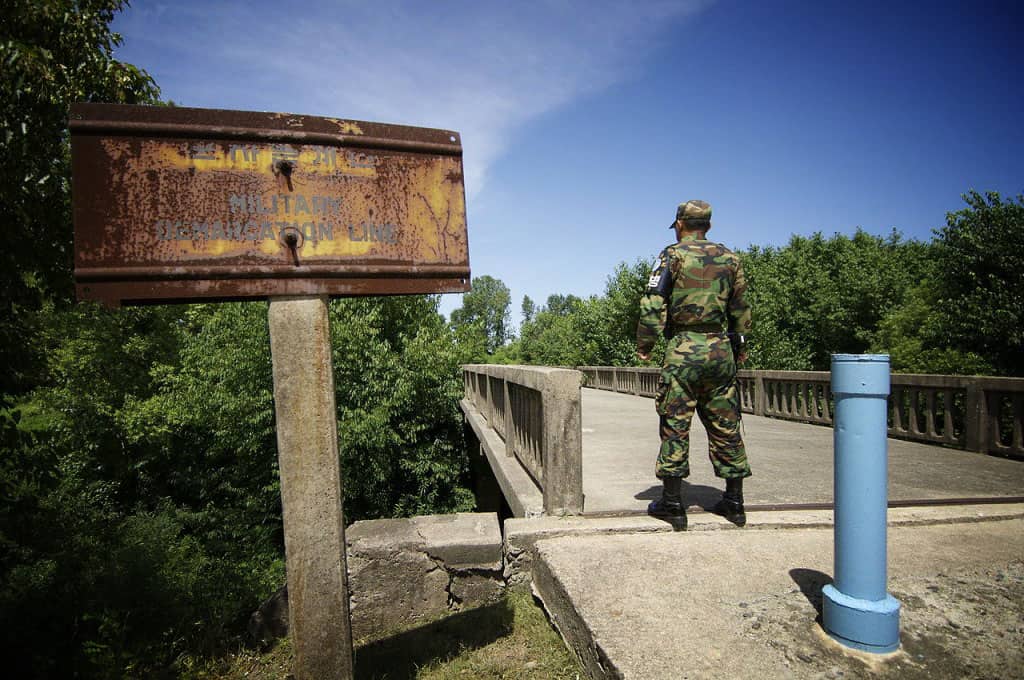
In 1953, a POW (Prisoner Of War) exchange was made right here, and the soldiers were given a choice of whether they wanted to go to North or South Korea. This is where the bridge’s name came from; once a soldier made his choice, there was no turning back!
Later, in 1976, the famous “axe murder incident” happened next to this bridge, resulting in its immediate closure. Today, the bridge is surrounded by trees and vegetation, making it much less intense. However, there is a lot of bad sentiment surrounding this bridge.
72 Hours Bridge – the North faces a tight deadline
After the “axe murder incident” happened, the Bridge of No Return could no longer be used. North Korea needed another way into the area, as that was its only entrance. The country spared no time and built another bridge. As its name suggests, the new bridge was built in just 72 hours.
You may actually have seen this bridge before without realising it. The 72 Hours Bridge is the same bridge a North Korean defector drove a military Jeep across in November 2017! The footage was shown across all major news outlets.
In his bid to escape the North, he got fired upon by North Korean border security, taking 2 bullets while crossing the demarcation line. He was then rescued by South Korean border guards and airlifted to hospital to receive emergency treatment.
Our Panmunjom Tour will give you a fantastic opportunity to learn about the Korean War and conflict resolution. Don’t miss the chance to visit Panmunjom and get a genuine glimpse into the past! However, for the ultimate experience, we would recommend our DMZ JSA Tour , which combines the most important highlights of both the Demilitarized Zone and Panmunjom. Create travel memories you will never forget!
Panmunjom tour Itinerary
- Meet at President Hotel (Seoul)
- Imjingak Park
- Unification Bridge (Passport Check Point)
- Camp Bonifas (Slide Show and Briefing)
- Panmunjom (Freedom House, Conference Room etc)
- Drop Off at President Hotel (Seoul)
Our Panmunjom tour includes
- Professional and licensed tour guide
- Transportation to and from Panmunjom
- Entrance fees and tickets
- NO shopping stops
Additional Notes
- There is no complimentary hotel pickup service available for this tour.
- Please bring your passport on the day for UNC security checkpoints.
- The above itinerary, time and price can be changed depending on the current situation.
- Panmunjom tour bookings have to be made at least 72 hours before visiting. .
- Koreans cannot book this tour.
- There is a strict dress code: Standard blue jeans are OK, but no sleeveless shirts, t-shirts without collar, short pants, skirts, sandals, military-looking clothes, or clothing with country flag or name of the nationality.
- Children must be at least 12 years old and accompanied by a parent or guardian to join this tour.
- The JSA is controlled by the United Nations Command (UNC). There are limited seats due to restrictions.
1 review for Panmunjom Tour (Without pick-up service)
Antonio – September 9, 2019
During booking process staff replied quickly and comfortably. Took copy of my passport so could register me to enter panmunjom. They gave me clear details and instructions about everything. We had to meet at the Hotel Predsident in the morning as there is no pickup available with this tour. Bus was comfortable and tour guide gave lots of information. Only regret is not booking VIP Travel’s full DMZ and JSA tour as this one only goes to joint security area and not the Observatory or 3rd tunnel.
Holly VIP Travel – November 5, 2019
Dear, Antonio Above all thank you for the review of DMZ and JSA tour .
As we have the Live chat on our website , it is easy for us to response quickly 🙂 From 2019 , the JSA tour doesn’t include the pick up service , really sorry for the inconvenience as the tour is managed by UN community the tour conditions are depends on them :'( Please join the DMZ half day tour with VIP if you ever comeback to Korea again : )
We always treat our customer as VIP Thank you Holly
Show only reviews in English (1)
Your review *
Name *
Email *
Save my name, email, and website in this browser for the next time I comment.
Customers who viewed this tour also viewed...
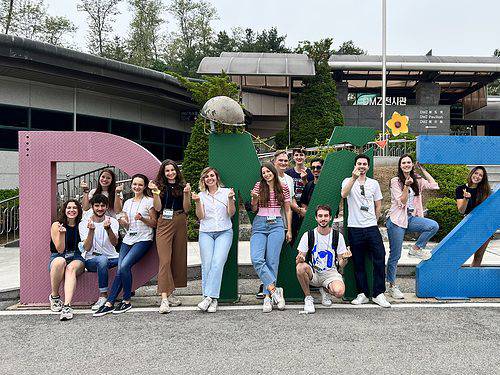
Best DMZ Tour From Seoul (No Forced Shopping)
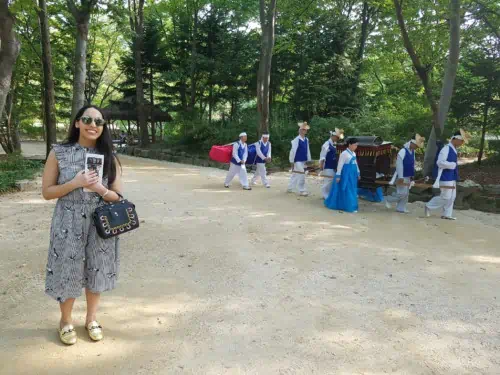
Korean Folk Village tour (Afternoon)
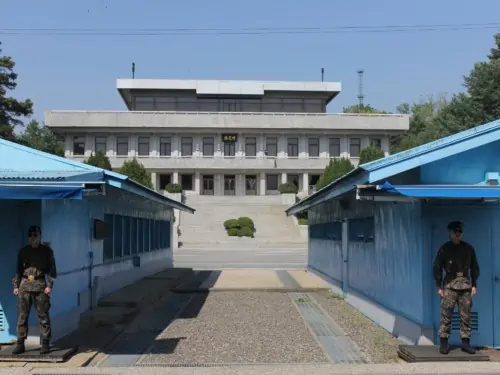
DMZ JSA tour
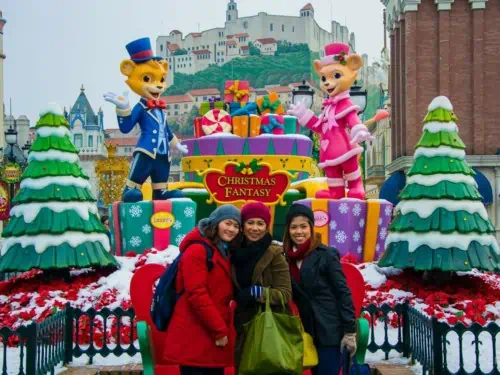
Everland tour (Theme Park Ticket & Transport)
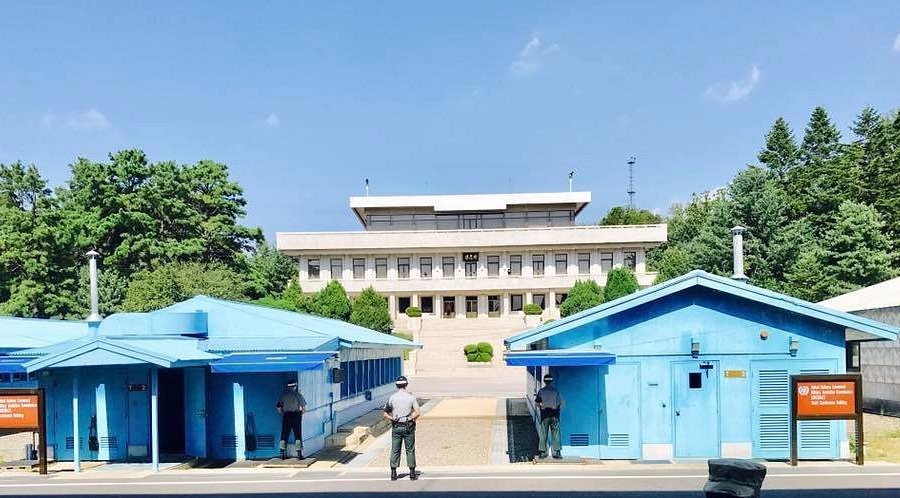
Top ways to experience nearby attractions

Most Recent: Reviews ordered by most recent publish date in descending order.
Detailed Reviews: Reviews ordered by recency and descriptiveness of user-identified themes such as wait time, length of visit, general tips, and location information.
Also popular with travelers
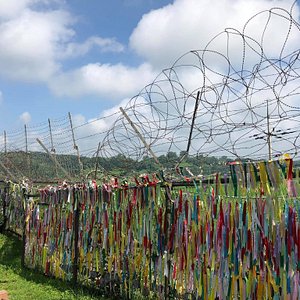
Panmunjom - All You Need to Know BEFORE You Go (2024)
- (6.85 mi) Gaeseong Minsok Ryeogwan
- (6.63 mi) The Guesthouse DMZ Stay
- (8.91 mi) Shwimpyo Paju Guesthouse
- (9.16 mi) Obladi The Resort & Pool Villa
- (9.19 mi) W&J Pension
- (7.32 mi) Bangujeong Naruteo Jib
- (5.73 mi) Korean Restaurant Imjingak
- (5.02 mi) Kaesong Kuksu House
- (5.76 mi) Popeyes Imjingak
- (9.14 mi) Galrilri Farm
- (0.02 mi) Concrete Wall
- (0.03 mi) Demilitarized Zone
- (3.61 mi) DMZ
- (2.98 mi) The Third Tunnel
- (3.62 mi) Dora Observatory

JSA Panmunjom Guided Tour
from ₩95,000/person
- Pickup & Dropoff At Hotel President (Nearest subway is at City Hall Station or Euljiro 1(il)-ga Station)
- Whole Day Tour (09:50am - 4:30pm)
- English Speaking Tour Guide
JSA Panmunjom Program
- Lunch (Beef Bulgogi)
JSA (Joint Security Area)
Visit the only place where North & South Korean forces stand face-to-face and experience the tensions faced everyday at JSA Panmunjom. For the lucky few, you might even get to see North Korean soldiers in patrol too! All the best to you!
Following the signing of the panmunjom agreement for peace, prosperity and unification of the Korean peninsula in 2018 by the North & South Korean presidents, we hope it won't be too long before we could step into North Korea at JSA. Until then, this JSA program is as good as it gets!
JSA (Joint Security Area) Panmunjom
Imjingak park.
- 👤 Minimum age of 11 years old
- Book at least 4 days before the tour day.
- Same price for Adults and Children.
- Available only from Tuesday to Friday, except Monday, weekends and public holidays.
- You are required to provide us with a coloured copy of your passport for booking if you are from the following countries:
Please email your coloured passport copies to [email protected] .
Afghanistan, Algeria, Azerbaijan, Bahrain, Bangladesh, Belarus, Bolivia, Bosnia, Burma, China, Cuba, Egypt, Estonia, Georgia, Hong Kong, India, Indonesia, Iran, Iraq, Jordan, Kazakhstan, Kuwait, Kyrgyzstan, Latvia, Lebanon, Libya, Lithuania, Macau, Malaysia, Moldova, Morocco, Nigeria, North Korea, Oman, Pakistan, Palestinian authority, Qatar, Russia, Saudi Arabia, Singapore, Somalia, Sudan, Syria, Taiwan, Tajikistan, Tunisia, Turkmenistan, Ukraine, United Arab Emirates, Uzbekistan, Venezuela, Vietnam, Yemen
- Tour routes and schedules are subjected to military considerations and changes. In such cases, refunds will not be given if tour is cancelled.
- You must bring along your valid passport on tour day.
- Sleeveless tops, see-through clothes, miniskirts, clothes displaying offensive and huge words, sandals and slippers are not allowed.
- Cameras with over 90mm zooming lens are not allowed. Photography is not allowed except when the tour guide says it is allowed.
- Meeting time could change. Please check your confirmation email for exact meeting time and location.
- Please do not be late as the shuttle bus will not wait for you.
- Itineraries estimated based on smooth traffic conditions. Pickup and arrival times could be delayed due to heavy traffic but we aim to be punctual all the time!
If you are late and you miss the tour, it will be considered as a no-show and refunds will not be issued.
Tour routes and schedules are subjected to military considerations and changes. In such cases, refunds will not be given if tour is cancelled or schedules are changed.
Date change is permitted up to 7 days prior to tour day but is subjected to availability.
Full refunds issued for cancellations made at least 7 days prior to tour day.
No deposit refunds issued for no-shows and cancellations made 6 days or less prior to tour day and on tour day.
Customer's Reviews
We most definitely did not write these ourselves, we promise!
Related Tours
You might be interested in these too!
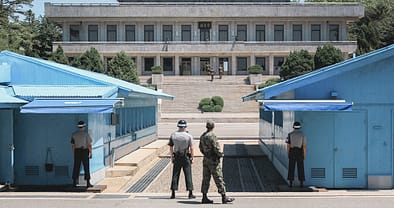
JSA Panmunjom & DMZ Guided Tour
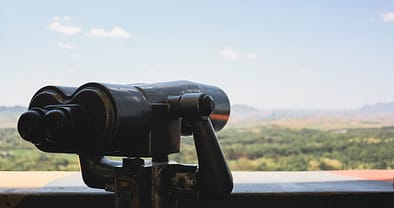
DMZ Guided Tour

Incheon Airport Transfers

- Korean Language Summer Course in Pyongyang
- Dandong DPRK Border
- Shanghai Bike Tours
- TOUR EXTENSIONS
- How to Book a Tour
- Testimonials
- KTG 360°
- Humanitarian Work
- Where to Go
- Tours & Dates
- Hotels in North Korea
- Hotels in Pyongyang
- Travel Insurance
- Transportation
- Interactive Map
- DPRK Information
- Facts & Figures
- DPRK History
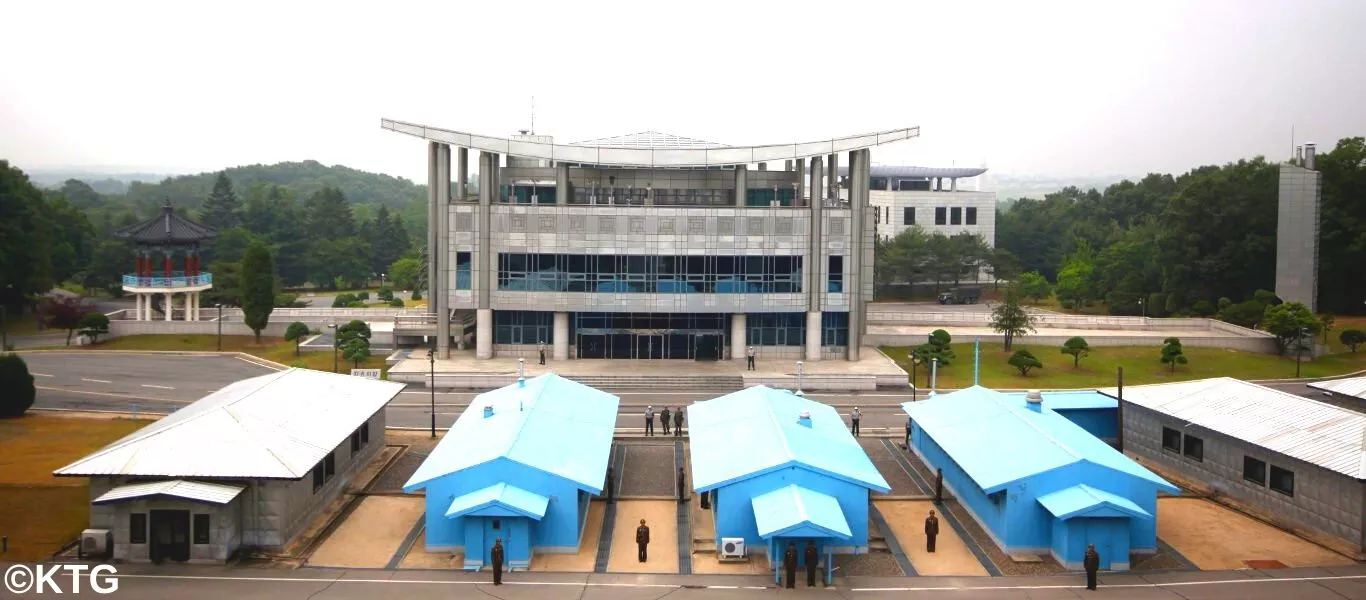
Panmunjom - the scariest place on Earth?
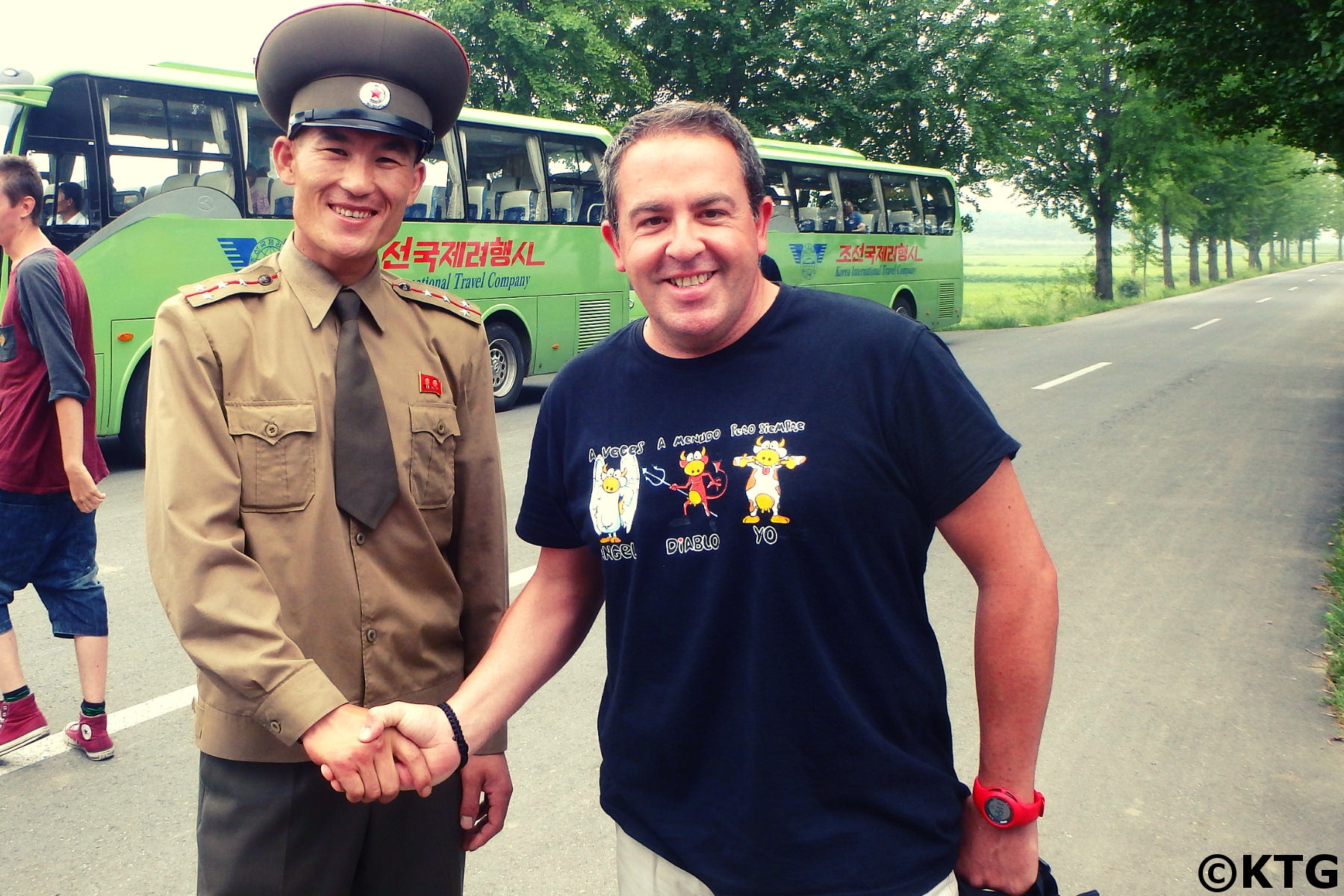
Introduction
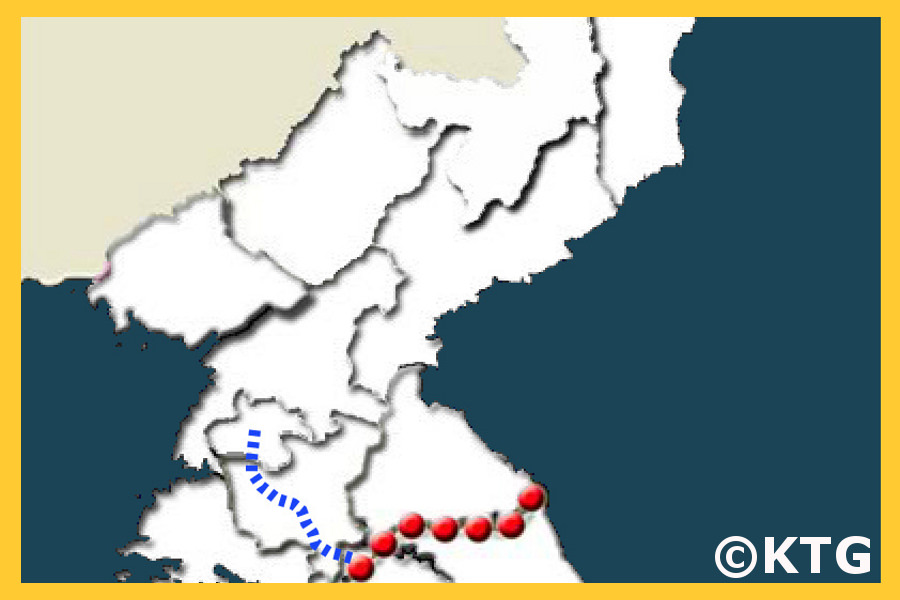
Hall of Armistice Talks
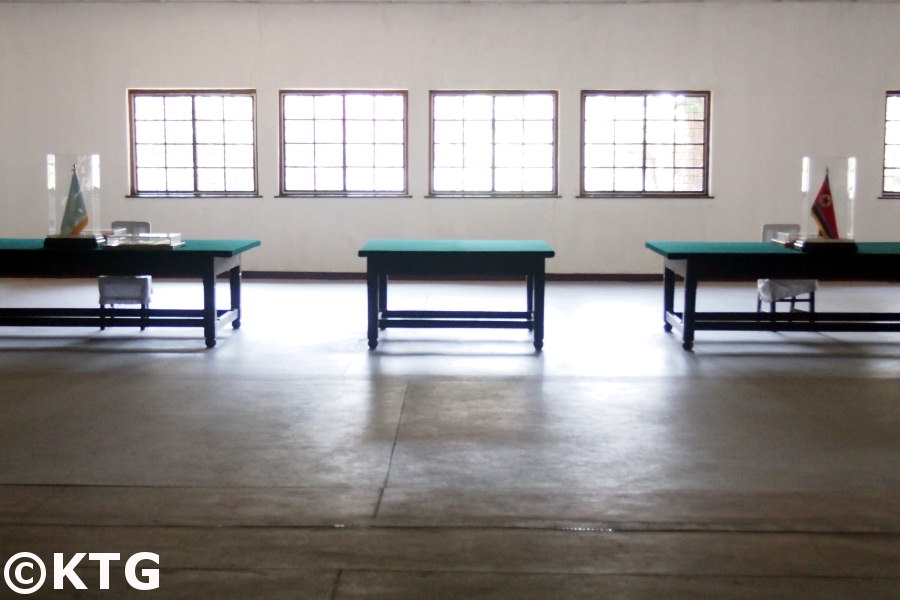
Peace Museum
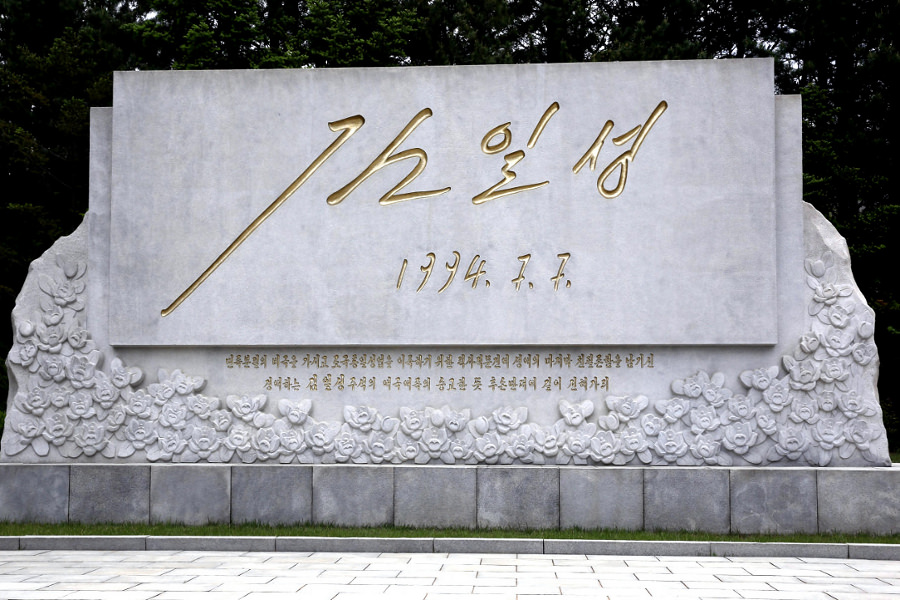
Autograph Monument
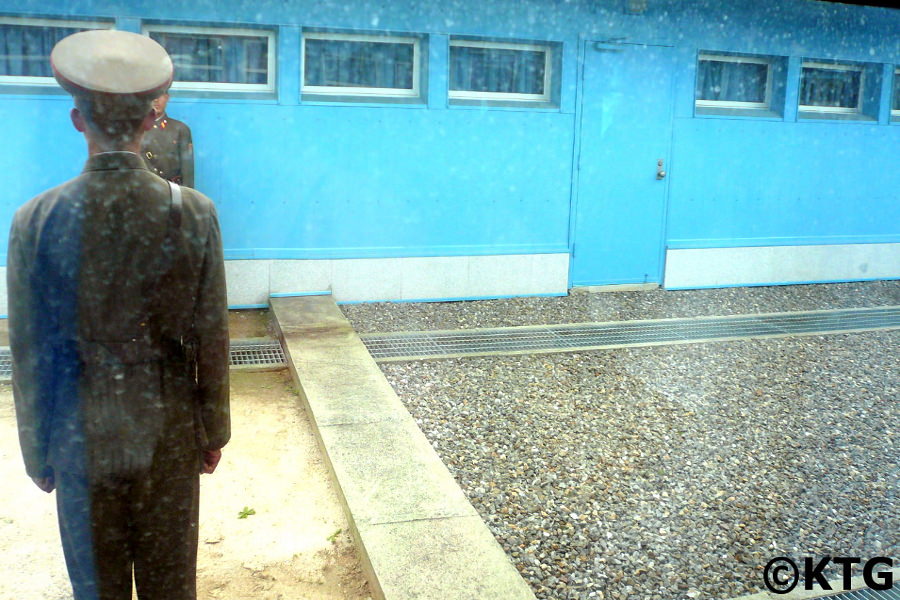
Demarcation Line
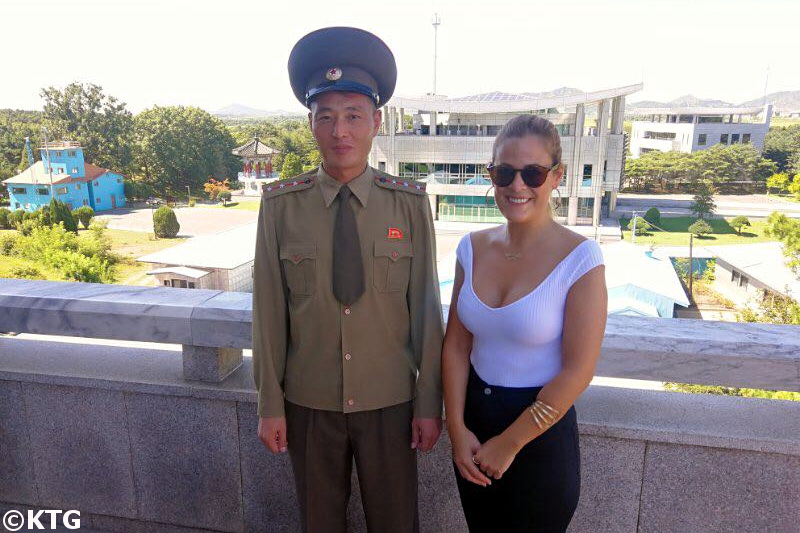
Panmun Pavilion
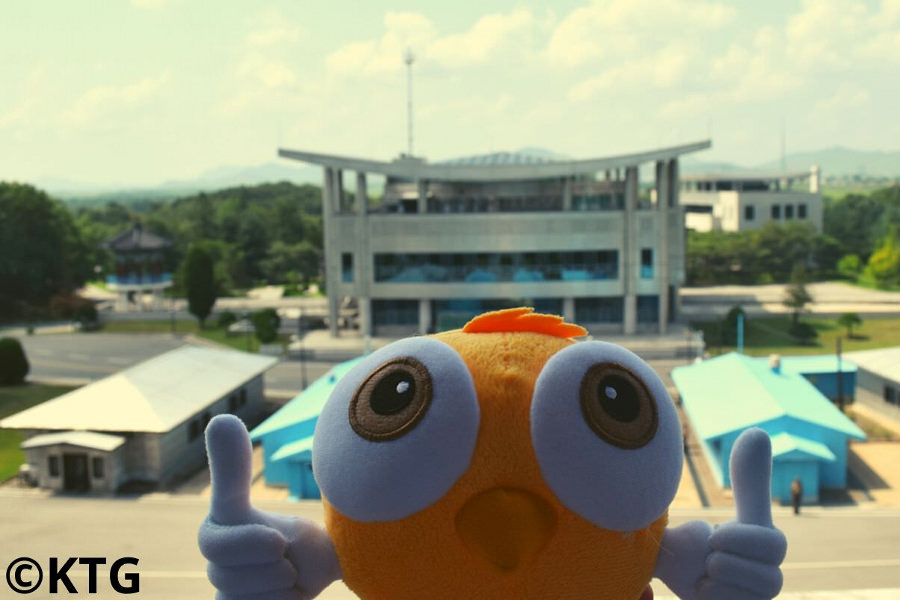
Panmunjom is where the Korean War Armistice was signed in 1953. North and South Korea are still technically at war as peace treaty was never signed.
It was agreed that a no-man's land 4 kilometres wide and 250 kilometres long stretching across the Korean Peninsula would be created. This is known as the Demilitarised Zone (DMZ). The most militarised de-militarised zone and borderline in the world, it was described by former US President Bill Clinton as the "scariest place on Earth".

The scariest place on Earth? KPA officer shakes hands with a traveller from KTG before we move on to the Hall of Armistice Talks.
Panmunjom (Panmunjeom) is the most visited place of the DMZ. Many tours run from Seoul to the Joint Security Area. If joining one of our tours you will have the chance to see the dividing line from "the other side" and hear the North Korean version of the Korean War .
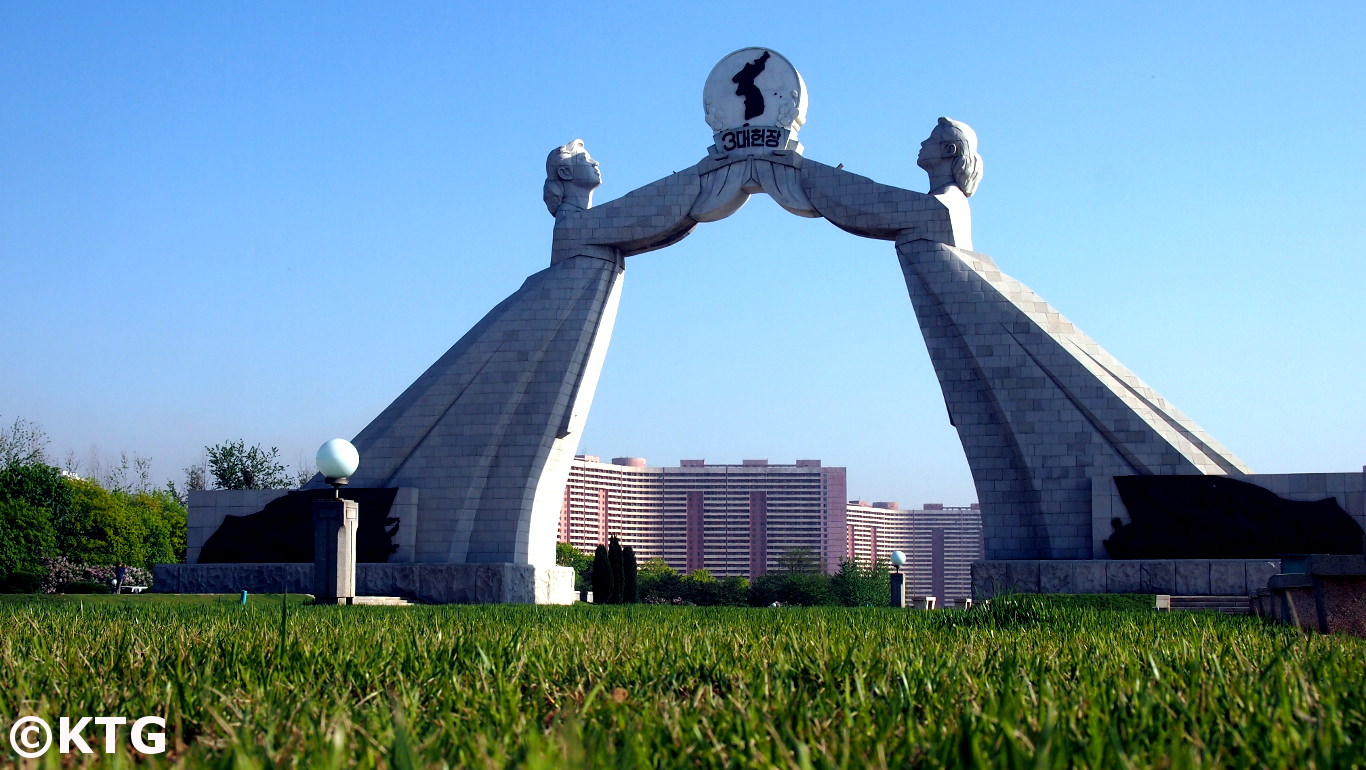
We pass under the Reunification Monument in Pyongyang when taking the Reunification Highway to Kaesong.
Panmunjom is located 168 kilometres south of Pyongyang and just 8 km away from Kaesong city. The ride takes around 3 hours each way.
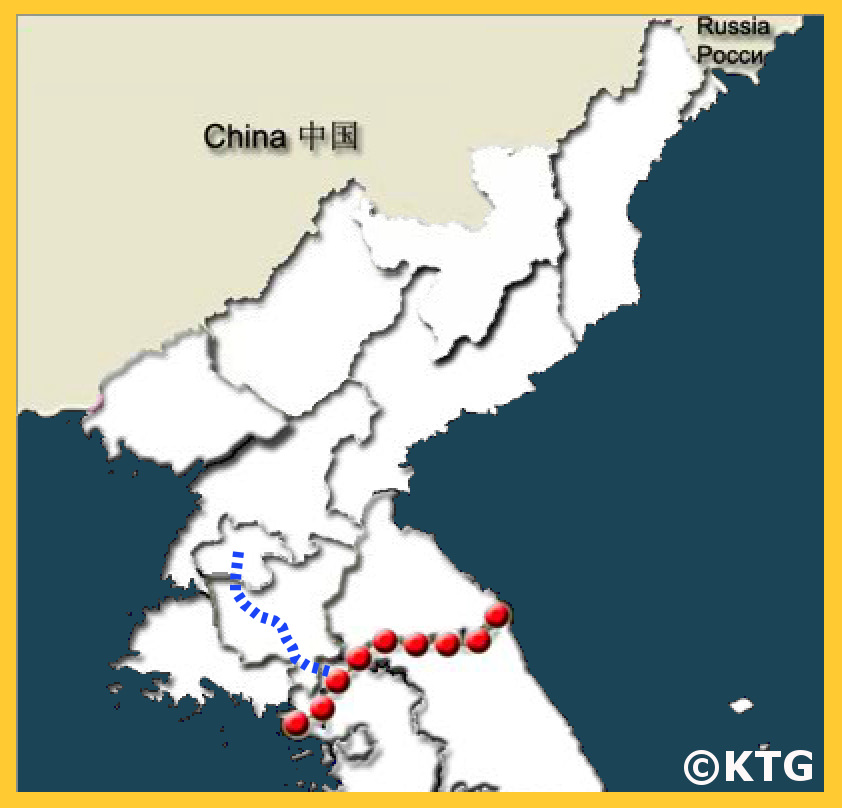
When heading there we have a break at a tea house that is built over the highway that connects Pyongyang to Kaesong; Tongil (meaning reunification in Korean) highway. We usually have a 10 minute break there. You have some coffee, tea, snacks and buy souvenirs too.
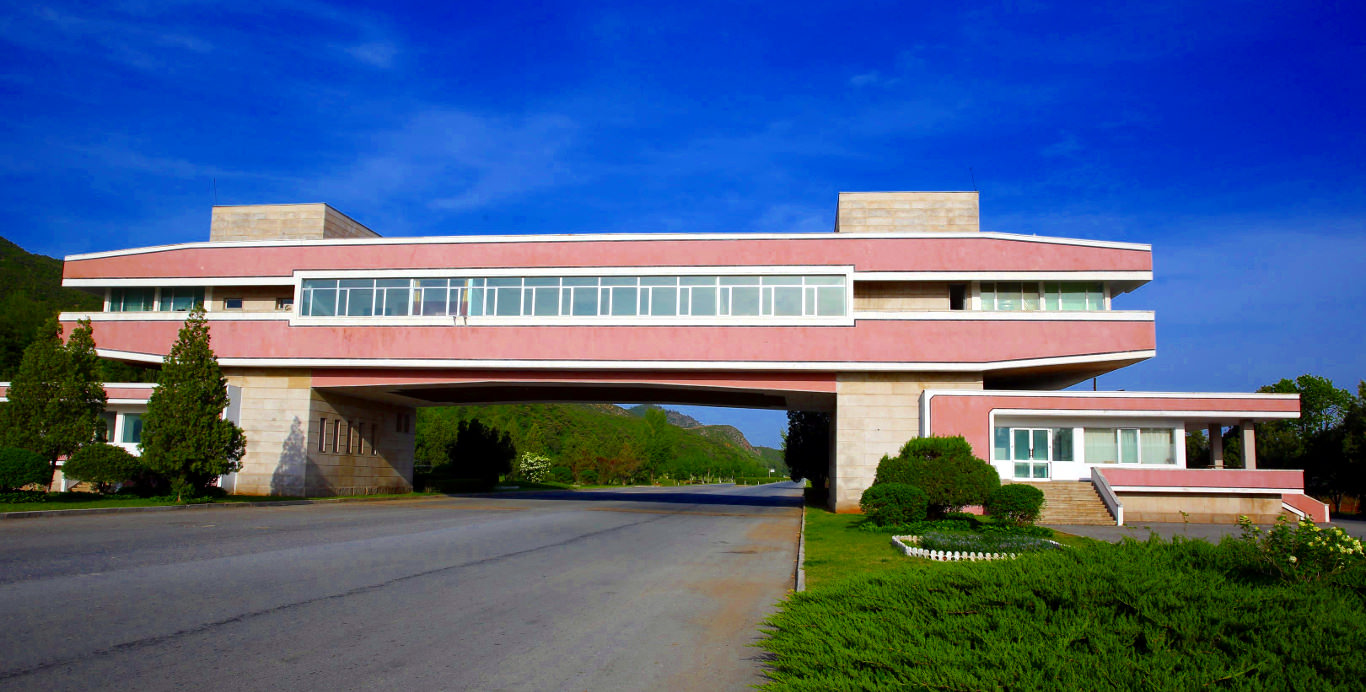
Tip: not many travellers do this, but if you go up the tea house you can get some great shots of the highway! Check our Youtube video below:
Arriving at Panmunjom
Once we arrive at the car park of Panmunjom we get off our bus/car. There is a building to our right and toilettes are on the left hand side.
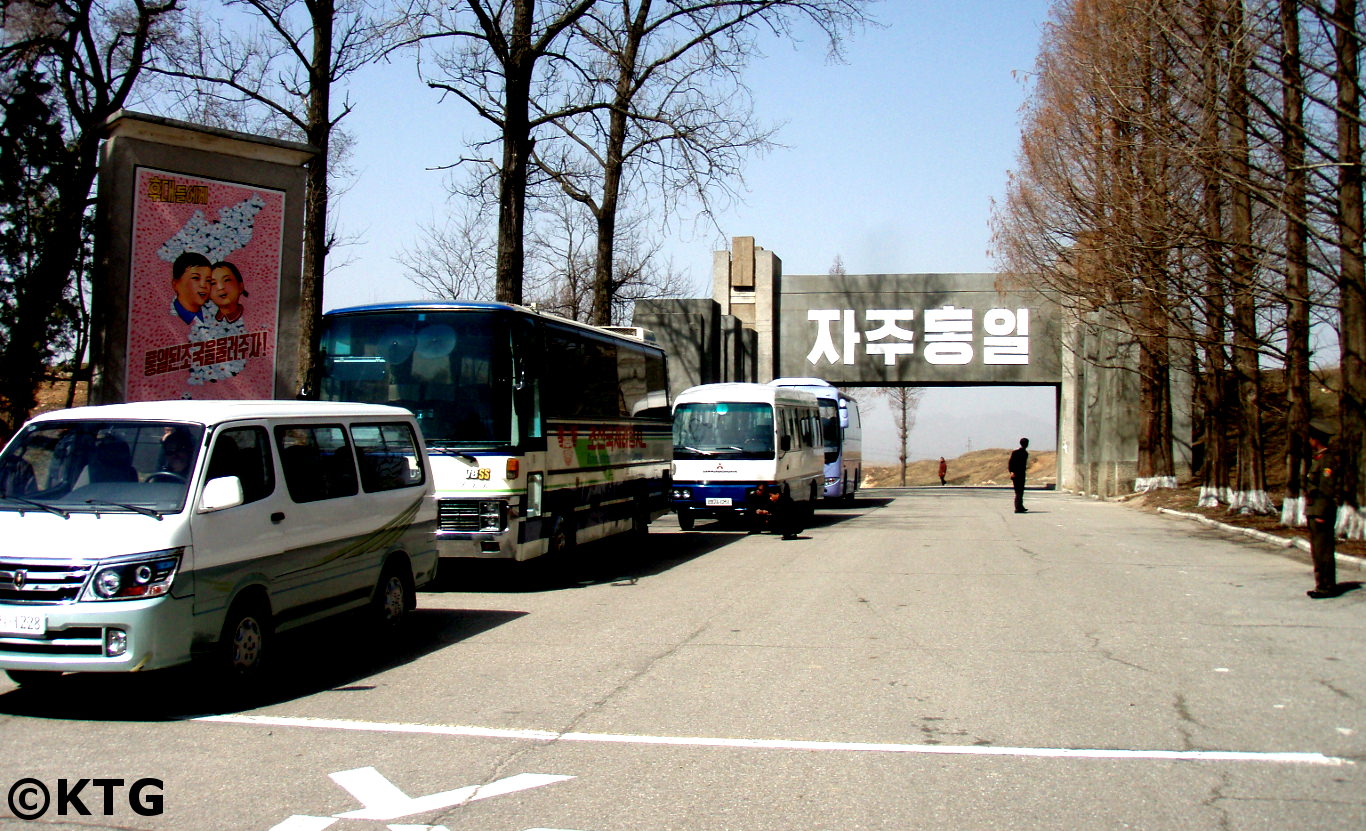
The building to the right consists of a souvenir shop and a room where a soldier will give us a briefing about the Truce Village. After the soldier gives his briefing we exit the room and line up. Each group is then to walk straight, one by one, back on the bus where at least a soldier (sometimes more) will accompany us.
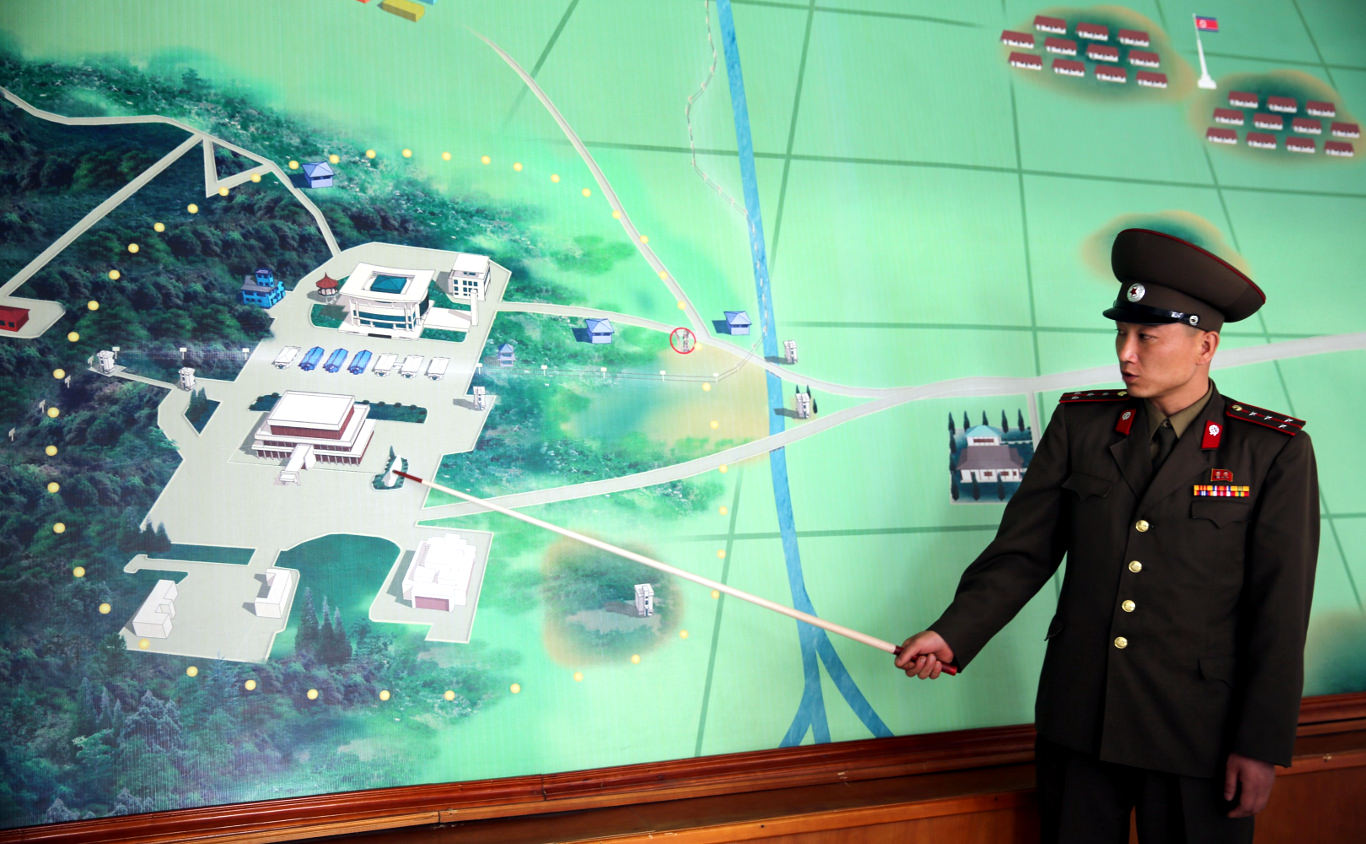
KPA officer briefing us on Panmunjom at the DMZ.
We then drive from there to the Peace Museum which is where negotiations took place during the war. As we head there you can see locals farming the lands and, almost out of nowhere two large flag poles, rising high in the sky, one with a giant DPRK flag and, the one on the South Korean side, with a South Korean flag.
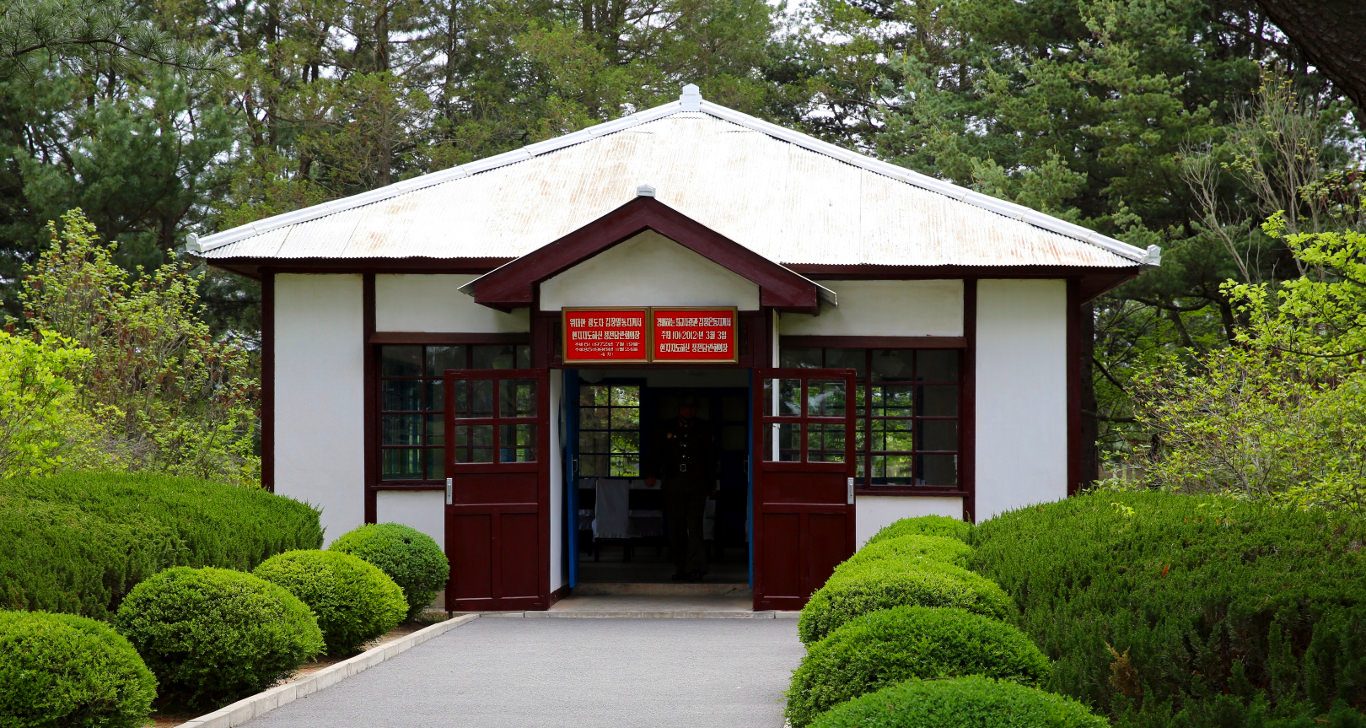
When we get off the bus we will have to line up again and the soldier will guide us. We see where negotiations between the DPRK and US led forces took place. The original tables and chairs are still there.
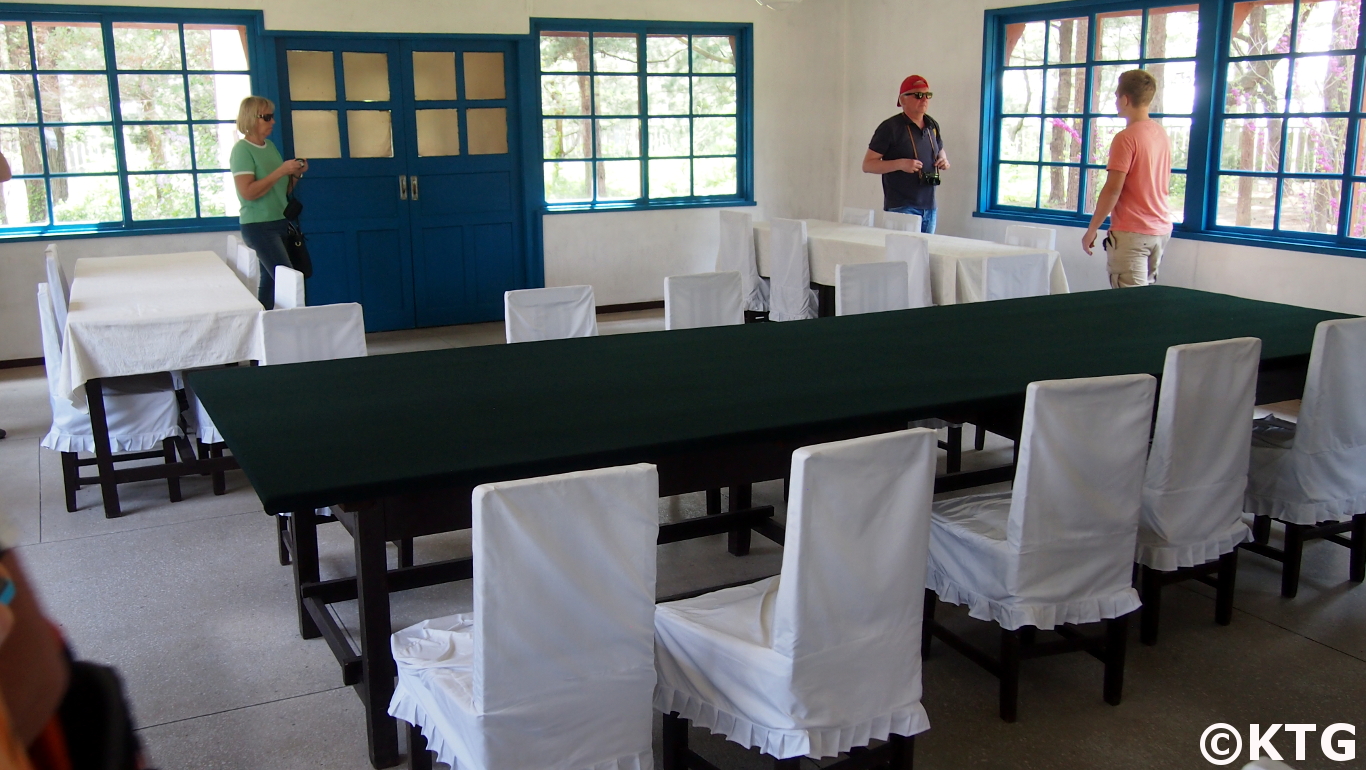
Peace Museum (평화박물관)
Next is the museum where the armistice was signed. You can see the original UN flag used as well as pictures and weapons related to Panmunjom.
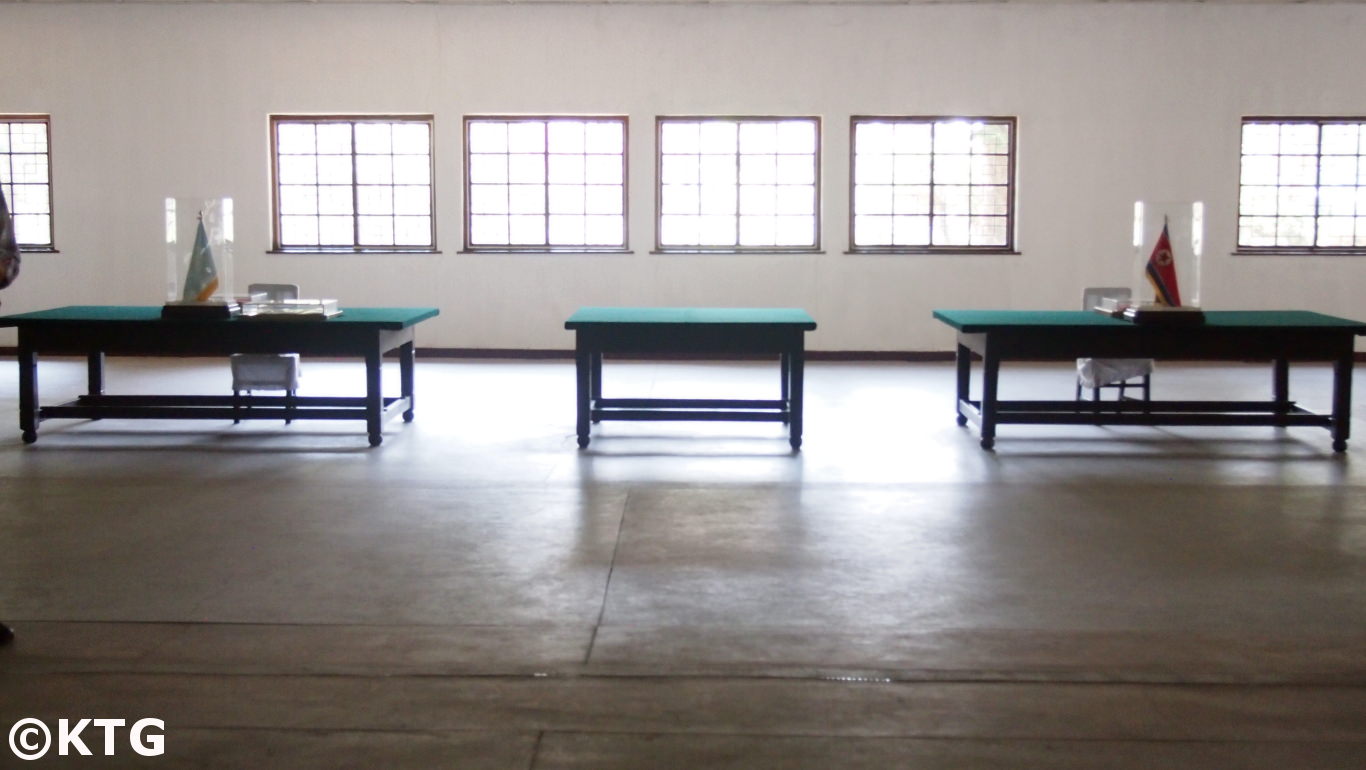
The Korean War Armistice room can be seen in the image above. It was built in only 5 days by the North Koreans who refused to sign the armistice agreement in a temporary tent as suggested by the US. This hall had 900 square metres and is where the armistice agreement was finally signed. The original UN flag, tables and chairs used are preserved in this hall.
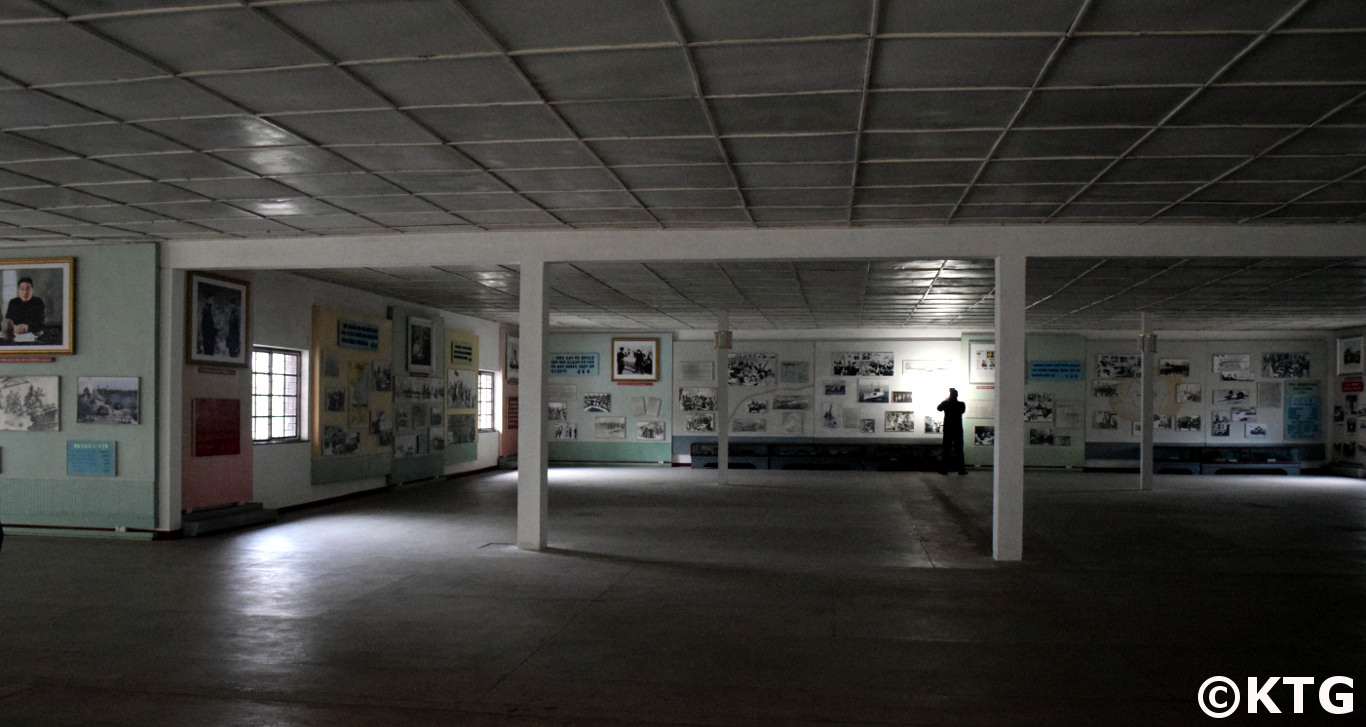
Pictures and weapons can also be seen in the Peace Museum.
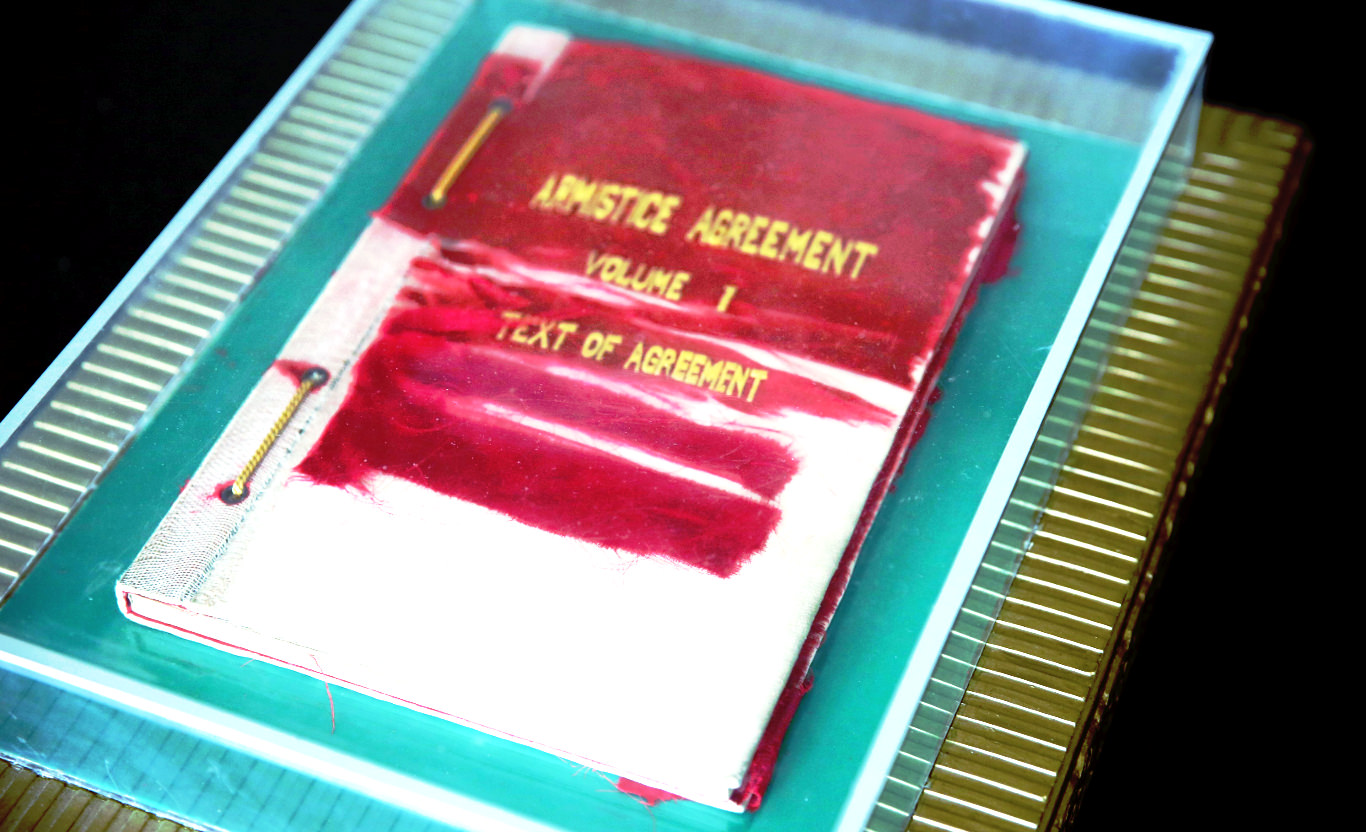
The Korean peninsula witnessed the first Cold War armed conflict , involving North and South Korean, US, UN and Chinese troops. The peace treaty between the North and South has not yet been signed, making this conflict longer than its origin.
Monument to President Kim Il Sung’s Autograph
We hop back on the bus and continue the tour. The first stop here is the Monument to the autograph of President Kim Il Sung. The soldier guide will explain that this autograph is a replica of President Kim Il Sung’s last signature where he expressed his wish of reunification of North and South Korea.
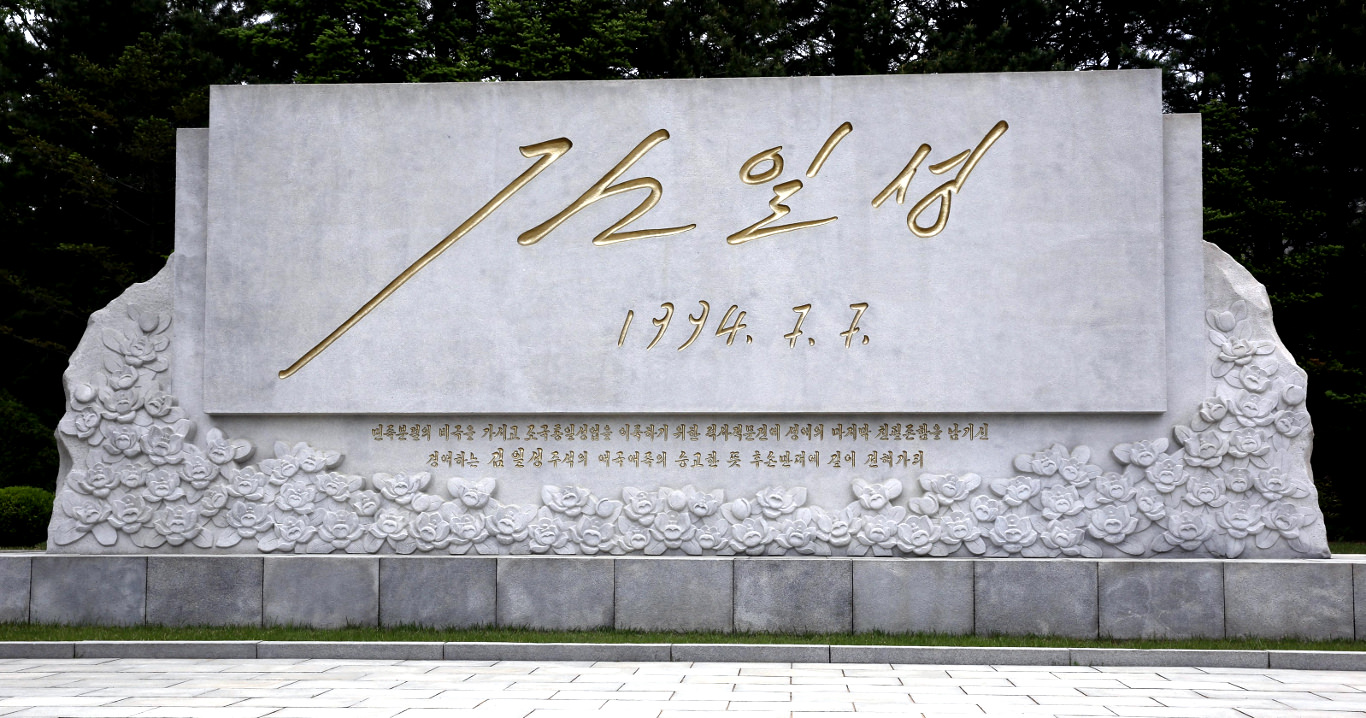
Military Demarcation Line
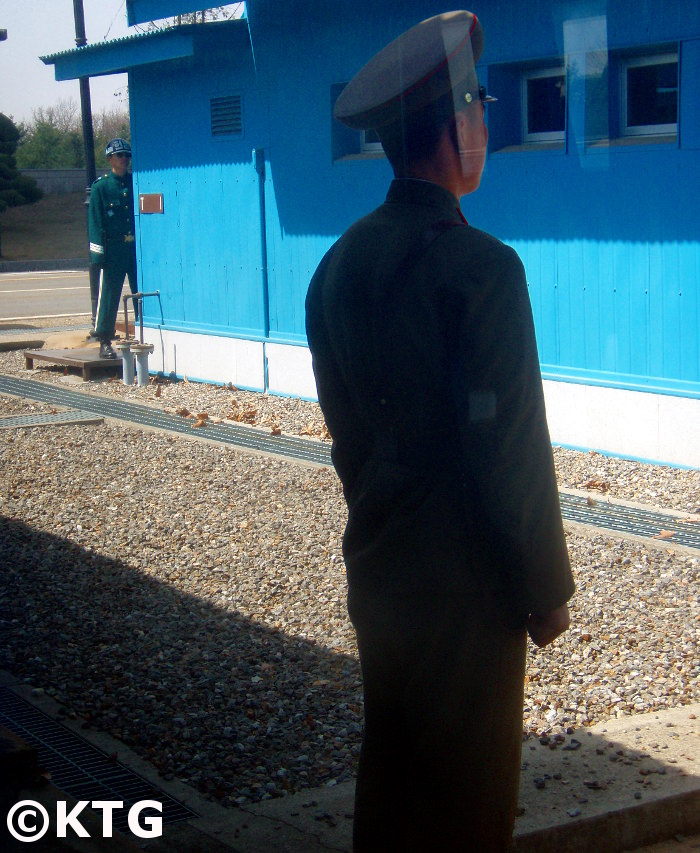
We keep walking towards the demarcation line and, all of the sudden, we are face to face with the blue negotiation rooms that sit on the line that separates both Koreas, the famous Freedom Building in South Korea in the background. Here we are, what many describe as a trip highlight; the Military Demarcation Line.
DMZ North and South Korean soldiers seen in the picture. Despite the signing of an armistice, there is no peace treaty. As a result the two sides are still technically at war.
The concrete slab shown below separates the Korean Peninsula and only a few meters separate the North and South Korean soldiers. Tension is sometimes almost tangible here. We have seen for instance DPRK soldiers walk close up to the concrete slab and take pictures of their South Korean counterparts who were showing US military personnel around.
Armed conflicts have sporadically taken place since 1953, though these have decreased in the past few years.
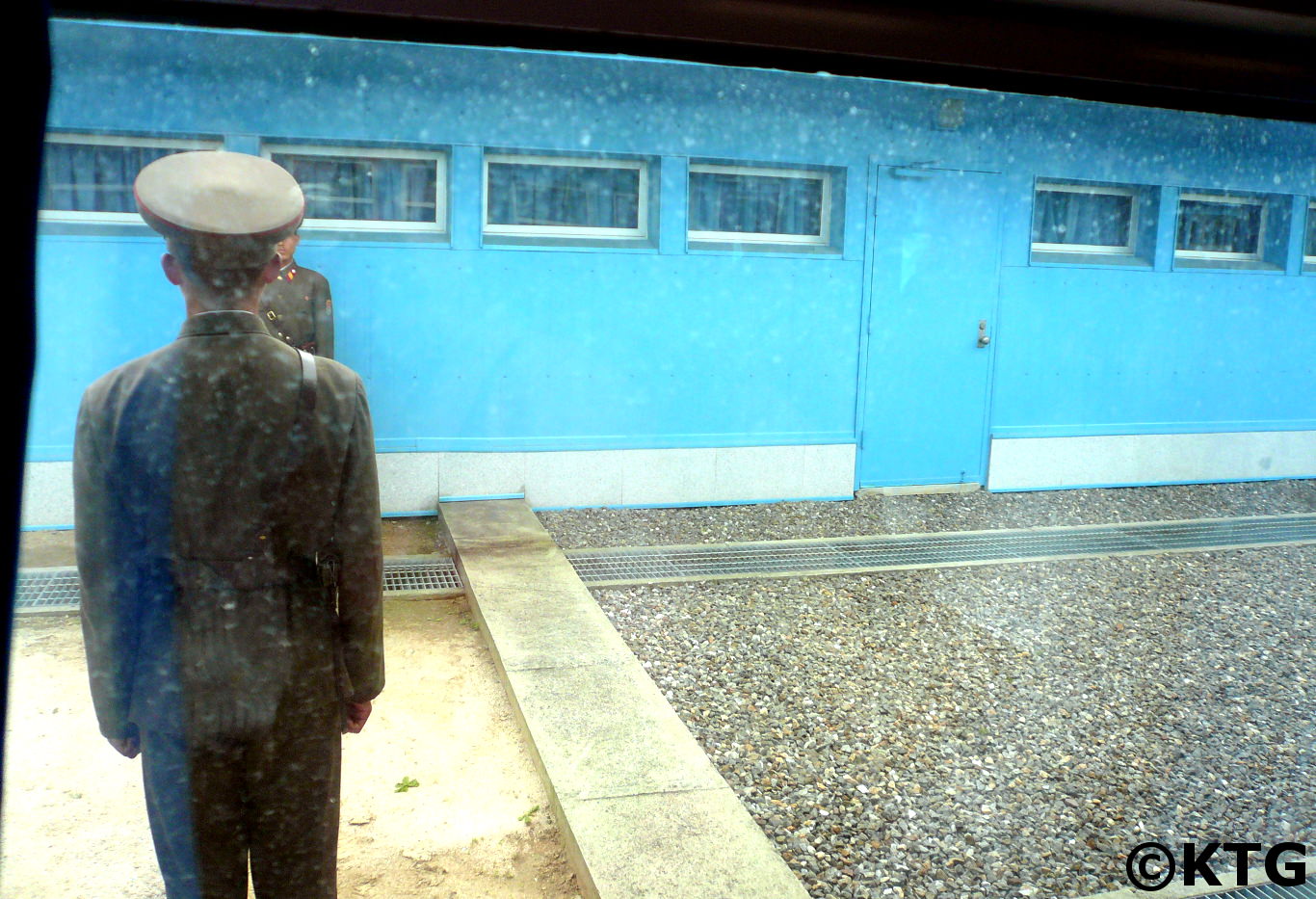
North and South Korean soldiers take turns in entering the Military Armistice Commission building that runs on the concrete slab that divides the peninsula into two places with completely different political ideologies.
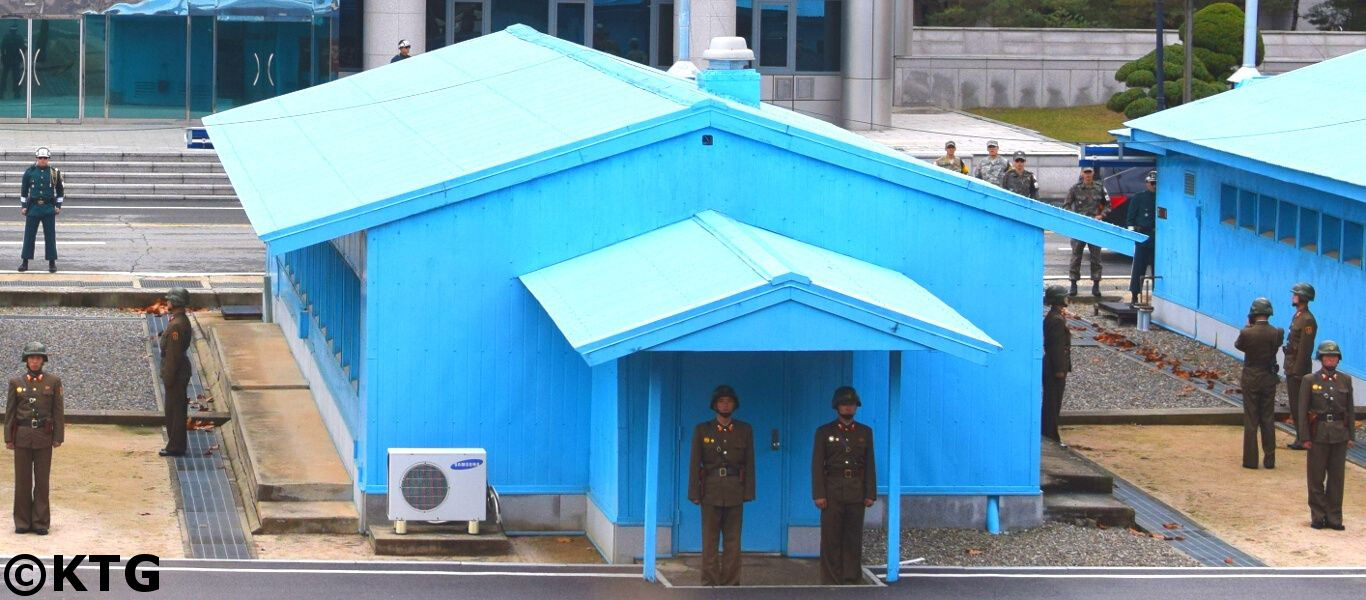
Tension? Notice the North Korean soldiers on the right side of the image taking pictures of South Korean soldiers just a few meters away from them.
South Korean soldiers and tourists visiting from South Korea can be sometimes seen too.
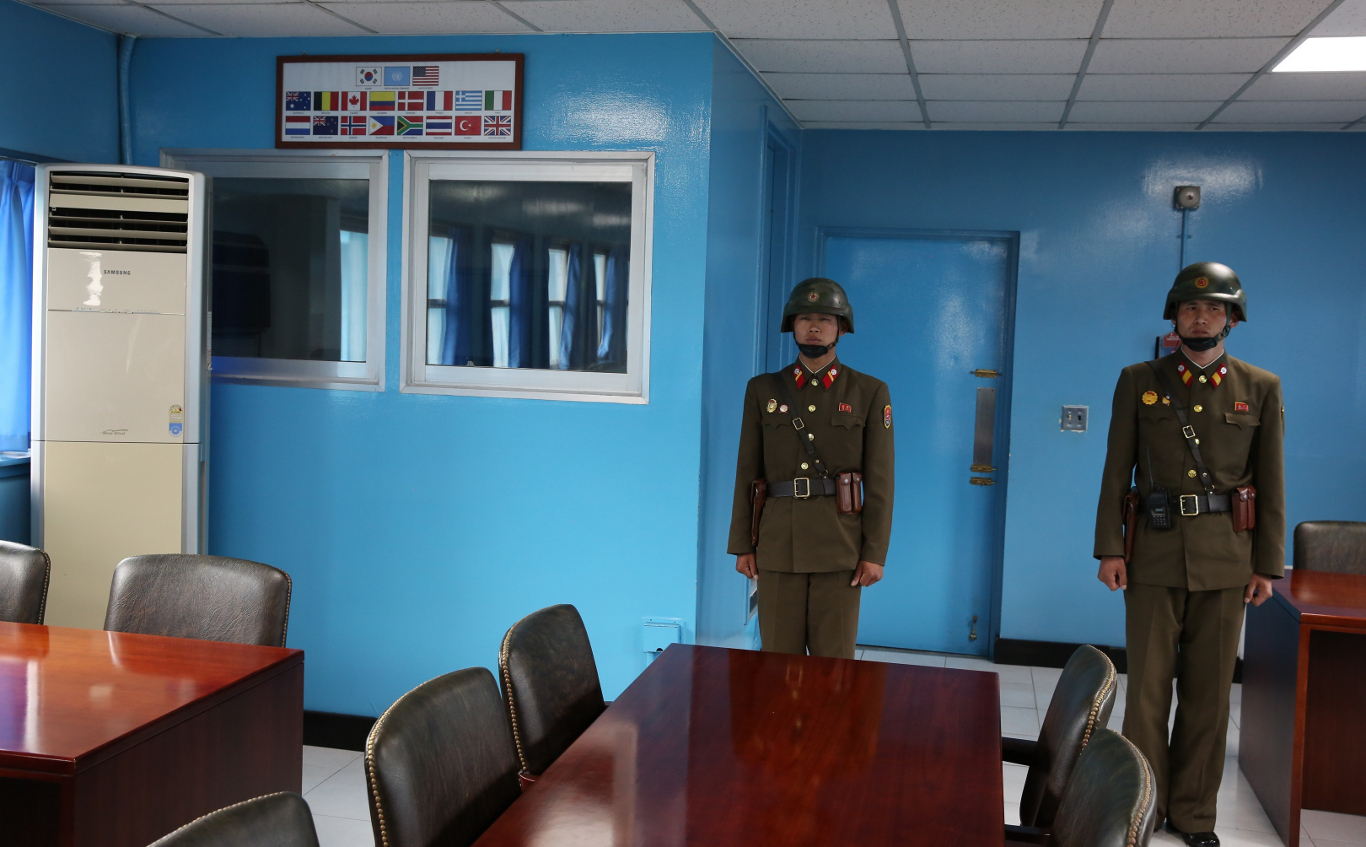
Panmunjom - North Korean soldiers cover the southern door of the building that crosses the demarcation line. They are literally standing in South Korea.
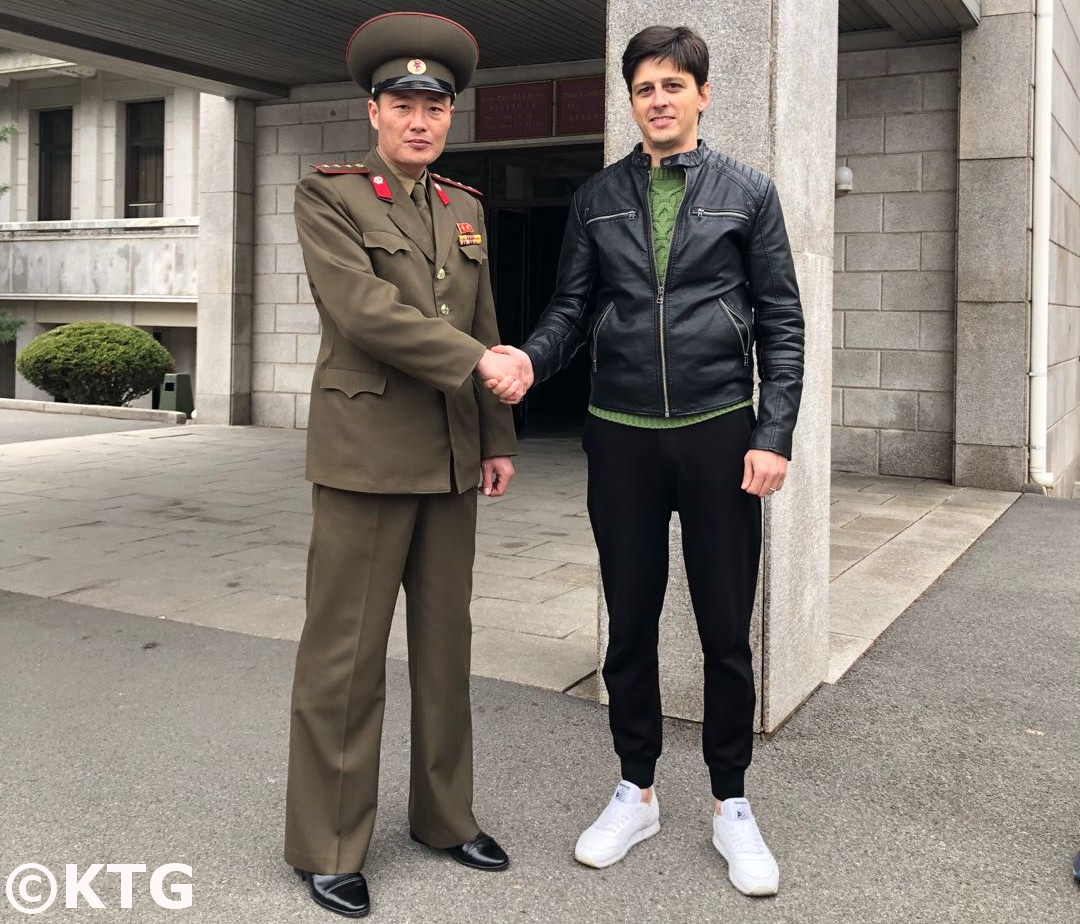
KPA officer shakes hands with Rayco from KTG outside the Panmun Pavilion in Panmunjon
We are absolutely not allowed to cross this line (except for when inside the blue negotiation room when you can go to the other side of the table which is technically in South Korea). It is common for soldiers from the South to glare through the window when visitors from the North come in and vice versa. There are microphones in the room which also mark the dividing line. They record 24/7.
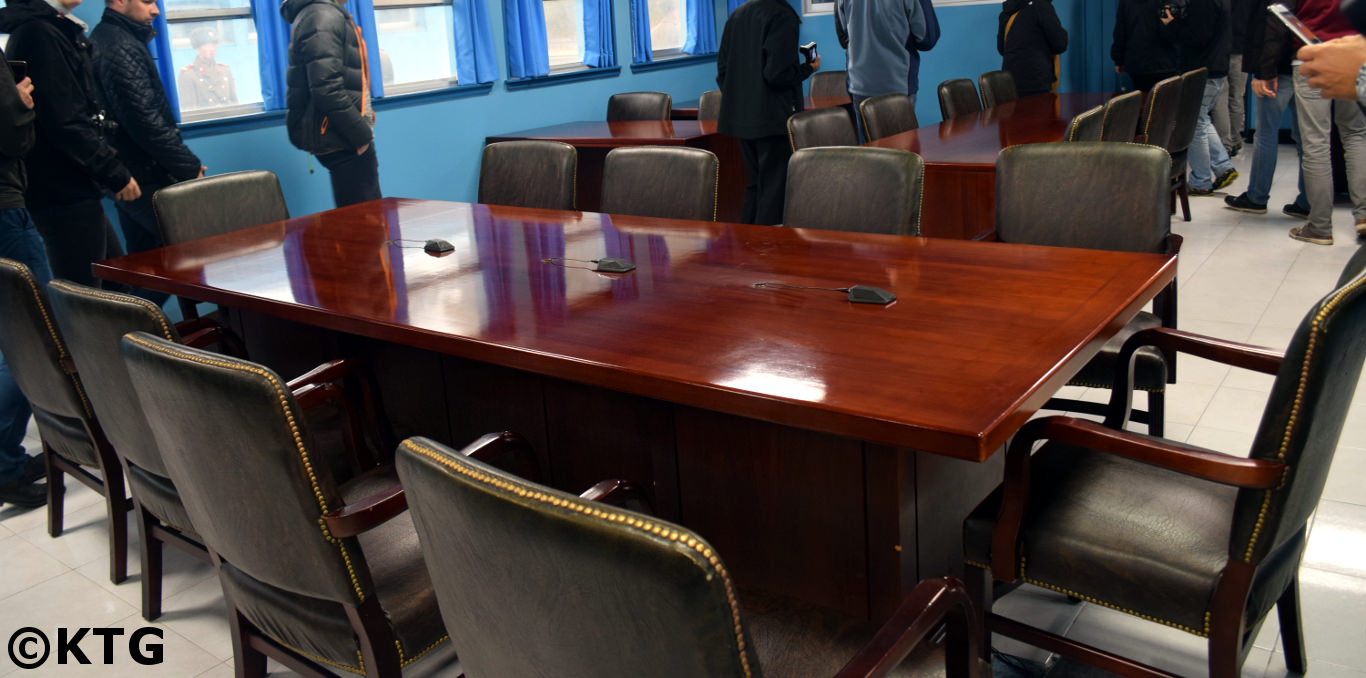
Panmunjom Military Demarcation Line - this microphone line divides the two Koreas; a line that has divided the peninsula and one same people for decades.
After staying here for a while you will be escorted out of the blue building and the North Korean soldiers will leave too locking the Northern door (where you come in and out the building) and South Korean soldiers will enter if they have a group. Then two of them will stand in front of the northern door. It has become less common in recent years to be able to see tourists coming in from South Korea when we go to the DMZ and we have been told that visits from the South are arranged at different times now. Please bear in mind that visitors are not allowed to step behind these soldiers.
Panmungak (Panmun Pavilion, 판문각)
We then head to Panmungak, the building facing the negotiation rooms, to have a clear view of the Military Demarcation Line. It's a great place for pictures! It was built in 1969. In South Korea they have the Freedom House which you will notice is full of CCTVs.
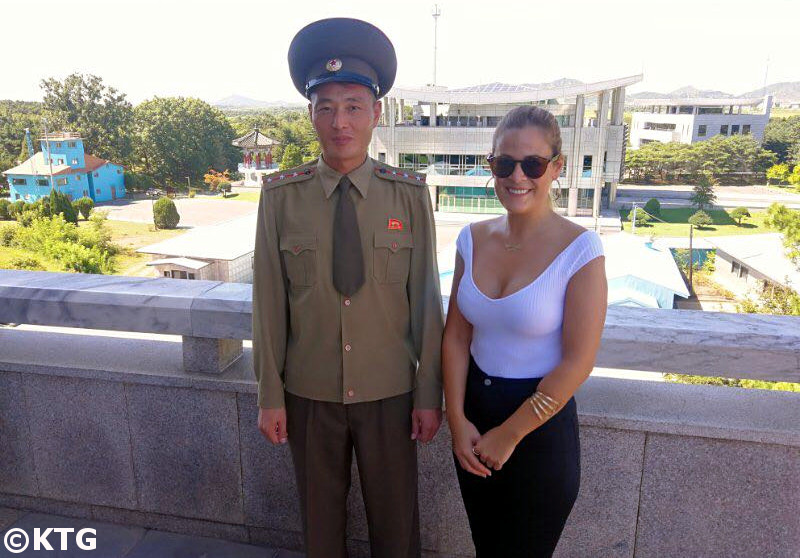
DMZ tours - North Korean soldier poses with a KTG traveller at the terrace of Panmungak across from the demarcation line that divides the peninsula into two.
Wildlife in the DMZ
The DMZ is 250 km long and 4 km wide, running roughly across the 38th parallel from the east coast to the west coast of the Korean peninsula. People are not allowed in the DMZ (apart from in Pamunjom and on the Donghae Bukbu line on the east coast) and as a result this buffer zone has become a wildlife reserve.
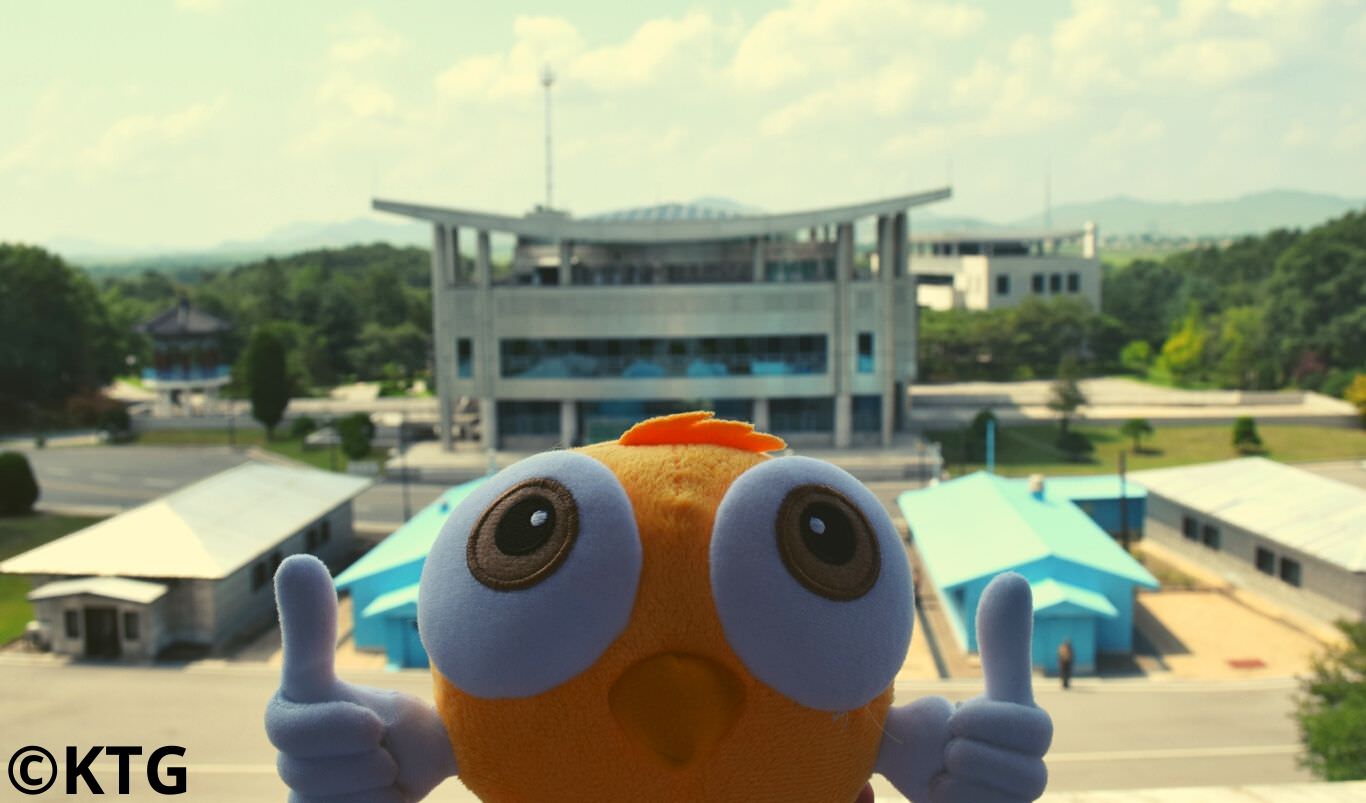
First Canary Bird at the DMZ?
Canary birds aside, and on a more serious note, animals that were about to be extinct, such as the Korean wild boar, many birds such as the black-faces spoonbill, have flourished these past decades at the DMZ. Some scientists even believe to have found traces of a Korean subspecies of the Siberian Tiger .
Related pages:
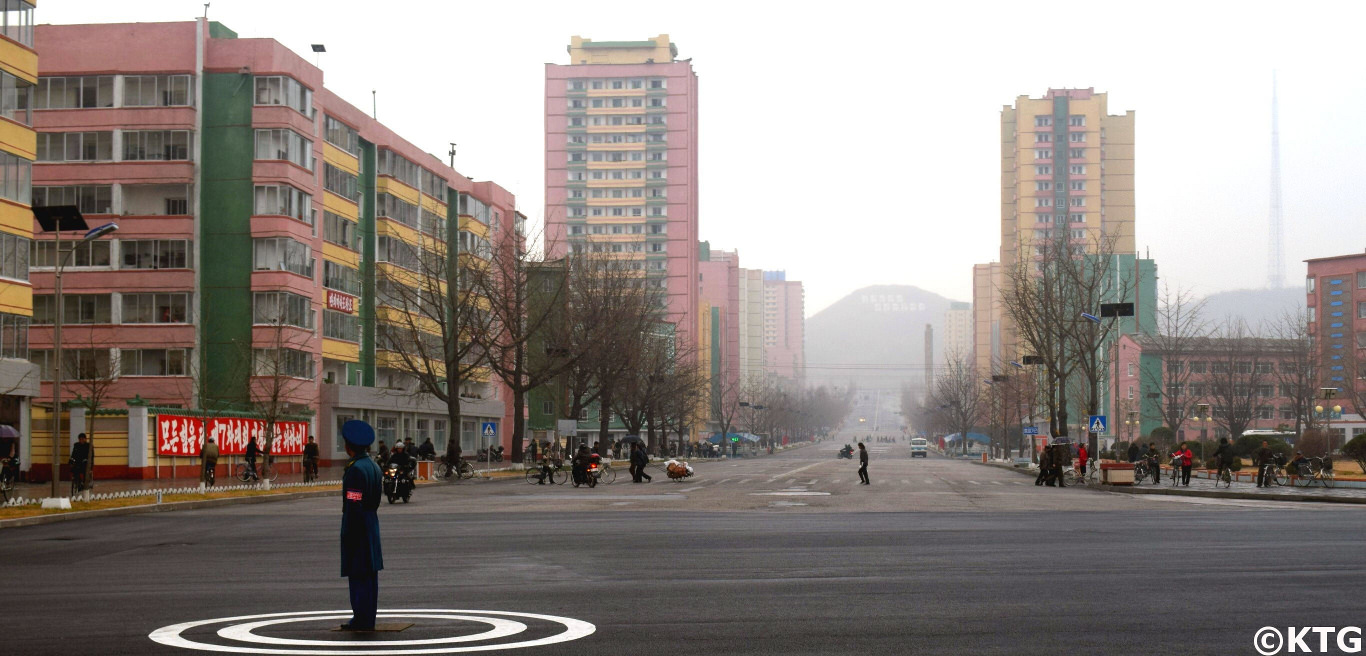
Kaesong North Korea | KTG® Tours' Ultimate Travel Guide
Kaesong North Korea Travel Guide | KTG® Tours | Ancient Treasures, Dog Meat Soup and the Cold War... located 8 km north from the DMZ (Pamunjom) in North Korea. Our North Korea tours include stopping at this historical city, capital of Koryo; the first unified state on the Korean peninsula
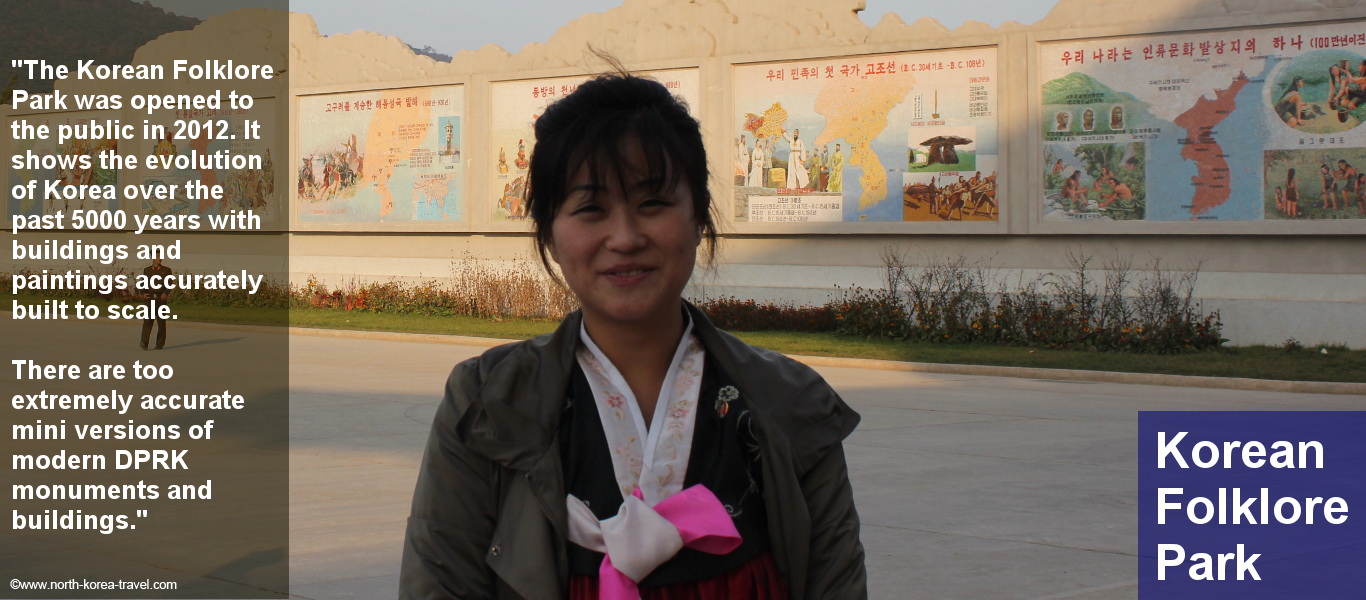
North Korea History - Information on the DPRK & North Korea Tours
North Korea History - information on the history of north korea. North Korea Travel provides budget north korea tours & north korea information which will be handy when traveling to the DPRK.
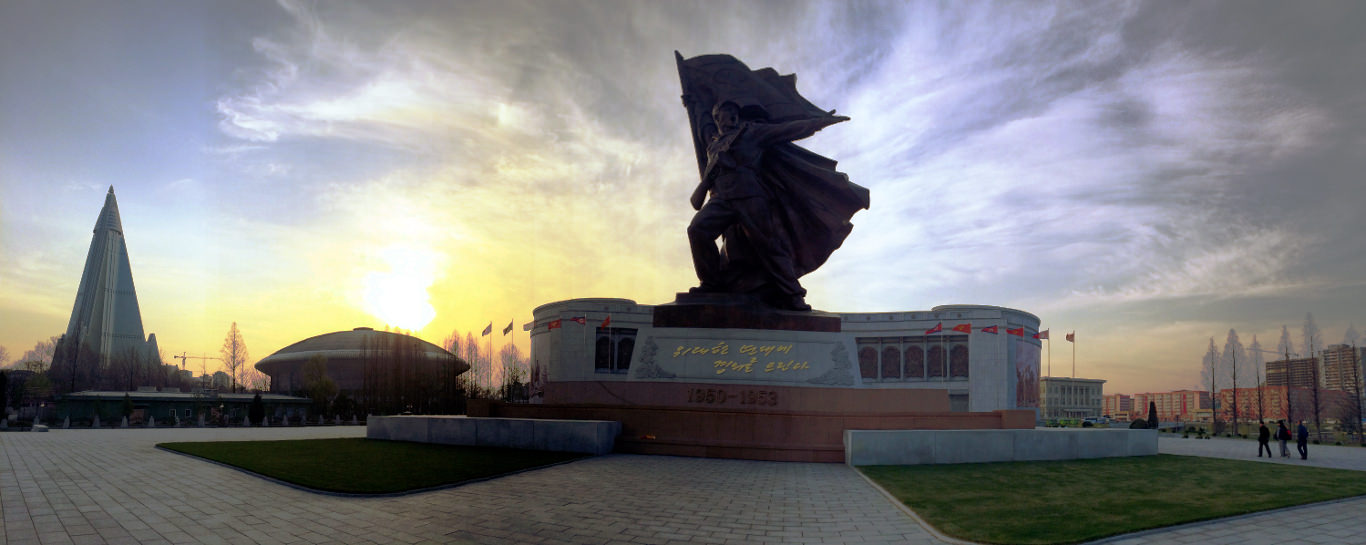
North Korea Museums | KTG® Tours | The Victorious Fatherland Liberation War Museum, Pyongyang
North Korea Museums | KTG® Tours | The Victorious Fatherland Liberation War Museum is in Pyongyang and has extremely vivid illustrations, weapons used during the Korean Civil War (1950-3) and scene reconstructions
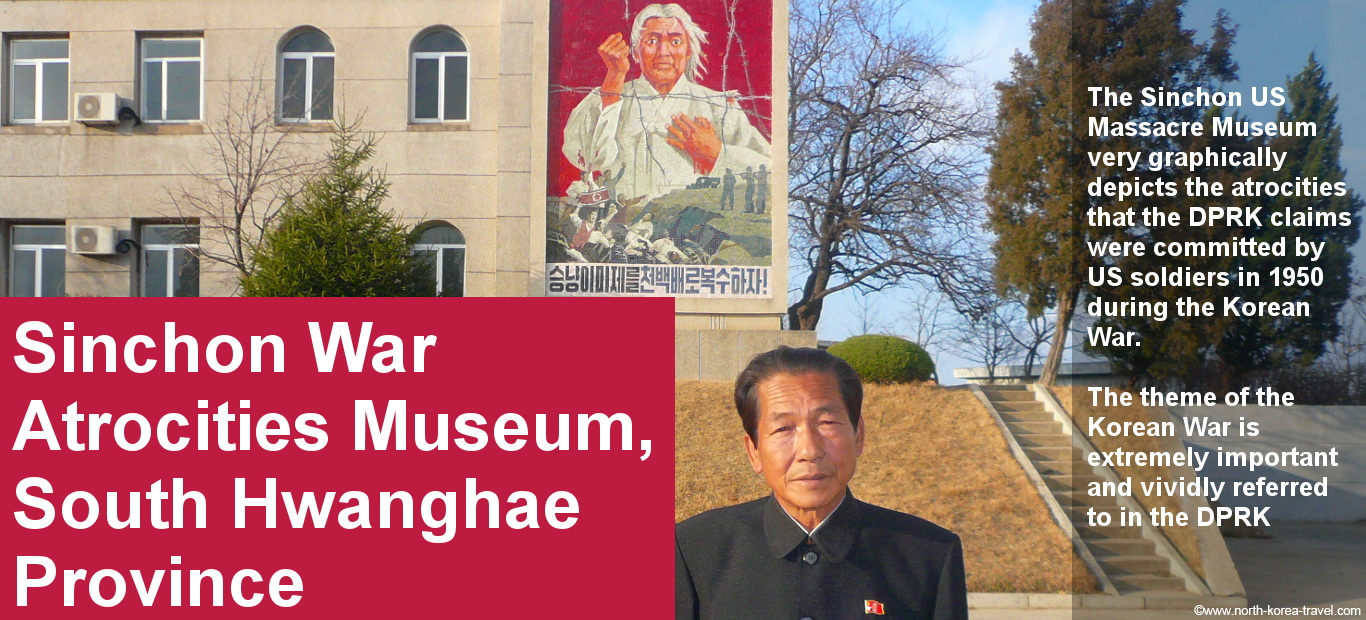
Sinchon | KTG® Tours | US War Atrocities Museum in North Korea's (DPRK) South Hwanghae Province
Sinchon | KTG® Tours | is a county in South Hwanghae Province in North Korea. The US Massacre Museum graphically displays crimes reportedly committed there by American soldiers on Korean civilians in the Korean War
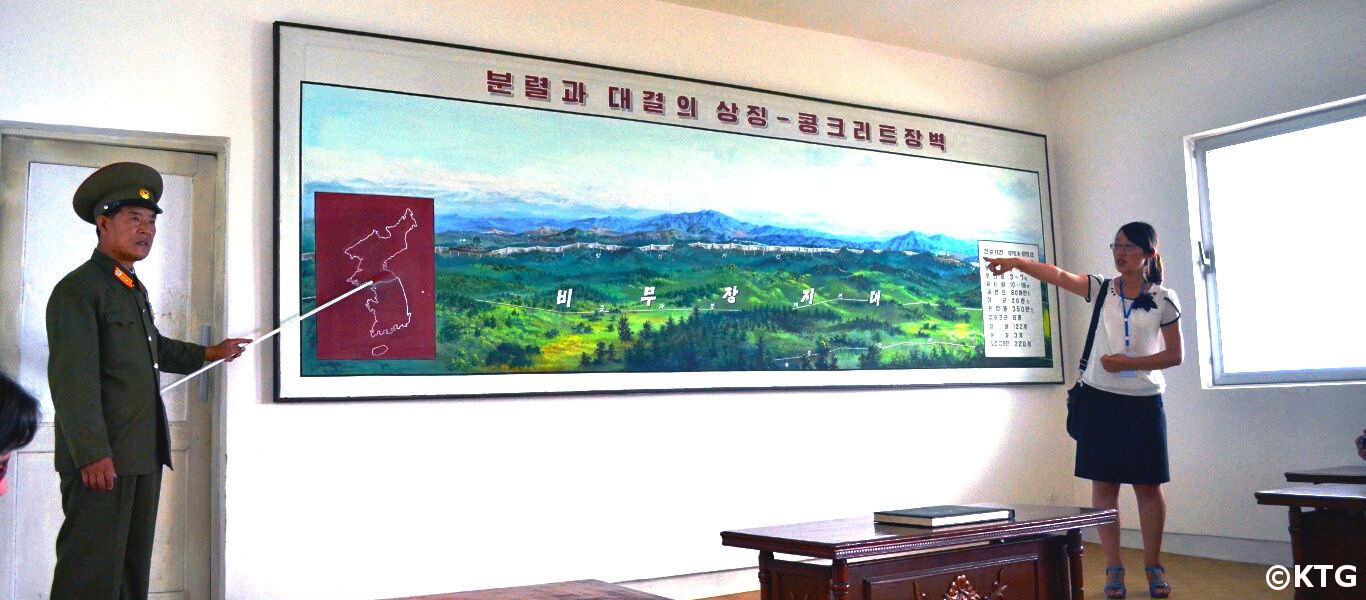
Concrete Wall Kaesong, North Korea | KTG® Tours' Ultimate Travel Guide
The Concrete Wall (Kaesong, North Korea) | KTG® Tours | A Symbol of Division and Conflict. A North Korean military officer waits for us at a remote military post 27 km east of Kaesong. He will explain to you how this wall literally cuts through the Korean peninusla, running parallel to the DMZ
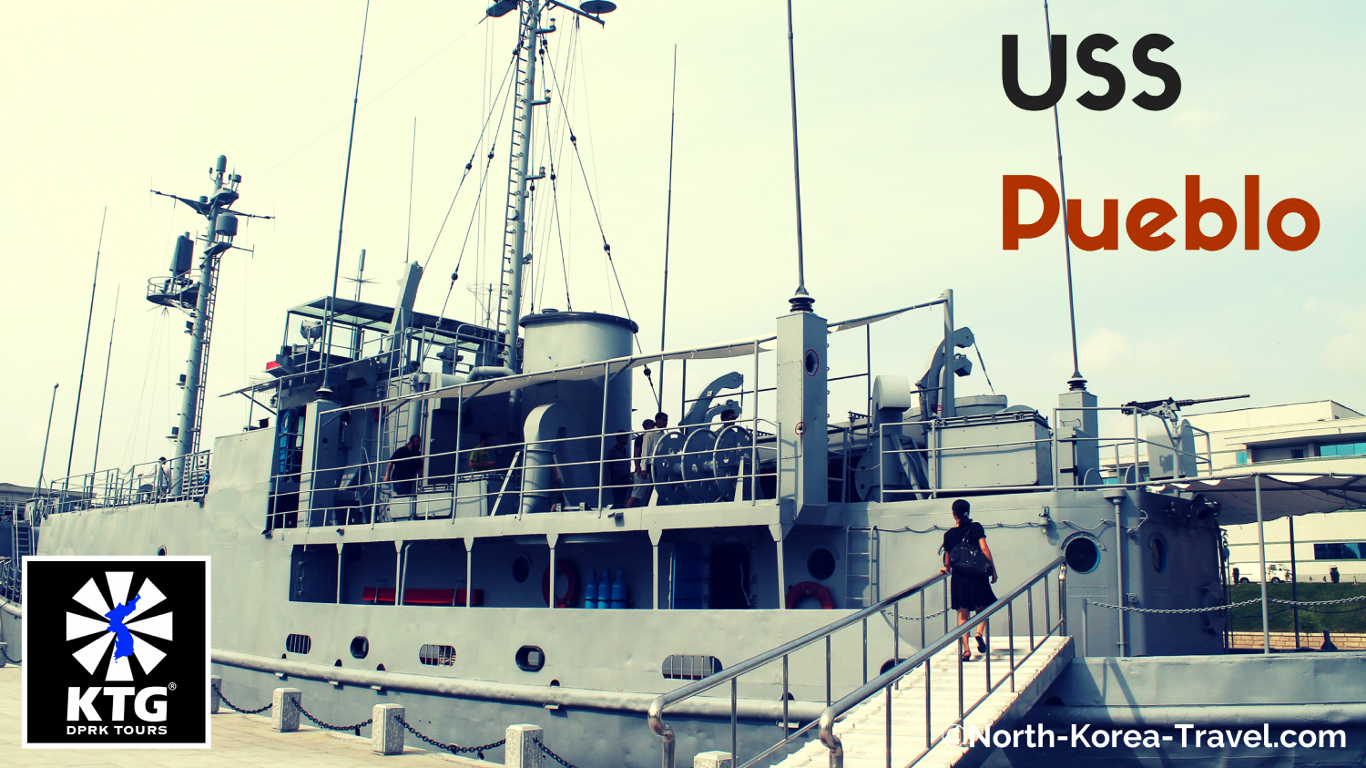
USS Pueblo - KTG - US Ship located in North Korea
USS Pueblo - KTG Tours - US ship captured by North Korea in 1968. See the USS Pueblo by the Taedong river in Pyongyang with KTG, offering budget North Korea Tours
Please click here to see what other areas you will be able to visit other than Kaesong while visiting North Korea.
- Privacy Policy

Welcome Guest
Dmz tour from seoul with jsa panmunjom and 3rd tunnel visit with expert guide.
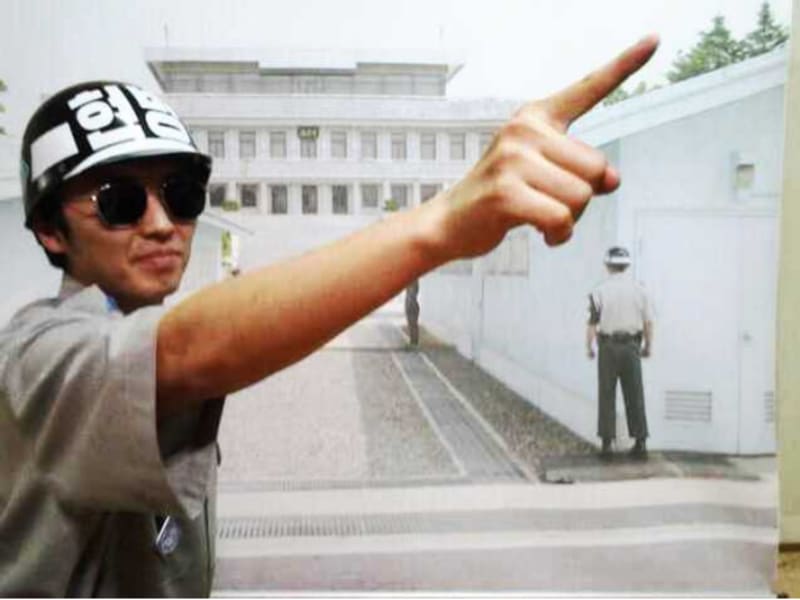
DMZ observation tower tour
Very pleased, pick-up not available, what to expect, travelers interested in this activity also viewed, traveler's photos.
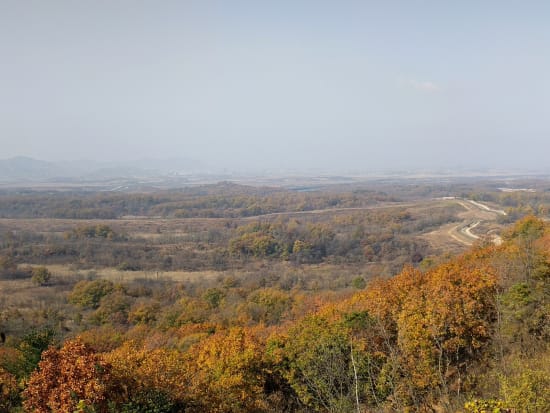
Overall rating
seeing DPRK from the unification tower was very interesting and thought provoking. You can see the little hamlet on the other-side and ponder how they must be living over there sometimes without roofs or heating. You can ... also see the border clearly and witness a-lot of barbed wire. I freedom bridge itself and JSA checkpoint were very interesting. Unfortunately due to swine flu we were unable to go directly to the JSA.
We went with the alternative tour because DMZ was closed due to African Swine Flu. Regardless, still very pleased. Our guide on the day (Dec 27) was outstanding - informative, friendly and super helpful. Tour will have b ... een perfect if more time was allowed at the War memorial. Its a huge place and will require a couple hours to really enjoy all the exhibits, however we were there for only 50 mins at best.
Good service
Our tour guide is professional. She tell about the history of place where we visit, South and North Korea. She take care all group members very well. Lunch is good also. All activities are in agenda and on time.
Activity Provider JOONGANG EXPRESS TOUR
Activity provider, payment / cancellation policy.
- Credit card payment

- Any cancellations made between 18:00 local time, 4 business days to 18:00 local time, 3 business days prior to the activity will be subject to a charge of 50% of the total amount.
- Any cancellations made after 18:00 local time, 3 business days prior to the activity will be subject to a charge of 100% of the total amount.
- Any changes (dates or number of people) made between 15:00 local time, 4 business days to 15:00 local time, 3 business days prior to the activity will be subject to a charge of 50% of the total amount. Any changes (dates or number of people) made after 15:00 local time, 3 business days prior to the activity will be subject to a charge of 100% of the total amount.
Payment Methods

Cancellation Policy
Change policy.
Please visit VELTRA Support page to send an inquiry about this activity.

Editor's Picks for Seoul

Korea DMZ and JSA Tours: From Division to Peace
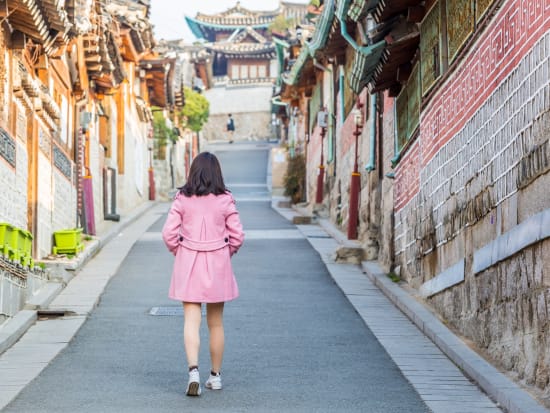
Last-Minute Activities and Essentials in Seoul
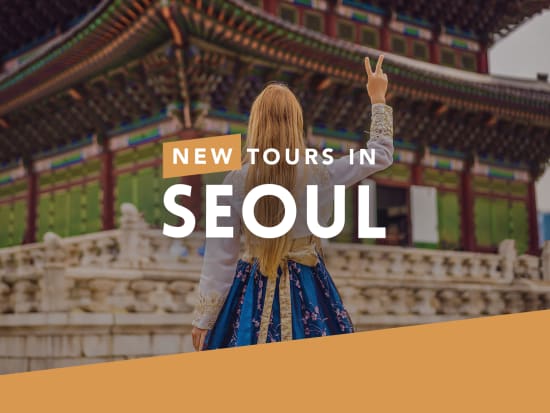
New on VELTRA! Seoul Tours and Things to Do
The Grandeur of Seoul's Royal Palaces
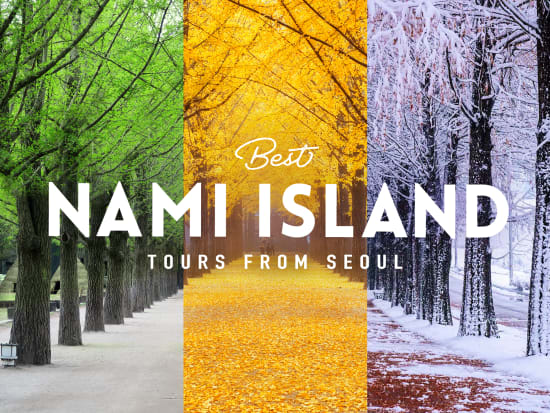
Best Tours of Nami Island from Seoul

Ride the Korean Wave

Top Shows You Should See in Seoul

Enthralling Amusement and Theme Parks near Seoul
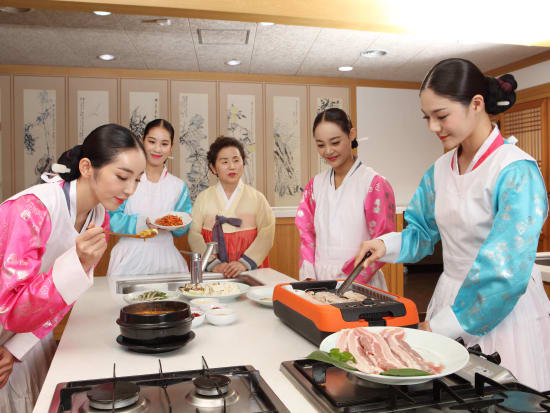
Traditional Cultural Experiences in Seoul
日本語ガイド&オムレツ昼食付き, eur 152.00~.
You can only add up to 10 items in the list.
Please reduce items in the list.
- STEP 3 Book another activity, and use the coupon for a discount!
- Valid for one (1) booking per account during the designated promotional period.
- Cannot be used on the same activity on the same date and time as the first activity, or applied to activities that have already been booked.

- Company Information
- Investor Relations
- News Release
- Supplier Sign-in
- Add Your Activity
- Privacy Policy
- Basic Policy on Information Security
- Terms & Conditions

DMZ, Panmunjom North Korea | North Korea Travel Guide
By Koryo Tours
DMZ, Panmunjom | North Korea Travel Guide
DMZ, Panmunjom North Korea
Introduction History Panmunjom at the DMZ Concrete Wall How to visit the DMZ Panmunjom
DMZ Panmunjom Introduction
The Korean DMZ, or Demilitarised Zone, was established in the aftermath of the Korean War (1950-1953).
It stretches for 250 kilometres (160 miles) across the width of the Korean peninsula between the Mt Kumgang region in the east and the mouth of the Imjin and Han rivers in the west.
The zone is 4 kilometres (2.5 miles) across and separates the Democratic People’s Republic of Korea (North Korea) from the Republic of Korea (South Korea).
The DMZ line is similar in location to the original border drawn between the two countries in 1945 after liberation from Japan.
This first border was drawn along the 38th parallel.
The only major shift in territory during the war was the city of Kaesong which was liberated from southern control by the northern side and is now North Korea’s southernmost city.
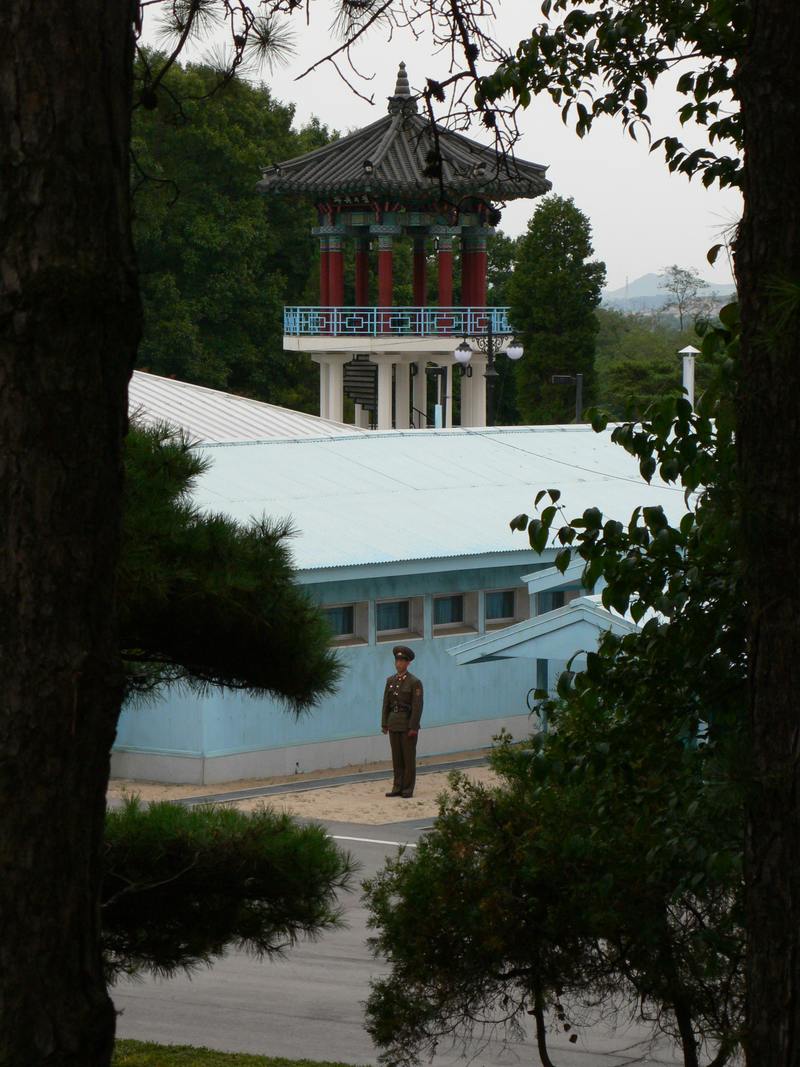
DMZ Panmunjom History
In 1953, the Korean armistice was signed to end hostilities between the UN forces and the communist forces of North Korea and China.
Part of the agreement stipulated that both sides should move their troops back 2 kilometres from the front line.
This created the 4-kilometre wide buffer zone at the DMZ.
Technically, the dividing line between the two countries is the Military Demarcation Line at the centre of the DMZ.
This line marks where the front line was at the time of the armistice.
As well as the overland border, a sea border was established, known as the Northern Limit Line.
The exact line is disputed due to a disagreement between the UN and North Korean sides over specific distances.
DMZ: Panmunjom
Panmunjom is located just north of the Military Demarcation Line in the DMZ. It is known as the ‘Truce Village’. Panmunjom is a section of the DMZ area.
Panmunjom was the site of peace negotiations which took place between 1951 and 1953.
Today, Panmunjom has become a museum for tourists visiting the nearby Joint Security Area (JSA) .
The JSA at Panmunjom is the most famous point on the DMZ.
The distinctive blue conference buildings straddle the Military Demarcation Line and have been the site of numerous negotiations and diplomatic talks between North and South .
The JSA has grown extensively since the Korean War.
Both sides have established numerous guard-posts and other buildings within the area.
North Korea’s main building at Panmunjom, overlooking the border, is called Panmungak. South Korea’s Freedom House and Peace House sit on the southern side.
Until 1976, the JSA was patrolled by UN forces and North Korean forces, both spread equally around the whole area.
The ‘Axe Murder Incident’ saw a US military soldier attempt to cut down a contested tree which led to a fight during which he was killed with an axe.
The axe is on display in Panmunjom.
After this event, each side was restricted to their side of the Military Demarcation Line.
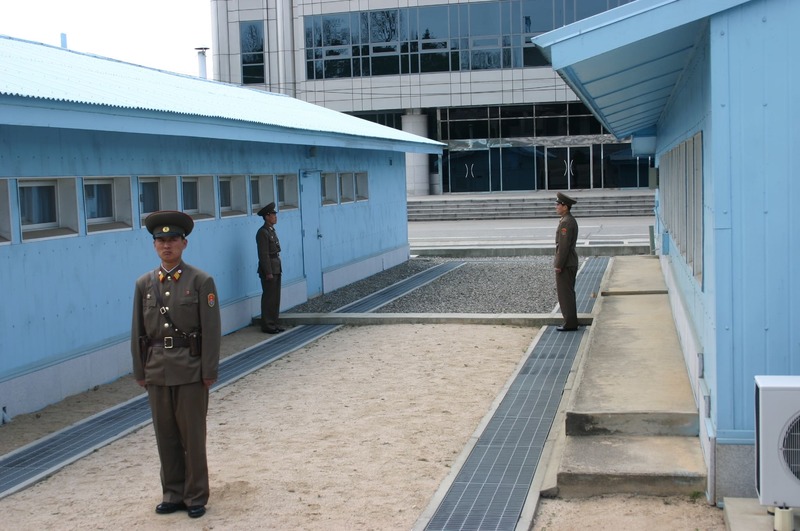
DMZ Panmunjom - The Concrete Wall
North of the Panmunjom JSA is a lookout , visitable by tourists, which sits atop a hill looking out over the DMZ.
This site is meant to highlight a large concrete wall which the South Korean military reportedly built across the entire peninsula.
This is seen to symbolise South Korea's wish to permanently divide the peninsula.
The wall is clearly visible through the military binoculars at the lookout.
How to visit the DMZ Panmunjom North Korea
Panmunjom and the DMZ is nearby the city of Kaesong in North Hwanghae Province.
Visitors can either travel direct from Pyongyang (2-3 hour drive) or stay overnight in Kaesong and travel from there.
Tourist buses first travel through a huge concrete arch into the car park.
This arch has the word ‘Reunification’ written in huge white letters above it.
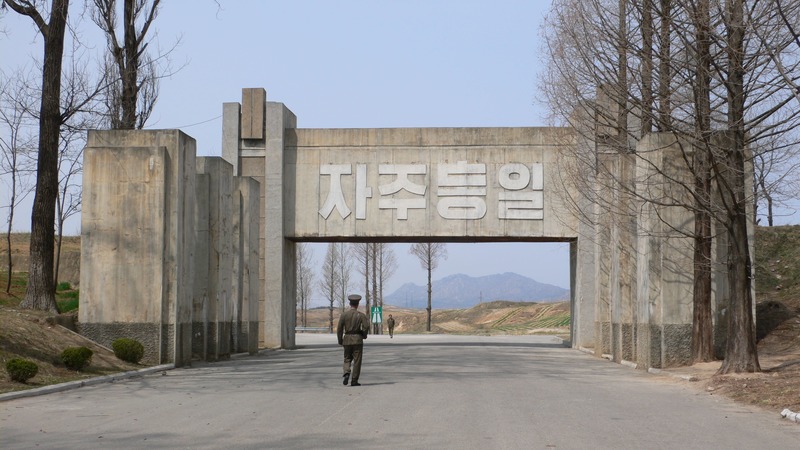
Once in the car park of the DMZ, visitors are welcome to browse the gift shop whilst military personnel carry out checks.
There is then a short explanation of the site and its history given by a Korean People’s Army guide.
Visitors then board their buses again and head through the first checkpoint down to Panmunjom.
A museum has been set up in the buildings once used by North Korean and UN officials to negotiate and sign the armistice agreement.
The original flags and agreement are under glass on a table in the centre of the room along with photos and artefacts from the time.
The tour then continues, by bus, towards the Panmunjom Joint Security Area.
On this drive, the North Korean flag is visible on the right-hand side flying atop one of the largest flagpoles in the world.
The flagpole was built in the border town of Kijong-dong, one of two towns allowed to exist inside the DMZ.
It was constructed to counter a large flagpole built on the southern side in Daesong-dong, the other town allowed to exist in the DMZ.
Once tourists arrive at the JSA, they are taken to the signature of Kim Il Sung; a huge marble monument with the President’s signature emblazoned on it.
It is reported that this is a copy of the signature he wrote on his final document before his death in 1994.
They are then taken to the Military Demarcation Line and may even get the opportunity to head into one of the blue conference buildings and step, technically, into South Korea.
Read more about what a visit to Panmunjom DMZ is like .
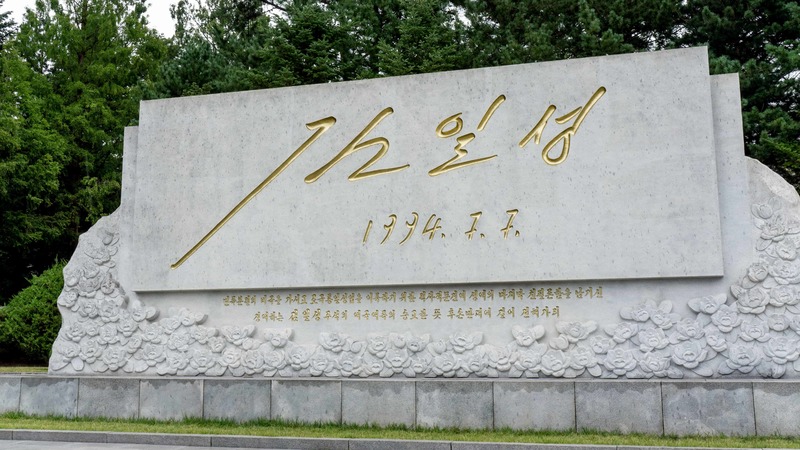
Interested in a tour to North Korea? Travel to North Korea with the only North Korea travel experts, Koryo Tours
North Korea Travel Guide PDF | Sign up to the mailing list | A bout Koryo Tours
You have successfully joined our subscriber list.
- Group Tours
- Private Tours
- Pyongyang Marathon
- Turkmenistan
- Cultural Engagement
- Country profile
- Terms & conditions
- Why choose Koryo
[email protected] | + 86 10 6416 7544 Room A409, Jucai Building. No. 76 Caoyuan Hutong. Dongcheng District, Beijing, 100027, PR China
中国北京市东城区草园胡同76号聚才大厦A 座409 室, 邮编:100027 Download contact card
Not registered yet? Register now
Trouble logging in? Reset password
* All fields are mandatory
Got an account already? Let me log in

- Destinations
- Travel Checklist
- Travel By Sea (Ferries)
Panmunjom Tour – The North Korean Demilitarized Zone (DMZ)
Table of Contents
About the DMZ
The Demilitarized Zone (DMZ) at Panmunjom is a heavily fortified buffer zone that separates North Korea and South Korea. The 4km wide DMZ stretches 250km (160miles) across the Korean peninsula and was created in 1953 during the armistice after the Korean War. Here I will recount my Panmunjom tour in December 2018.
The DMZ has been the scene of many tense stand-offs between the North and South with soldiers eyeballing each other across the demarcation line. Thankfully, in recent years the situation has improved drastically as tensions have eased between the two Koreas. The Panmunjom DMZ is considered one of the most iconic landmarks in Asia .

I had first read about the Demilitarized Zone in an old copy of National Geographic almost 20 years ago and remember studying the maps and infographics with interest. Little did I imagine that one day I would actually visit the famed 38th Parallel, and from the North Korean side!
Fast forward to winter of 2018 and I was keen to avoid another disappointing Christmas in China . I decided to book onto Young Pioneer Tours’ Christmas tour of the DPRK.
Having visited North Korea once before for a day trip, I was keen to explore the country further. The tour would include a train ride across the country to the capital Pyongyang, the DMZ and the town of Kaesong.
This is my guide to visiting the DMZ from the north side, but there are also many popular tours for visiting the DMZ from South Korea too.
Reunification Arch
After an action-packed few days in Pyongyan g , we left the Ryangang Hotel early for the 3-hour drive south to the border. We made a quick pit-stop at the “Monument to the Three-Point Charter to Reunification” otherwise known as the Reunification Arch.
The arch sits across the reunification highway that leads from Pyongyang to Kaesong. It stretches 55m (180ft) tall and is constructed of grey concrete blocks so beloved of communist dictatorships the world over.

The sun was just rising behind the fields outside Pyongyang and there was no other traffic on the roads lending an eerie, post-apocalyptic feel to the place.
After a ten-minute stop, we were soon on our way again. It was fascinating to get a real glimpse of rural North Korea as we passed through farmland and small villages.
Motorway Services – North Korean Style
It was also impossible to miss the fortifications put in place to halt an advance of enemy troops (South Korean or American) from the south. It reminded me of what our guide told us about the army checkpoints on every bridge we saw on the train.
Every bridge and tunnel is wired with explosives and in the event of an invasion, they would be blown up to prevent the enemy from reaching the capital.
Consequently, every time we passed through a tunnel or over a bridge, I hoped that the soldiers inside their little booths didn’t have itchy trigger fingers!
About halfway into the journey, we stopped at possibly the strangest motorway service station I had ever been in. South Mimms on the M25 it was not! The concrete structure spanning the road looked normal enough, but the very fact that I was in a motorway service station in the DPRK amused me no end.
Inside the building was pretty barren but there was a toilet and stand selling snacks, coffee and commemorative plates featuring the Kim dynasty.
I walked around the car park and snuck past a hedge into a field to snap some photographs but did an about-turn as I saw someone on a ridge looking down. Possibly a farmer, possibly not. Best to take no chances!
After 30 minutes we hit the road again and continued our journey south. As we neared the border the city of Kaesong came into view.
The skyline looked nothing like the utilitarian “workers’ paradise” of Pyongyang and looked a lot more “Korean” with wooden buildings and the distinctive east-Asian rooftops.
Arriving at Panmunjom DMZ
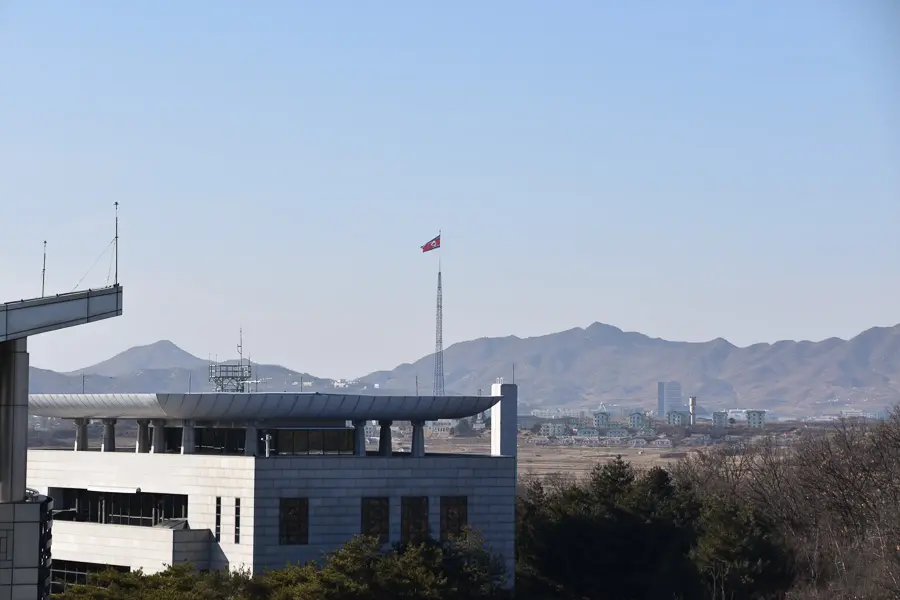
We arrived at the first checkpoint where the bus pulled over and we all got out. There was a stone obelisk with propaganda murals displaying the North’s commitment to reunification.
A solemn finger reached skywards over the top of the Korean peninsula and on the other side two smiling children amidst a sea of flowers.
In front of us was a large gate and high barbed-wire fence. Soldiers strutted around in their new winter uniforms which looked a lot more modern than the old great-coats and Russian-style hats of a few years ago.
I felt a little conspicuous in my combat trousers and British army boots and one of my fellow tourists pointed this out with a grin.
We were led into a building that housed a souvenir shop selling the usual tourist trinkets and Korean alcohol. On sale were also original propaganda posters (hand-painted, not prints) and watercolours of the Korean landscape.
Here we waited for our new guide; an army Major of the Korean People’s Army. He greeted our own Aussie tour guide with genuine warmth and it was strange to see them both joking with each other (under normal circumstances, nothing out of the ordinary, but it’s not really the image of the North Korean military that most people have).
Tour of Panmunjom DMZ
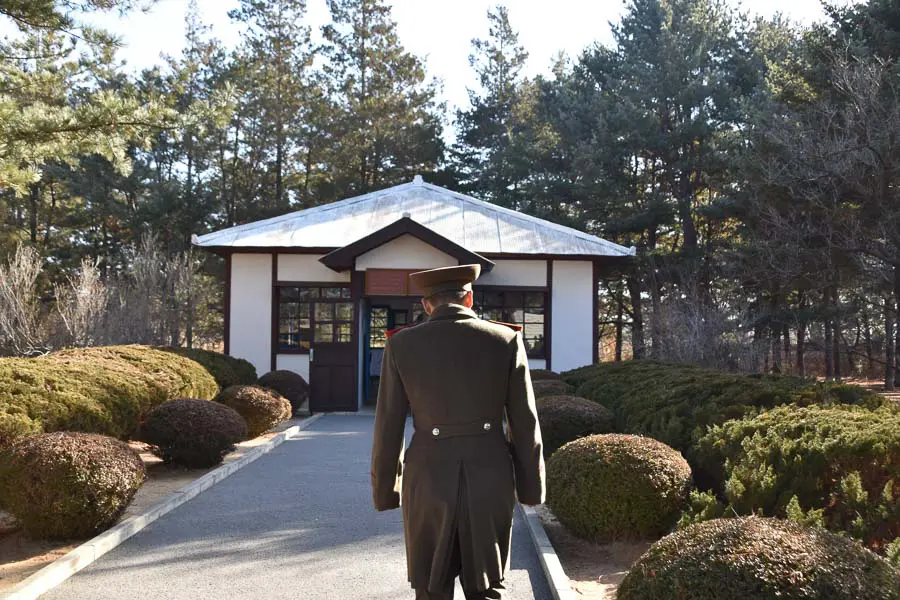
We re-boarded the bus along with the Major and crossed the first of many checkpoints. In the distance, the flag of the DPRK fluttered in the breeze atop its 160m (525ft) flagpole, the fourth highest in the world.
In a strange twist of fate, I’ve also seen the third and fifth highest flags in Azerbaijan and Turkmenistan! I looked out of the window and could see trenches with mannequins dressed in army fatigues holding wooden guns. We soon stopped at a series of whitewashed wooden buildings.
There were watch-towers and radio masts all over and I made sure to ask every time I took a photograph. Our hosts were surprisingly receptive and we had a lot more freedom than I expected (just as in Pyongyang in the days previous).
We followed the army Major and his entourage into the grounds of the huts where he explained their significance in brokering the armistice between the South and America.
As we entered one of the huts there were two flags encased in cabinets; a flag of the DPRK and a tattered “stars and stripes”.
There were fits of suppressed giggles as the translator explained the Major’s words: “If the imperialist USA try to invade again, we will surely crush them”. I laughed not so much at the sentiment, but more so for the hyperbolic language.
The Joint Security Area (JSA) at Panmunjom
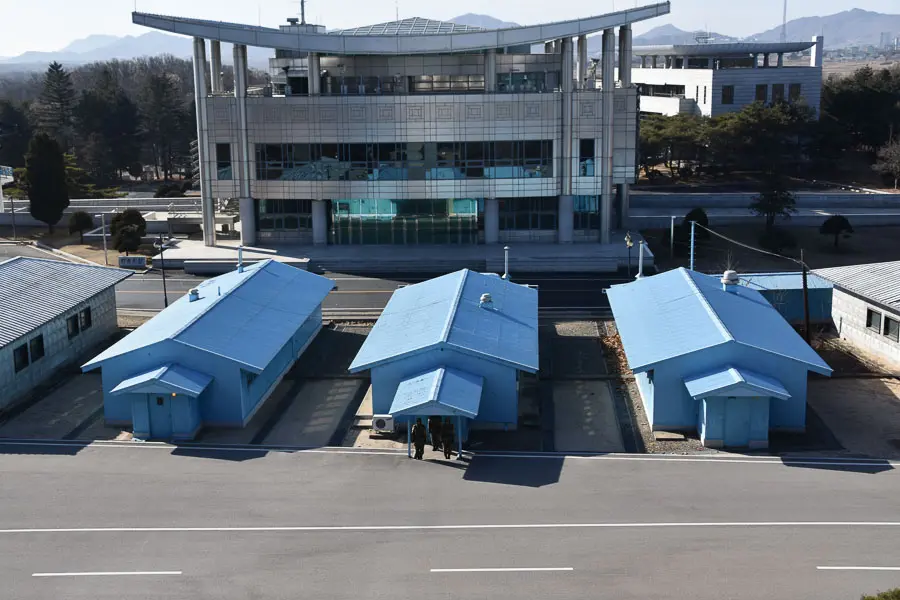
After a tour of the huts, we were back on the bus and crossed another checkpoint before arriving at the Joint Security Area (JSA) also known as Panmunjom.
This area with its bright blue huts is where North and South Korean soldiers have stood in a tense face-off for years. Now though, the South Korean’s have withdrawn troops in an effort to stabilize relations with the North.
We were taken up to the roof of a modern-looking office building from where we could look down to the soldiers marching in step below. Gone are the old soviet-style greatcoats which have been replaced with more modern-looking uniforms. In the distance, the flag of South Korea fluttered in the wind.
We were allowed to snap away at the soldiers and buildings which was surprising, and I even managed to get a picture with the Major which was a real coup!
After 10 minutes or so we boarded the bus and left the area through the same checkpoints to spend a pleasant afternoon in the North Korean city of Kaesong.
About the DMZ Tour

In the past, the situation has been very tense at the DMZ, with propaganda being blared across in both directions via large loudspeakers. Defections from the North and other ‘border incidents’ have done little to ease tensions.
However, things at the DMZ are changing rapidly. Where you could once enter the blue JSA huts and stand astride both Koreas, the South Koreans have locked the doors and left in a gesture of goodwill.
In October 2018, North and South Korean guard posts as well as numerous landmines were destroyed in another act of reconciliation.
With the above in mind, if you wish to take a DMZ tour as it still is in its heavily fortified incarnation, then, now would be the time to visit!
Young Pioneer Tours can arrange group and bespoke tours to the DMZ, so visit while you still can! What’s more, quote TRIPYPT20 and get a free exclusive t-shirt when booking!

About the author: Steve Rohan is a writer from Essex, England. He has traveled to over 60 countries, lived in Armenia, China and Hong Kong, and is now living the digital nomad life on the road.
Steve prefers “slow travel” and has covered much of the world by train, bus and boat. He has been interviewed multiple times by the BBC and recently featured in the documentary Scariest Places in the World . See the About page for more info.
Where I am now: Yerevan, Armenia 🇦🇲
Leave a Reply Cancel reply
Your email address will not be published. Required fields are marked *
Panmunjom - A detailed guide to visit the Korean truce village
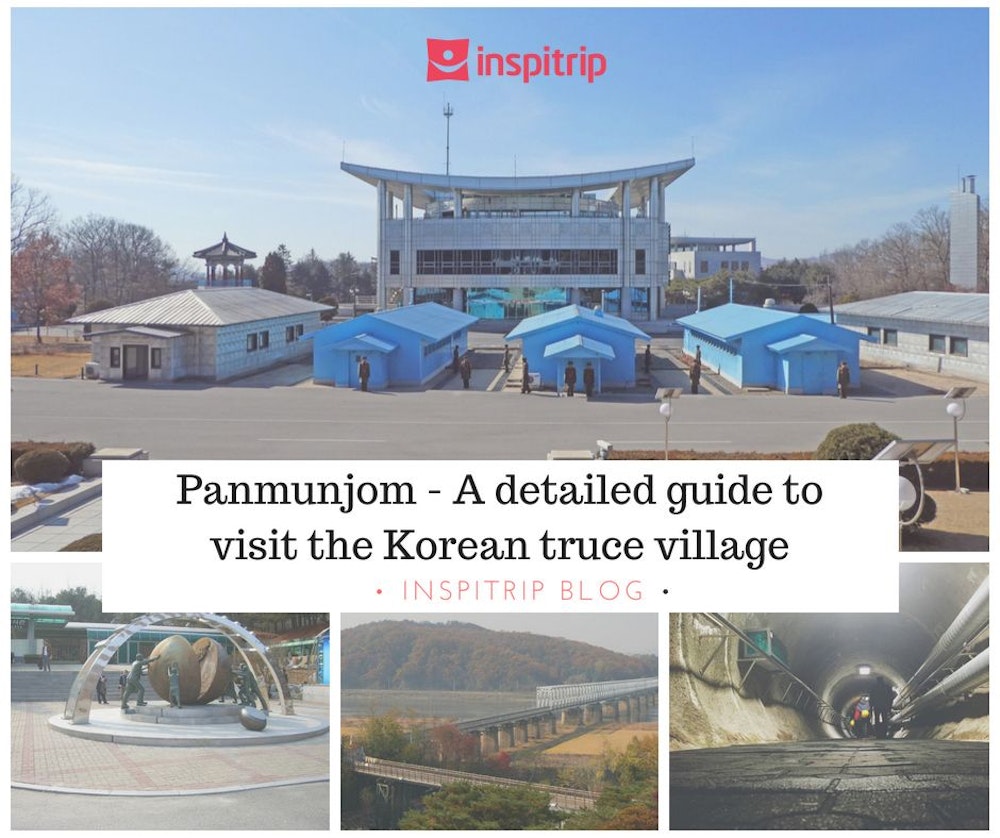
Panmunjom is located in the most sensitive area of Korea's demilitarised zone. It’s the only tourist destination where visitors are required to sign a release that asks them to accept responsibility for “injury or death as a direct result of enemy action." The Joint Security Area (JSA), aka Panmunjom, offers a look at the tensions that remain from the Korean War. The North and South technically remain at war, and the JSA, located deep within the Demilitarized Zone (DMZ), is the only place where visitors can see the actual border and North Korean soldiers on the other side. Indeed, joining a high-quality DMZ & JSA tour is one of the most unique things to do in Seoul . Here is our detailed guide to visiting the Panmunjom - Korean truce village.
You are about to enter the world's most protected border and witness the spine-chilling tension between North and South Koreas
History of panmunjom.
Panmunjom is a small village, about 55 km north of Seoul, that lies at the border between North and South Korea. It was originally called “nul ban ri,” or plank-door village, so-called because the house doors and bridges were made from planks of wood. When the village became the site of talks during the Korean War, Chinese officials labeled it with traditional Chinese characters, which when pronounced in Korean sounded like Panmunjom.The truce that ended hostilities between the two countries was signed here in 1953, but as peace was never agreed to, the two sides are still officially at war over fifty years later and a million men stand guard around the Demilitarized Zone (DMZ).
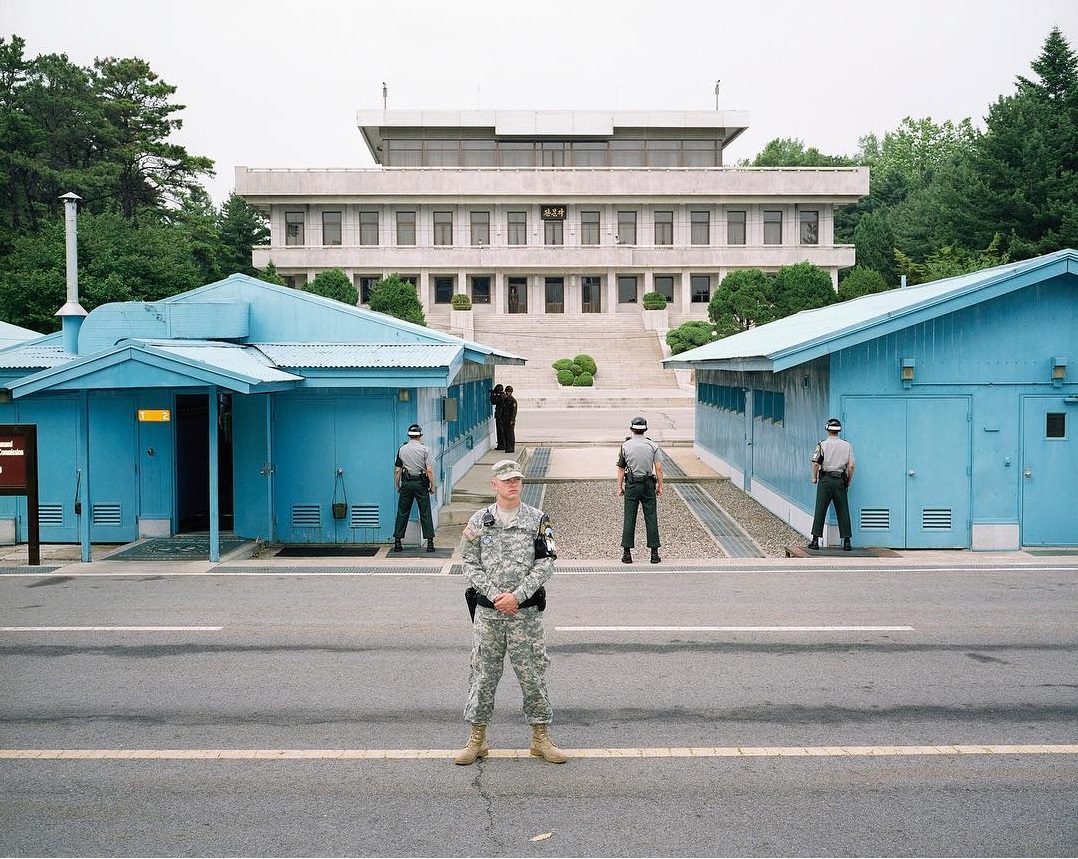
To repel an invasion, both sides of the highway, especially the side facing the Imjin River and open water to North Korea, are covered with barbed wire and dotted with observation posts every few hundred meters. Nearby hills house machine gun emplacements, the median strip has clusters of sandbags for defense, and many bridges above the highway can be activated as tank traps as they contain large concrete blocks that can be dynamited to block the road. Large illuminated signs, proclaiming "Freedom and Democracy" in Hangul script, face the North.
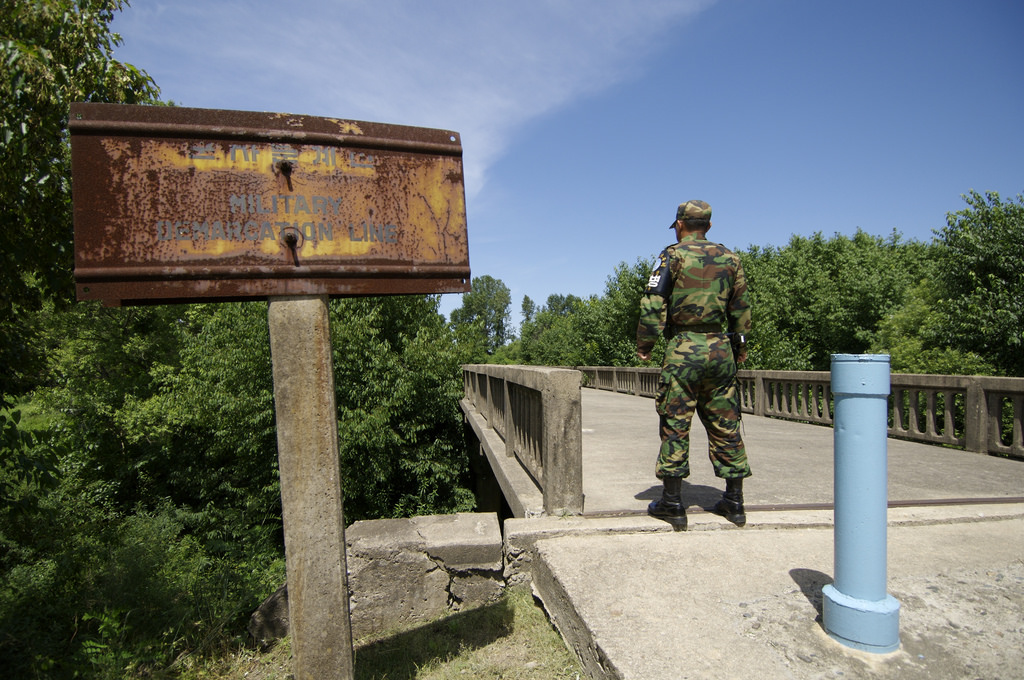
Have a spine-chilling experience by visiting DMZ & JSA , the most volatile area all in the world! Our guide will take care of everything so that you can enjoy your visit to the fullest!
- DMZ half day morning tour
- The best DMZ, JSA and third tunnel combined tour
- Panmunjom (JSA) tour with a North Korean defector
How to get to Panmunjom
Panmunjom sits less than 40 miles from Seoul. The only way into this heavily restricted area is on an organized tour. To enter the JSA, visitors must pass through multiple checkpoints before arriving at Camp Bonifas, escorted by either US or South Korean soldiers. Note citizens of certain countries are not allowed on these tours. Access to most of the are is forbidden, so the only way to visit Panmunjom is through a licensed tour operator.
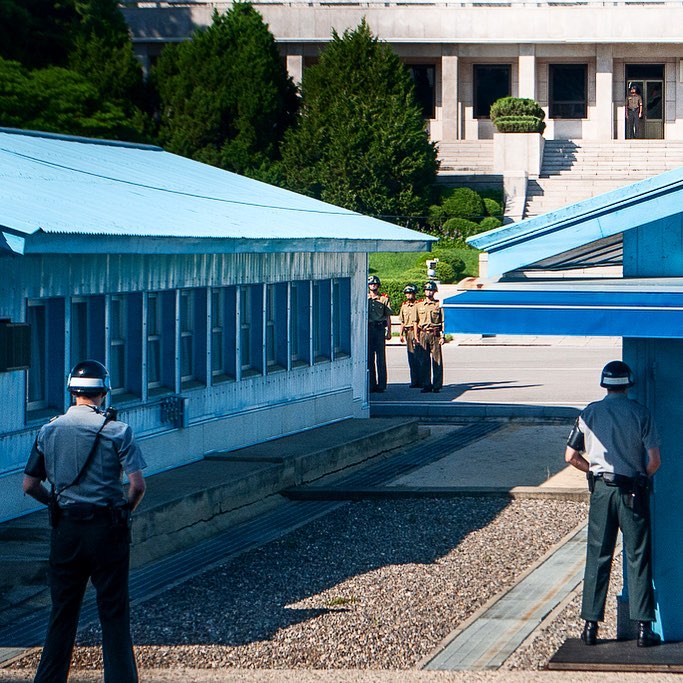
Panmunjeom is very close to the South Korean capital of Seoul, and tours from the center of the city with itineraries that include Panmunjeom generally start in the morning and end before the evening. The 62 km journey towards Panmunjeom from Seoul is a sight in itself. The 12-lane Freedom Road becomes eerily empty as you approach the border, as its primary purpose is to get tanks there as fast as possible if war breaks out.
Unlike any random touristy attractions, Panmunjom embodies the innermost secrets which only an intellectual tour guide from Inspitrip can help you unravel.
What you can expect in Panmunjom
There are no troops in the DMZ itself (except in the JSA), although both sides of the 4 km strip of land separating the Koreas are likely to be the most heavily armed in the world. Pillboxes, land mines, barbed wire, and tank stoppers line the entire border and stretch back halfway to Seoul in the South and Pyongyang in the North. This section is often referred to as the Militarized Zone. In South Korea, there are also adjacent border areas called Civilian Control Zones where public access is restricted.
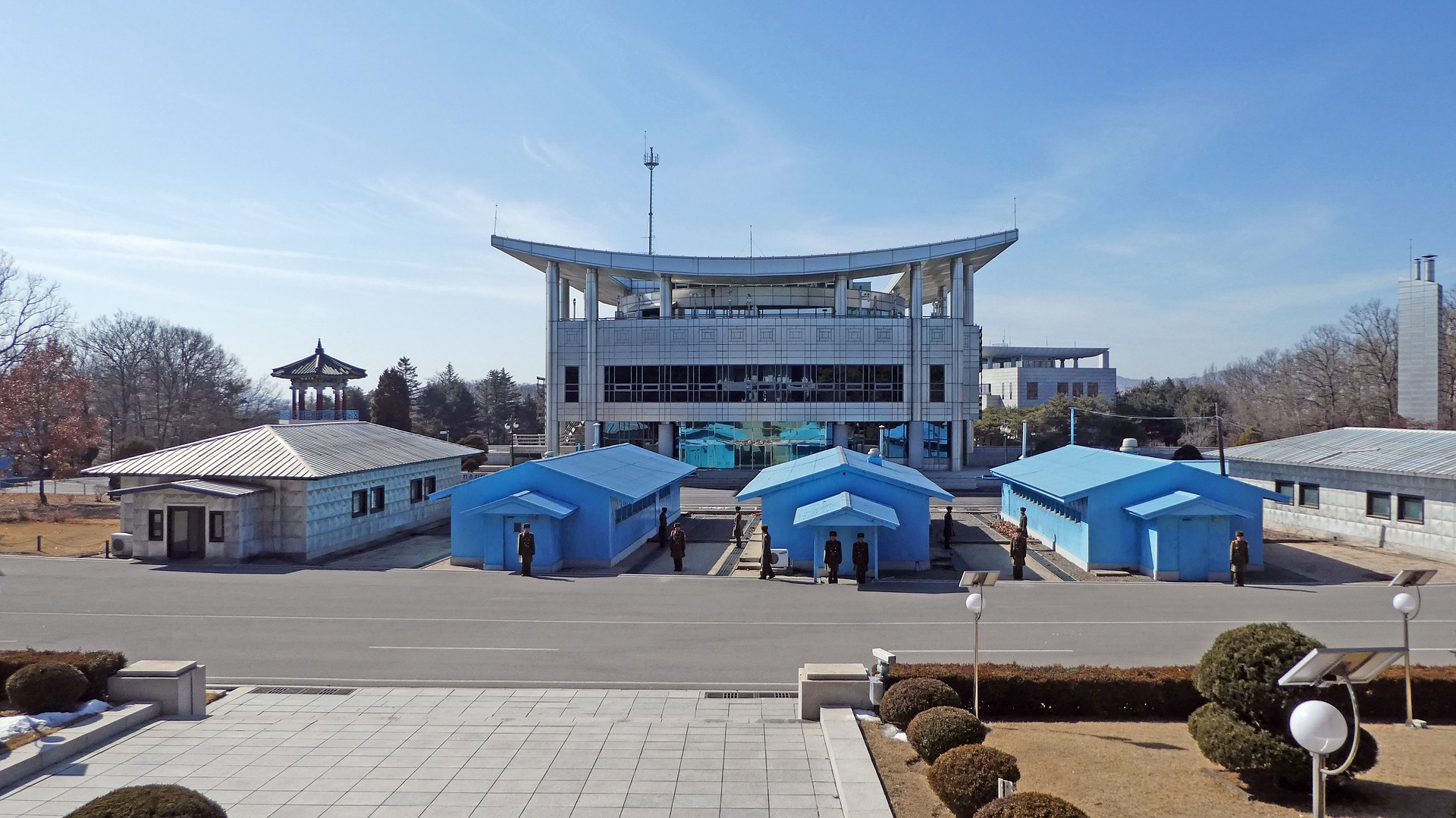
One kilometer east of the former village (now deserted) is the Joint Security Area (JSA), an almost circular patch of land with an 800 m diameter. This area is jointly policed by the South and North, and the two sides occasionally meet for discussions. Panmunjeom is right on the Military Demarcation Line (MDL), which is the actual border between North and South Korea. The DMZ is a four-kilometer-wide buffer strip centered on this MDL.
What you can experience in Panmunjom
Take a trip through history and learn about North Korean and South Korean. You will get to visit key sites of the struggle and learn about economic, political and social effects the war has had on both countries. The highlight of the trip is that you will be able to walk right up to the North Korean border on a tour of the Joint Security Area - the only portion of the DMZ where the North Korean and South Korean forces stand face to face.
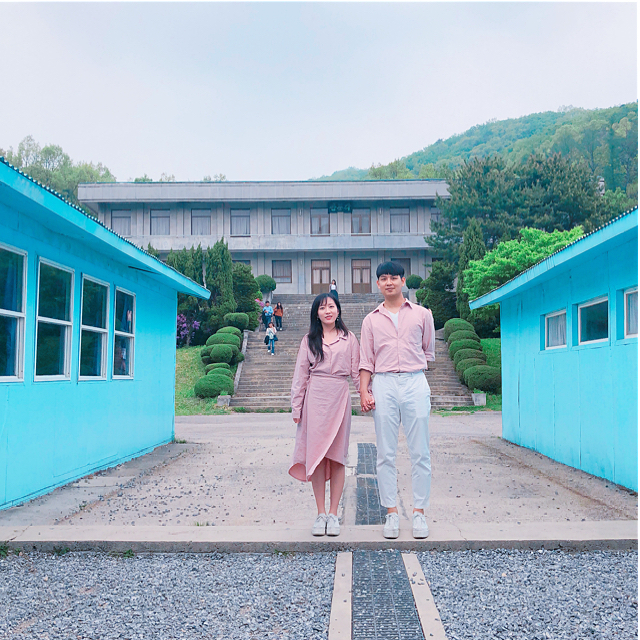
Due to the tension and security concerns involved, travelers are required to join an organized tour group in order to visit the truce village better known as the JSA. Day trips to the DMZ from Seoul include stops at the JSA, as well as other area attractions like the Third Infiltration Tunnel, Bridge of No Return, and an observation point where it’s possible to observe a North Korean village across the border through a telescope. You will also get to visit the Freedom House, Imjingak Park - home to many statues and monuments commemorating the Korean War. Read More : Detailed guide to visit the DMZ
Visit the Freedom House
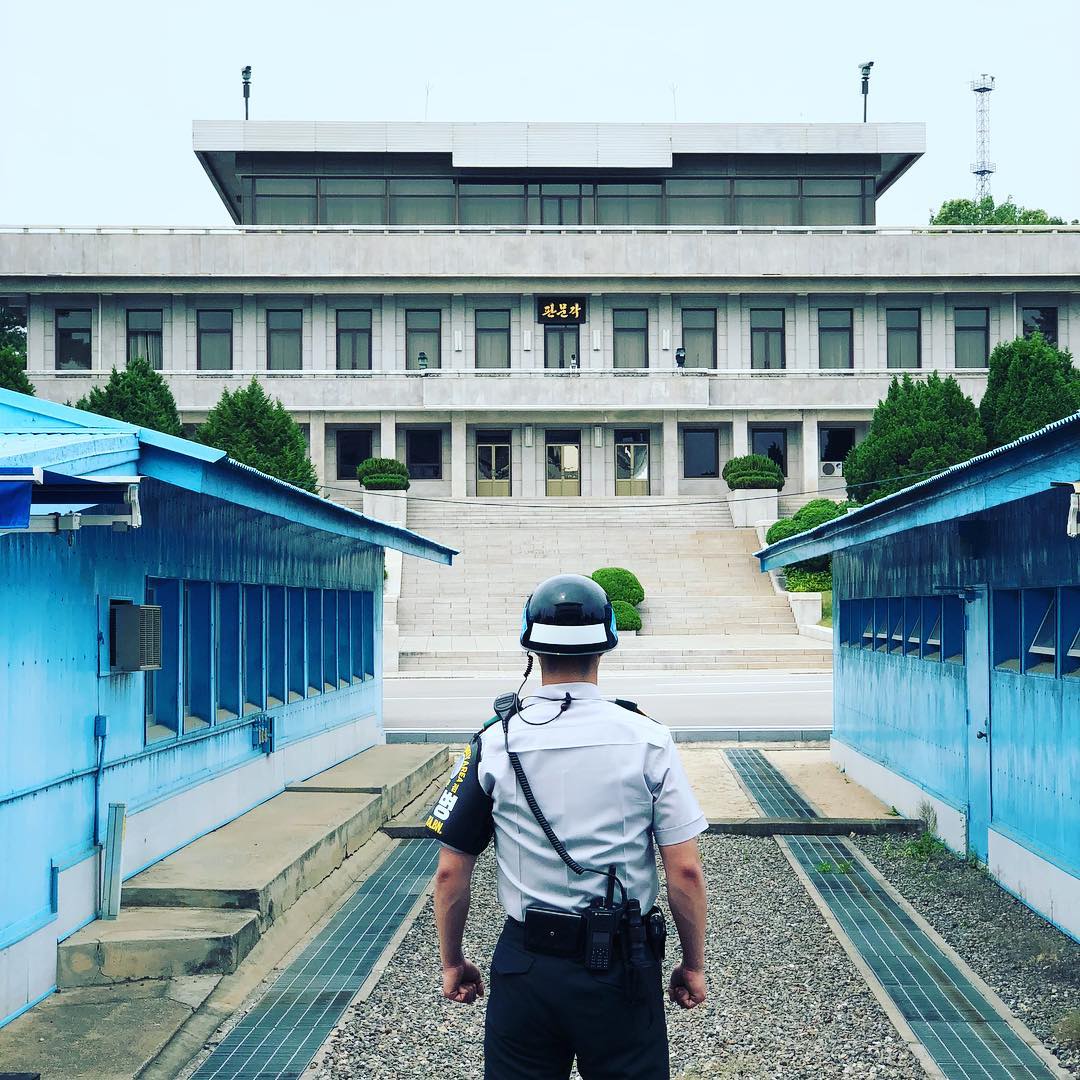
Located in JSA, the Freedom House functions as a meeting place for North and South Korea. The facility helps the two sides to negotiate and communicate, holding offices of major organizations like the South and North Red Cross Liaison Office. This stop often starts the JSA tour, setting the tone of the interaction between North and South Korea. The current building was constructed on July 9, 1998. It was built by the founder of Hyundai to host reunions of families separated during the Korean War. However, since North Korea has worried about sending their people through the division line of JSA, the house has been used only for Red Cross staffs and the liaison officers of South Korea.
See the Bridge of No Return
The Bridge of No Return is a small bridge where POWs were exchanged after the war. There were two operations for it: Operation Little Switch as a test case for prisoner repatriation and Operation Big Switch for a general exchange of prisoners. All the POWs were carried to both ends of the bridge and they were given a choice. Once they chose to cross over the road, they could not make a turning back, hence the name “Bridge of No Return”. About thirteen thousand UNC prisoners returned to their countries, and about eighty-nine thousand KPA and Chinese prisoners returned to their communist nations.
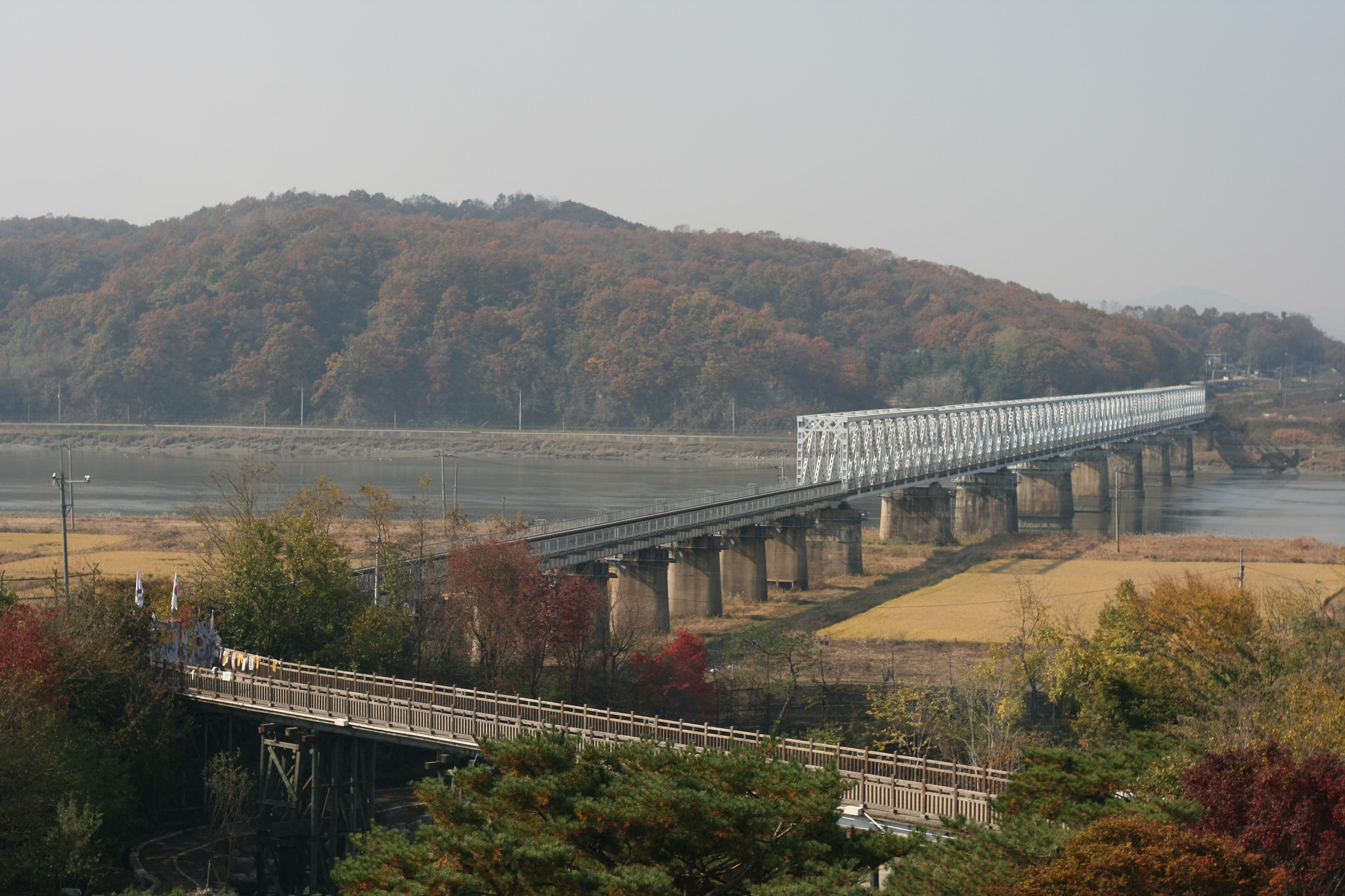
Wander around Imjingak Park
Saddening as it may be, the stories of separated families will inspire and move you to tears
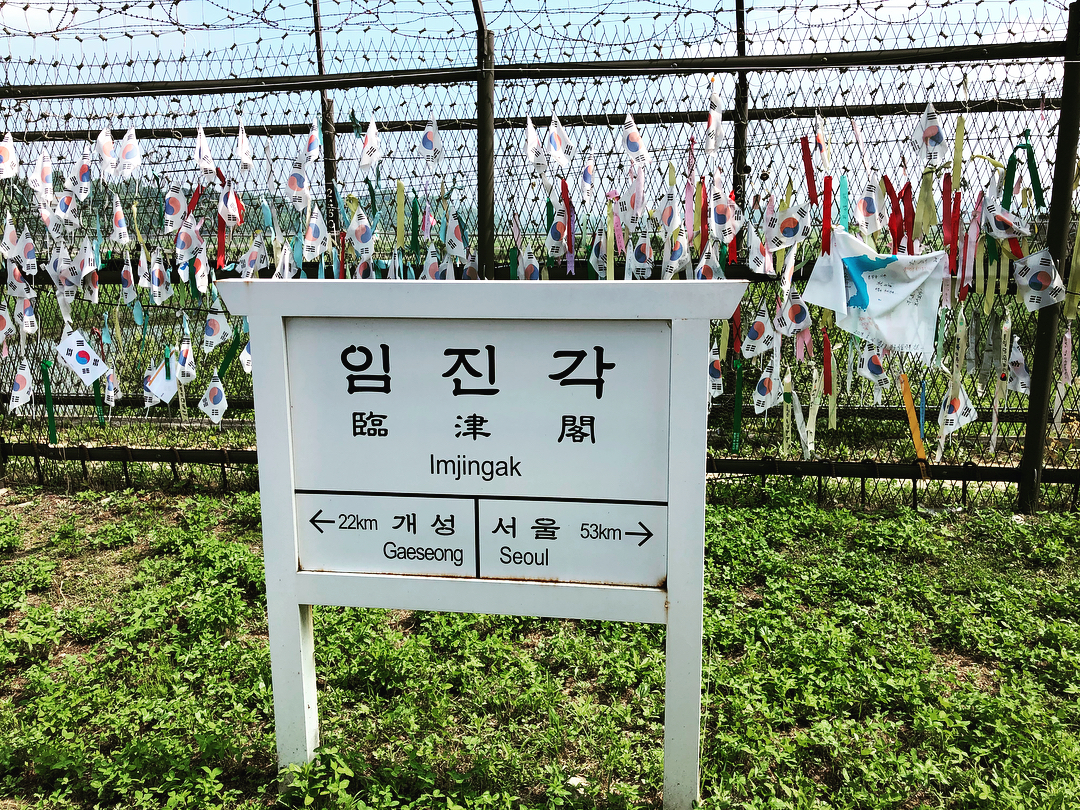
Imjingak, located 7 km from the Military Demarcation Line, is now at the forefront of tourism related to the Korean War. It was built in 1972 with the hope that someday unification would be possible. Three-storied Imjingak is surrounded by several monuments, Unification Park and North Korea Center. 400 kinds of photos and documents showing the stark reality of North Korea are displayed in the North Korea Center of Unification Board. Outside Imjingak, there are 12 kinds of tanks and crafts on display that were used during the war. Mangbaedan Alter, which stands opposite of Imjingak, is famous for the place where people from North Korea visit and perform ancestral rites by bowing toward their hometown every New Years Day and Chuseok (Korean Thanksgiving). If you are lucky enough, you can be connected with a North Korean defector to listen to heart-breaking stories of separated families. These wonderful experiences will at times make you feel sad; at others inspired. Be prepared to embrace all of these emotions during this unforgettable trip.
Observe North Korea with your naked eyes at Dora Observatory
From the observatory, you can overlook North Korea and various locations including Gaeseong, Songaksan, Kim Il-Sung Statue, and Geumamgol, the cooperation farm. As such, you might get a strange feeling knowing how close you are to North Korea. It will arouse your curiosity about meeting the North Korean and asking them how they make ends meet on a daily basis in the world’s most secretive country.
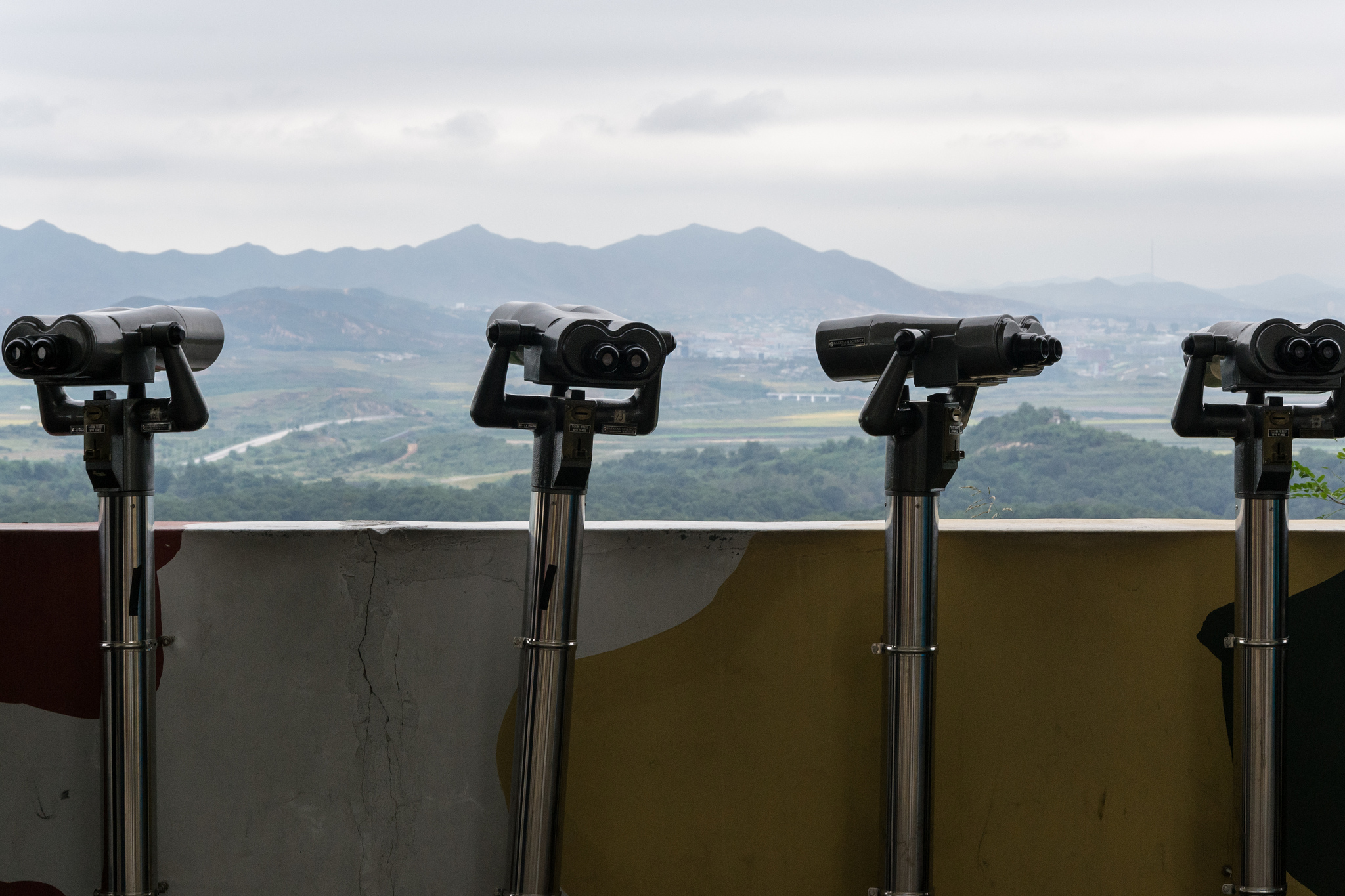
Head to The Third Tunnel
Only 44 km (27 miles) from Seoul, the incomplete tunnel was discovered in October 1978 following the detection of an underground explosion in June 1978, apparently caused by the tunnellers who had progressed 435 meters (1,427 feet) under the south side of the Korean Demilitarized Zone (DMZ). Visitors enter either by walking down a long steep incline that starts in a lobby with a gift shop or via a rubber-tyred train that contains a driver at the front or the back (depending on the direction as there is only one set of rails) and padded seats facing forward and backwards in rows for up to three passengers each. Photography is forbidden within the tunnel.The South Koreans have blocked the actual Military Demarcation Line in the tunnel with three concrete barricades. Tourists can walk as far as the third barricade, and the second barricade is visible through a small window in the third.
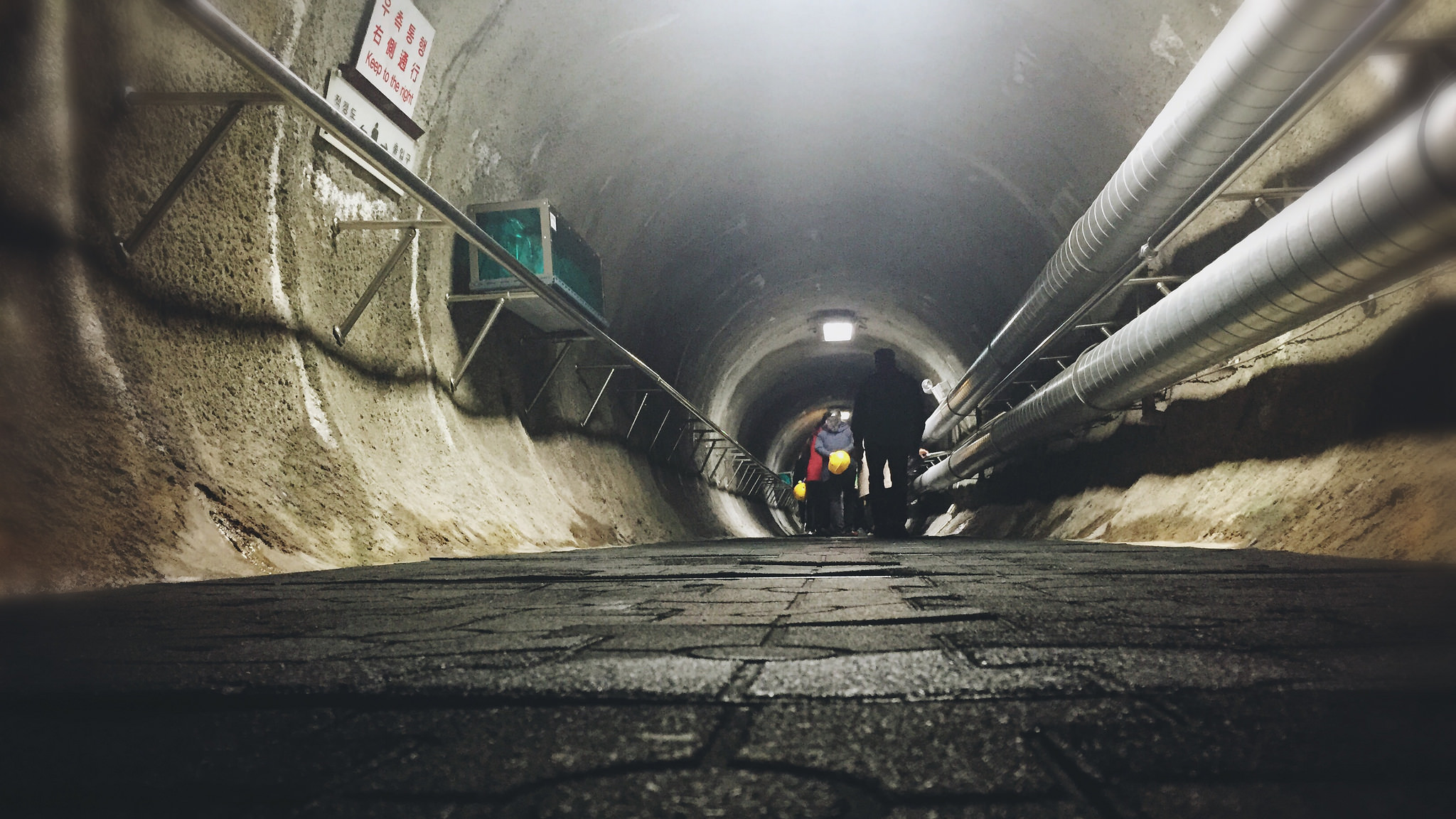
Buy souvenirs at Camp Bonifas
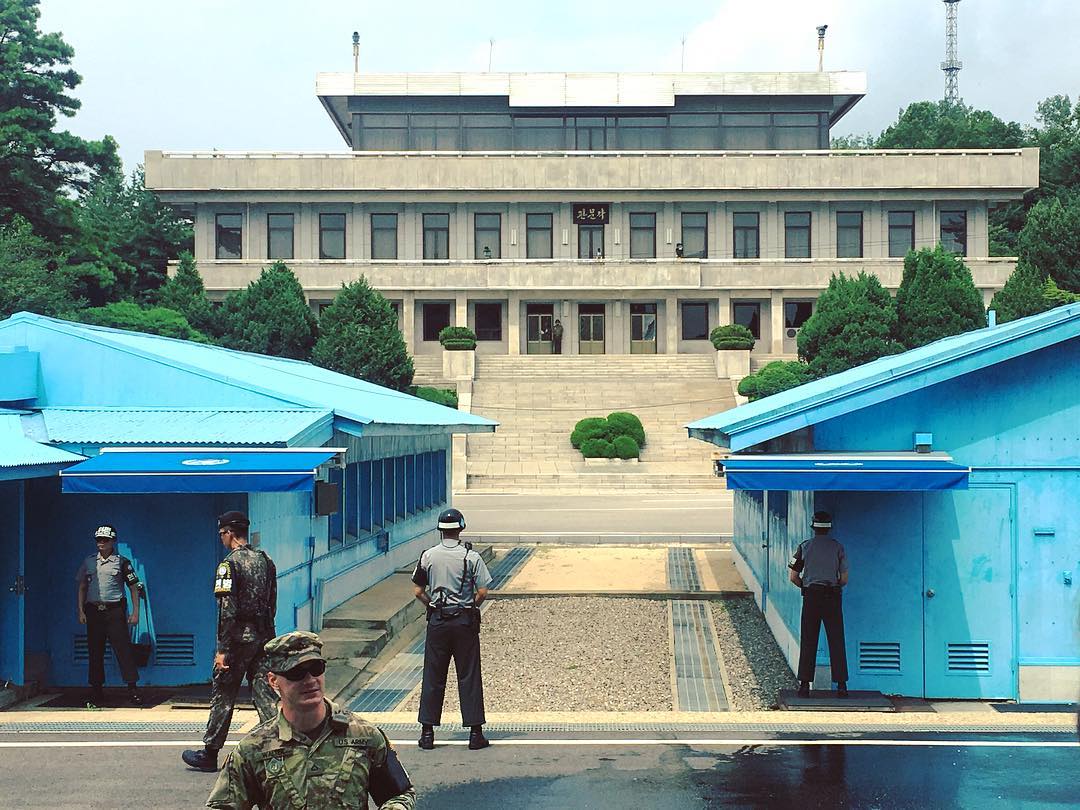
Camp Bonifas is a United Nations Command military post located 400 meters south of the southern boundary of the Korean Demilitarized Zone. It was 2,400 meters south of the Military Demarcation Line, which forms the border between South Korea (the Republic of Korea) and North Korea (the Democratic People's Republic of Korea). It was returned to the Republic of Korea in 2006. Camp Bonifas is home to the United Nations Command Security Battalion-Joint Security Area, whose primary mission is to monitor and enforce the Korean Armistice Agreement of 1953 between North and South Korea. The Republic of Korea and the United States Forces Korea soldiers conduct the United Nations Command DMZ Orientation Program tours of the JSA and surrounding areas. The camp has a gift shop where you can buy DMZ - and JSA- related souvenirs.
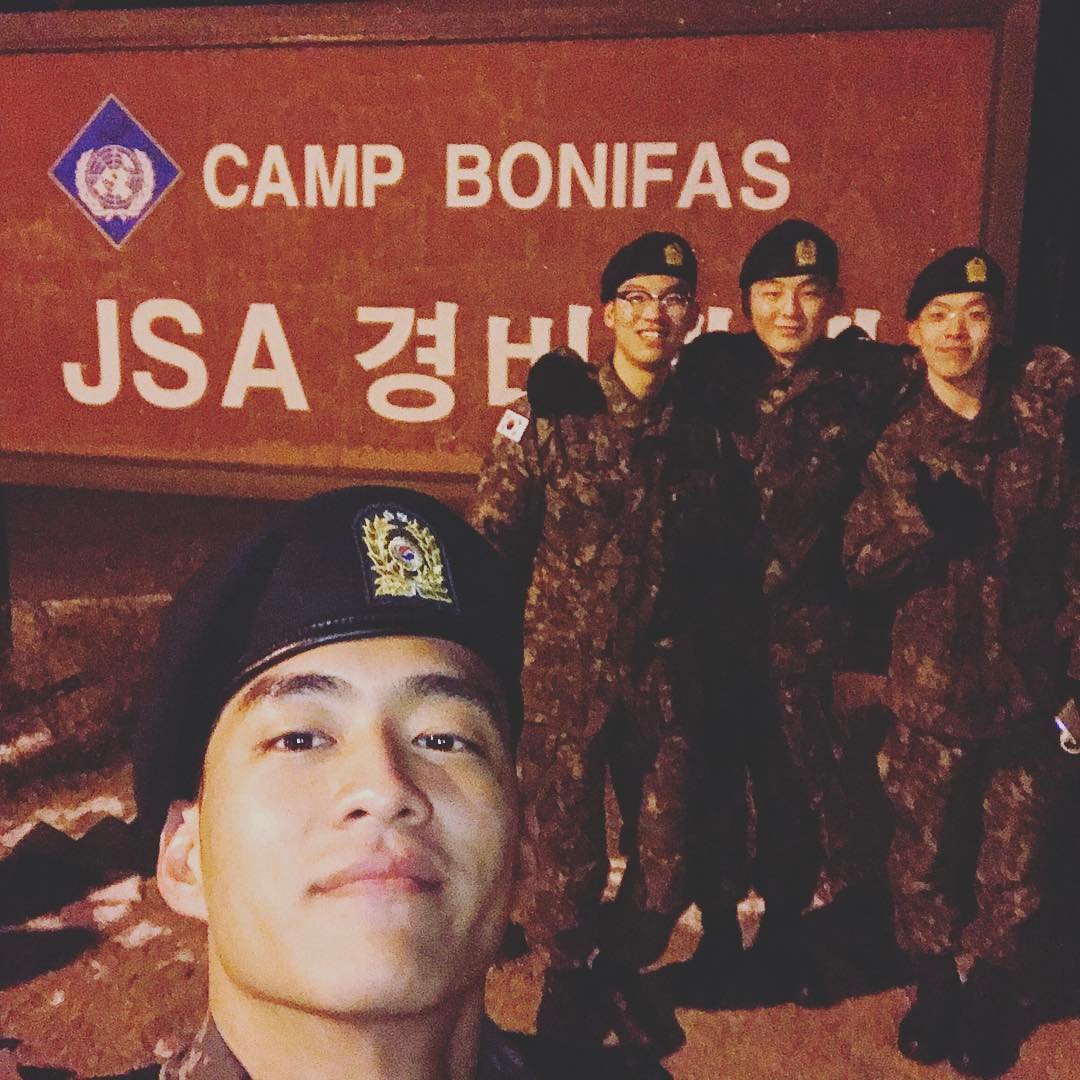
Visit DMZ Museum to broaden your mind about the historical events of the Korean war
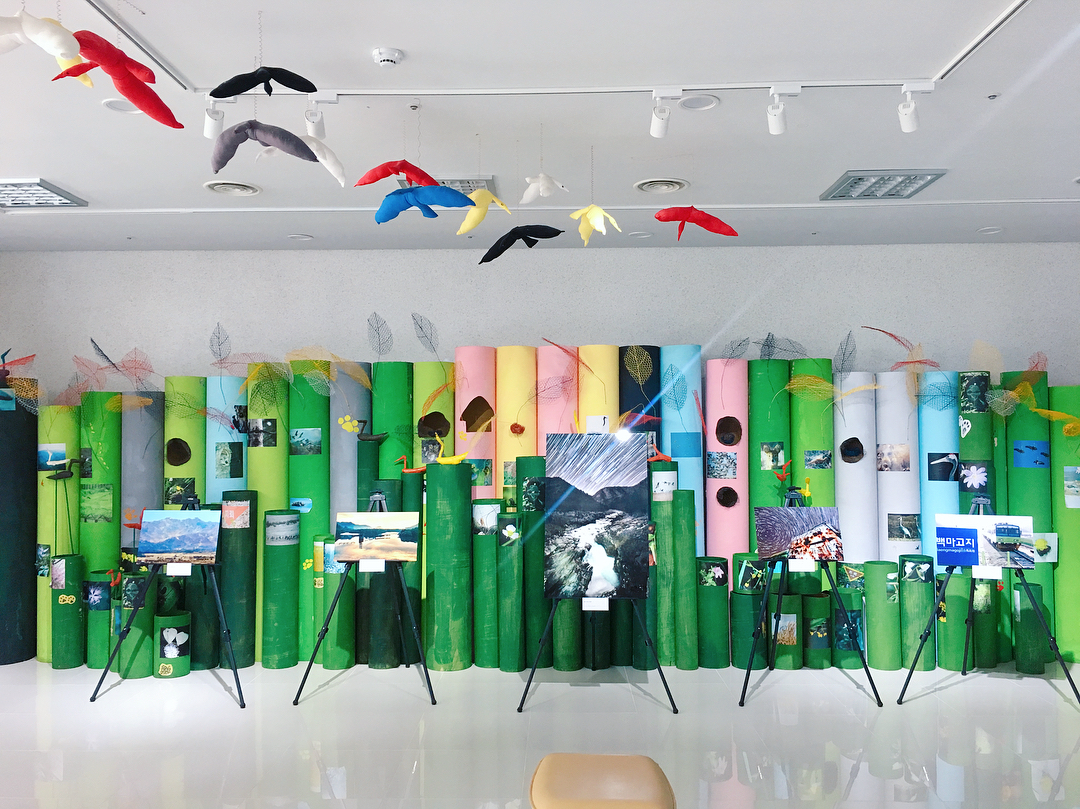
DMZ Museum is comprised of four themed-exhibition halls, in addition to auxiliary buildings including a special exhibition center, theater, and other convenience facilities. The museum teaches visitors everything there is to know about the DMZ, from its historical background to reports on the area's future ecological importance and cultural value. Visit the theater to learn more about the Korean War and its aftermath through 3D documentary films.
Traveling Tips
- The JSA is a must-see for history buffs and anyone looking for a better understanding of the Korean conflict.
- All Panmunjom tour participants are required to carry a valid passport, be at least 10 years of age, and dress appropriately.
- Refrain from wearing worn or faded jeans, exercise clothes, sleeveless shirts, collarless shirts, short skirts, shorts, tight fitting clothes, military clothes, or sandals.
- Don’t speak with, gesture, or even seem to respond to people from the other side (North Korea).
- Sometimes, you will be prevented from entering the common security area (JSA) because of military or other official events.
- If you come from these following countries, you are requested to send the scan of your passports at least 4 days prior to the tour day to your tour operator: Afghanistan, Algeria, Azerbaijan, Bahrain, Bangladesh, Belarus, Bolivia, Bosnia, Burma, China, Cuba, Egypt, Estonia, Georgia, Hong Kong, India, Indonesia, Iran, Iraq, Israel, Jordan, Kazakhstan, Kuwait, Kyrgyzstan, Latvia, Lebanon, Libya, Lithuania, Macau, Malaysia, Moldova, Morocco, Nigeria, North Korea, Oman, Pakistan, Palestinian authority, Qatar, Russia, Saudi Arabia, Singapore, Somalia, Sudan, Syria, Taiwan, Tajikistan, Tunisia, Turkmenistan, Ukraine, United Arab Emirates, Uzbekistan, Venezuela, Vietnam, Yemen
- You can have lunch or dinner at any Korean restaurant nearby during the trip
- The only way to visit Panmunjom is to go with a licensed tour operator.
- Skip to main content
Trazy - Book Travel Crazy Things to do in Asia
Dmz and jsa 1 day tour, how to book.
- Destination
Experience Carousel
Experience basic information, basic information, coupons & promos.

Meet Location
- City Hall Station (Line 2) Exit 5
- Round-trip transportation
- English speaking tour guide
- Entrance fee
Check out Photo reviews

Cancellation policy

DMZ – the Deadly Line Dividing Korea
Panmunjom - jsa.
Their faces are stern and unflinching, eyes hidden behind sunglasses, standing rigid in a martial arts stance.
These soldiers watch over the southern border zone.
The Demilitarized Zone is a 4 kilometer-wide no-man’s-land of woodlands, slicing the Korean peninsula in half.
Guarding this split are landmines, surveillance cameras, watchtowers and barbed wire.

And while the Demilitarized Zone must not hold any serious weaponry, enormous armies and killing machines await easily within reach. Yeah, the DMZ of Korea is perpetually the tensest border on the planet.
Best DMZ tours are the USO tour from Seoul
Actually, it’s the only option.
This is the DMZ Tour Package for Foreigners.
They take you by tour bus into the JSA, or the Joint Security Area, at Panmunjom inside the Zone.
[ SEE INFO BELOW current as of 2022 ]
Both sides administer this area, where views of the North are clear and where the tensions are only metres away.
My visit to the Demilitarized Zone occurred a week after North Korea’s first-ever nuclear test (in 2006), and so the guiding officer spoke of the ‘heightened tension’.
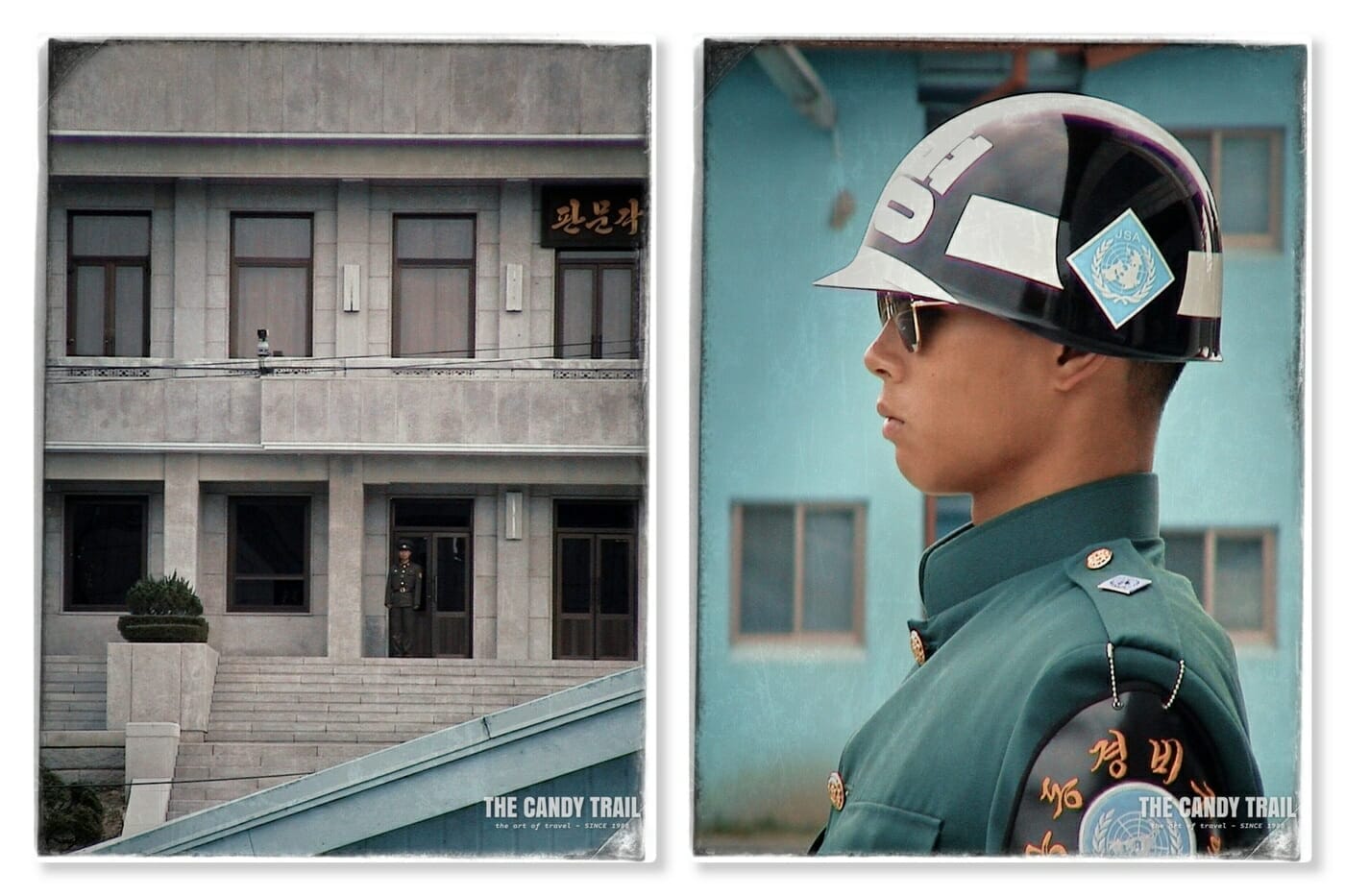
They created the Demilitarized Zone after the Korean War
A ceasefire happened in 1953, yet there’s never been a permanent peace agreement signed.
Over the years, many hostile acts have erupted, mostly started by the North.
Despite the ongoing aggravation, reunification of the peninsula is a stated goal of both Koreas.
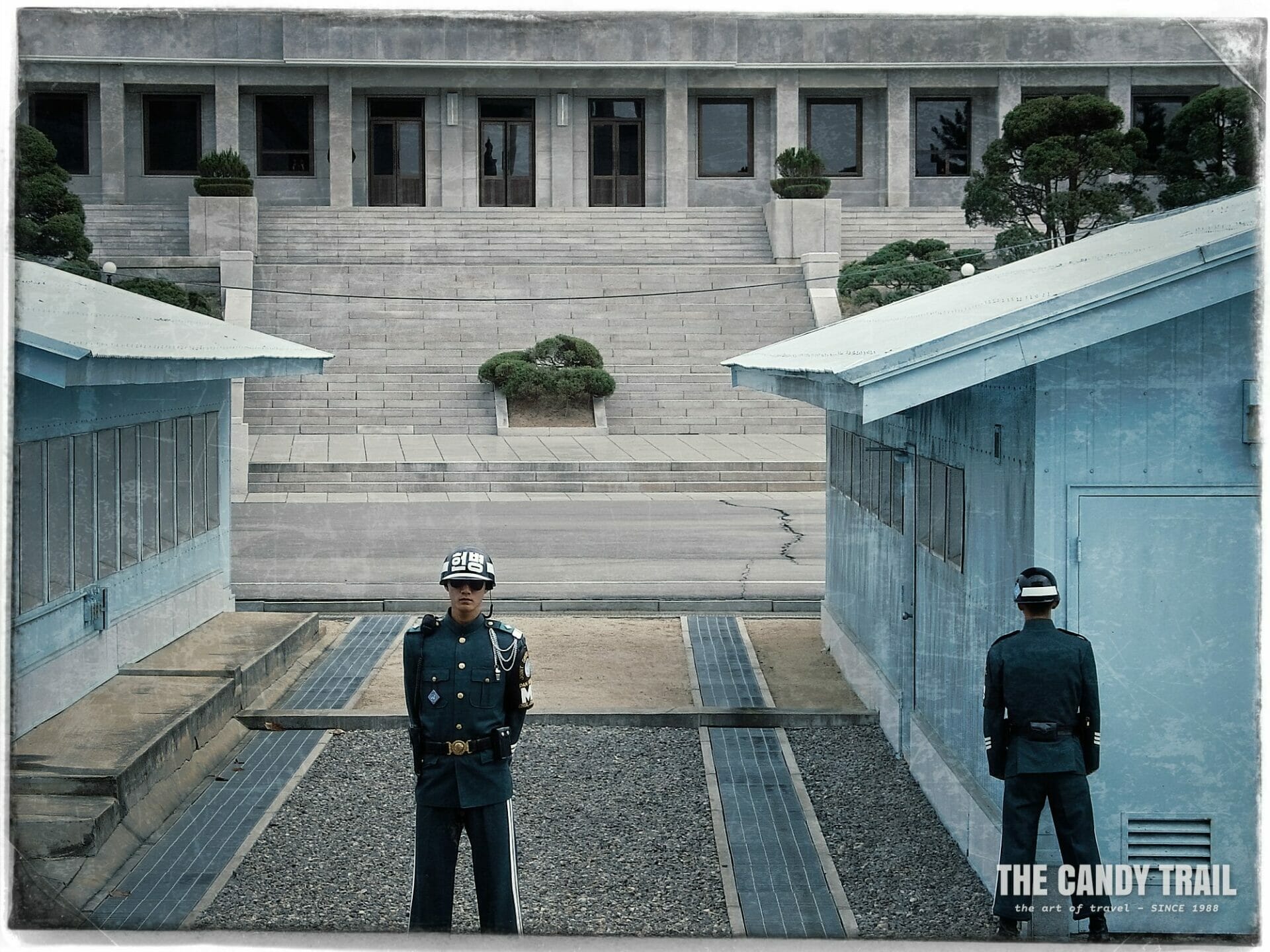
Inside the JSA Meeting Room, the US army guide told us if we sat on the official chairs, we would be “physically removed.”
Likewise, if we dashed across to the North, he or the ROK guards would stop us.
So “don’t embarrass yourselves,” were his warning words.
But like, would anyone in this group really defect to the North?
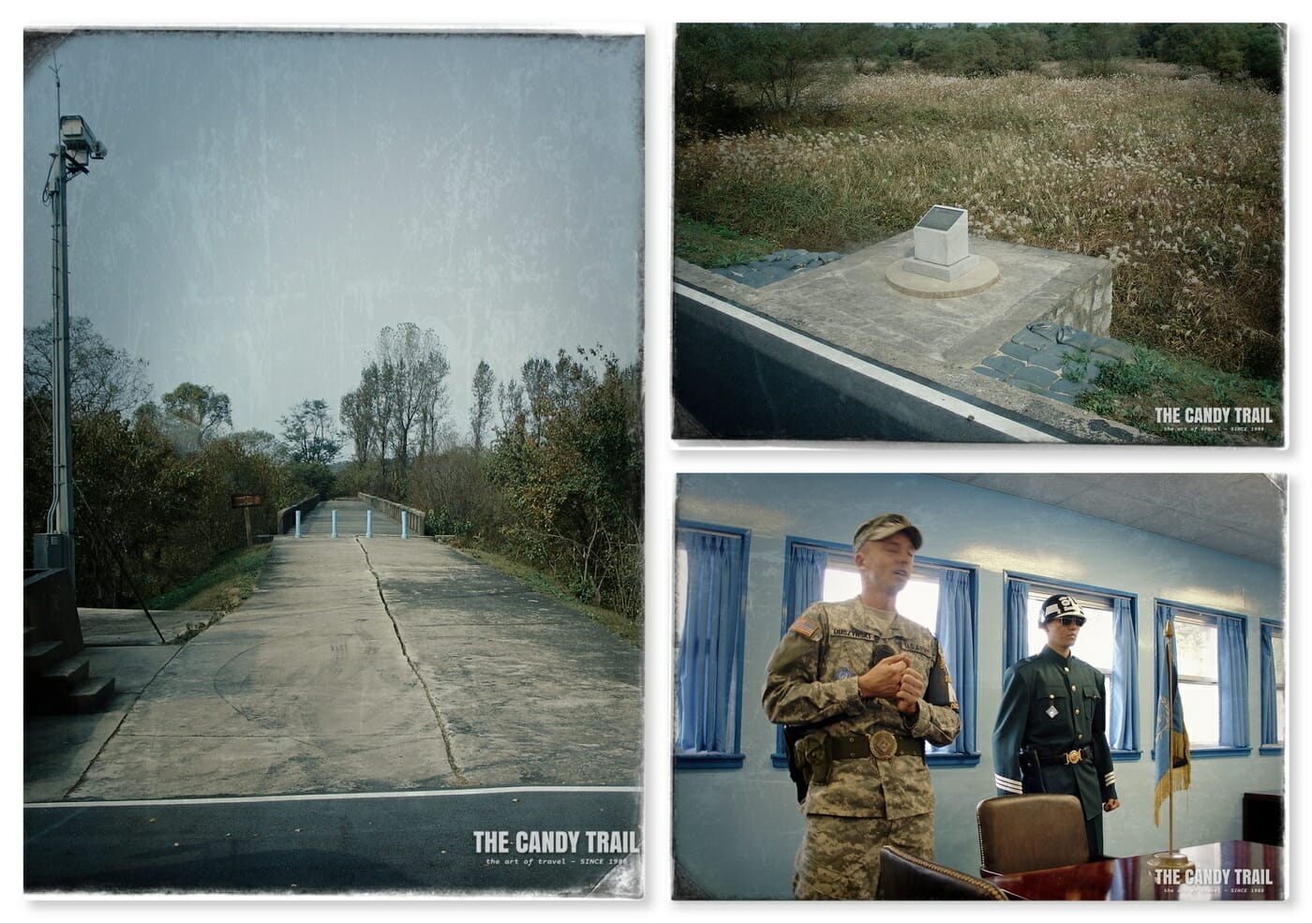
Back in the 1970s – during the Cold War – North Korea had prepared tunnels thru solid rock to attack Seoul (inspired by successful Viet-Cong tactics).
These tunnels were discovered and never used.
The North had painted the walls with coal, claiming the tunnels were for mining. But science proved this false.
According to military assessments, it’s thought one tunnel could’ve surged 30,000 troops and artillery towards Seoul within an hour of hostilities.
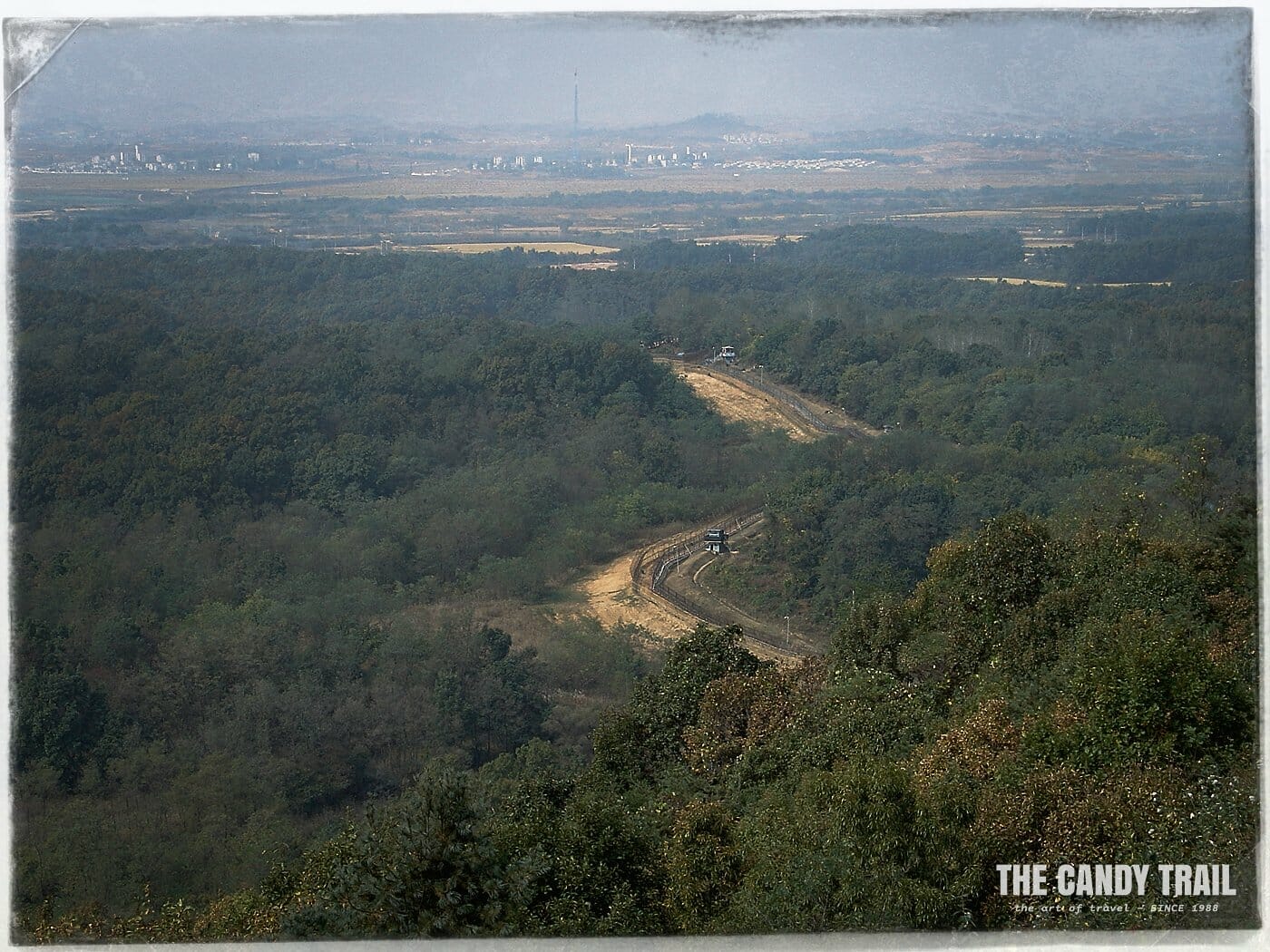
The USO DMZ Tour takes 100 people per visit, only
However, you can’t just stroll around or point your camera anywhere.
In fact, very little walking in the DMZ is allowed.
An army jeep escorted the tour buses from the JSA to other points of interest, including an observation point, where we marveled at a vista of North Korea (below).
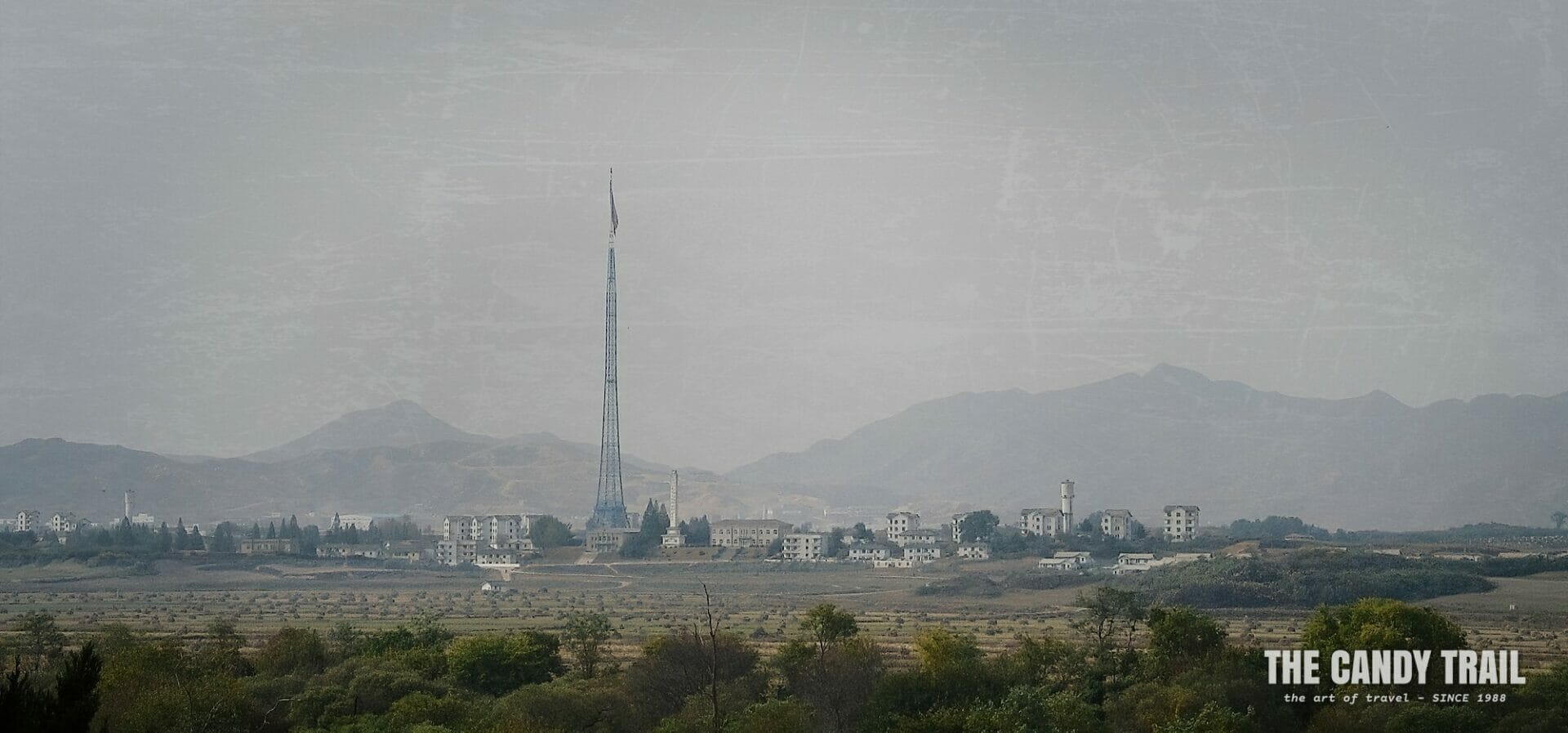
Note: the giant flag pole – 160 metres tall to out-do the South’s village flag-pole standing at 100 metres.
The North’s flag is visible when a good wind catches it.
It’s 30 meters long and one of the world’s biggest – and needs to be replaced every 3 months, because of wear and tear, according to the guide.
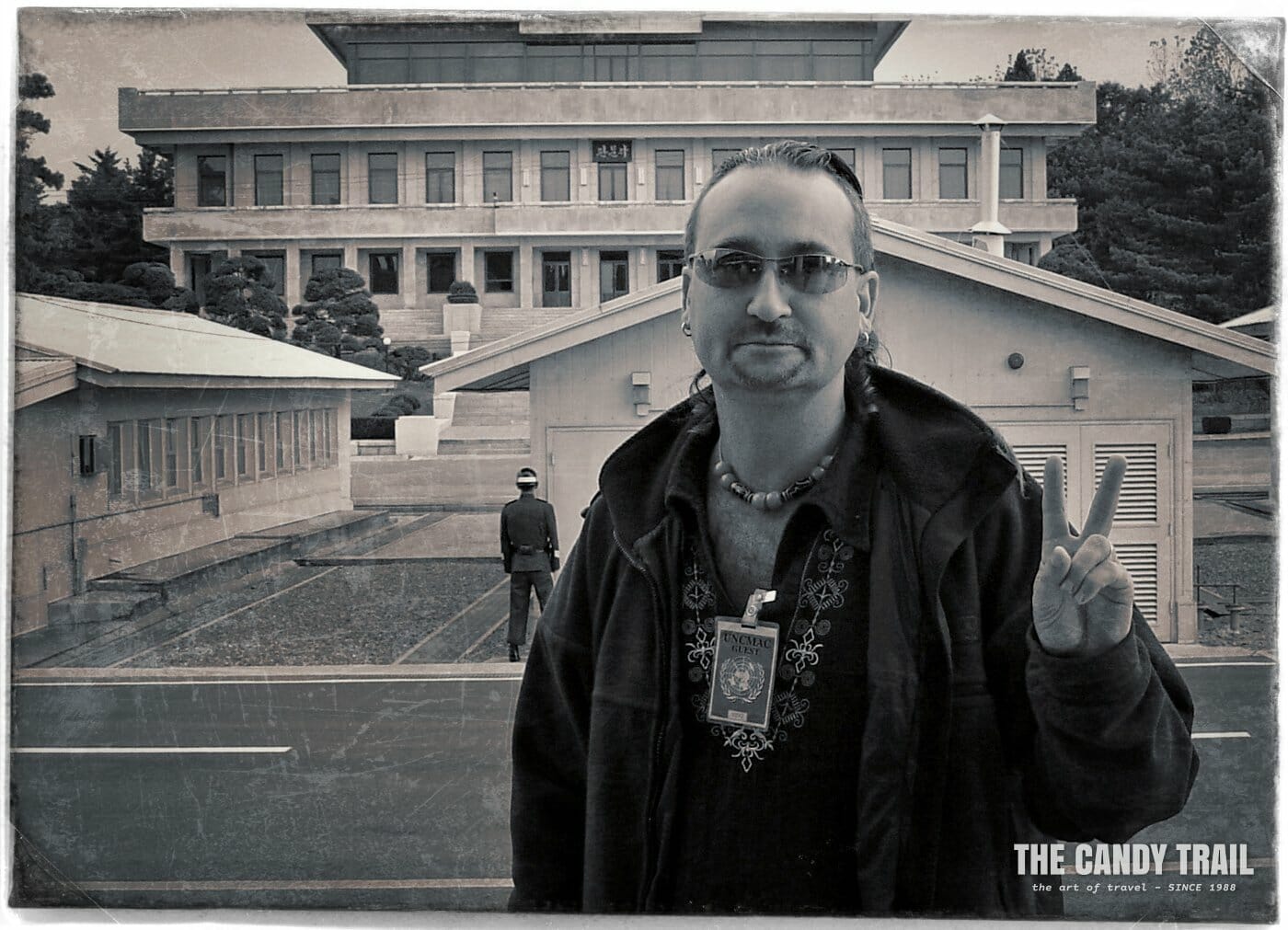
In 2017, I visited the DMZ from North Korea . On the roof terrace of that stern concrete building, I looked over to where I posed this shot in South Korea in 2006.
Taking the USO DMZ Panmunjom Tour
– CHECK FOR LATEST INFO –
First, you can NOT just rock up to the DMZ at Panmunjon.
There was only one choice using USO when I visited, but now it seems there are more choices.
You will need to make an advance tour reservation.
Try the USO reservation here . Or book here at Koridoor .
There are two USO tours available, but I suggest taking the longer, fuller-featured option. I did.
- USO Tours run on Tuesday to Saturday, inclusive, except on national holidays.
- The price of the full-day USO Korea DMZ Tour is $92
- Tour duration: 7:30 – 15:30.
- There is a lunch stop mid-tour, but this cost is NOT included.
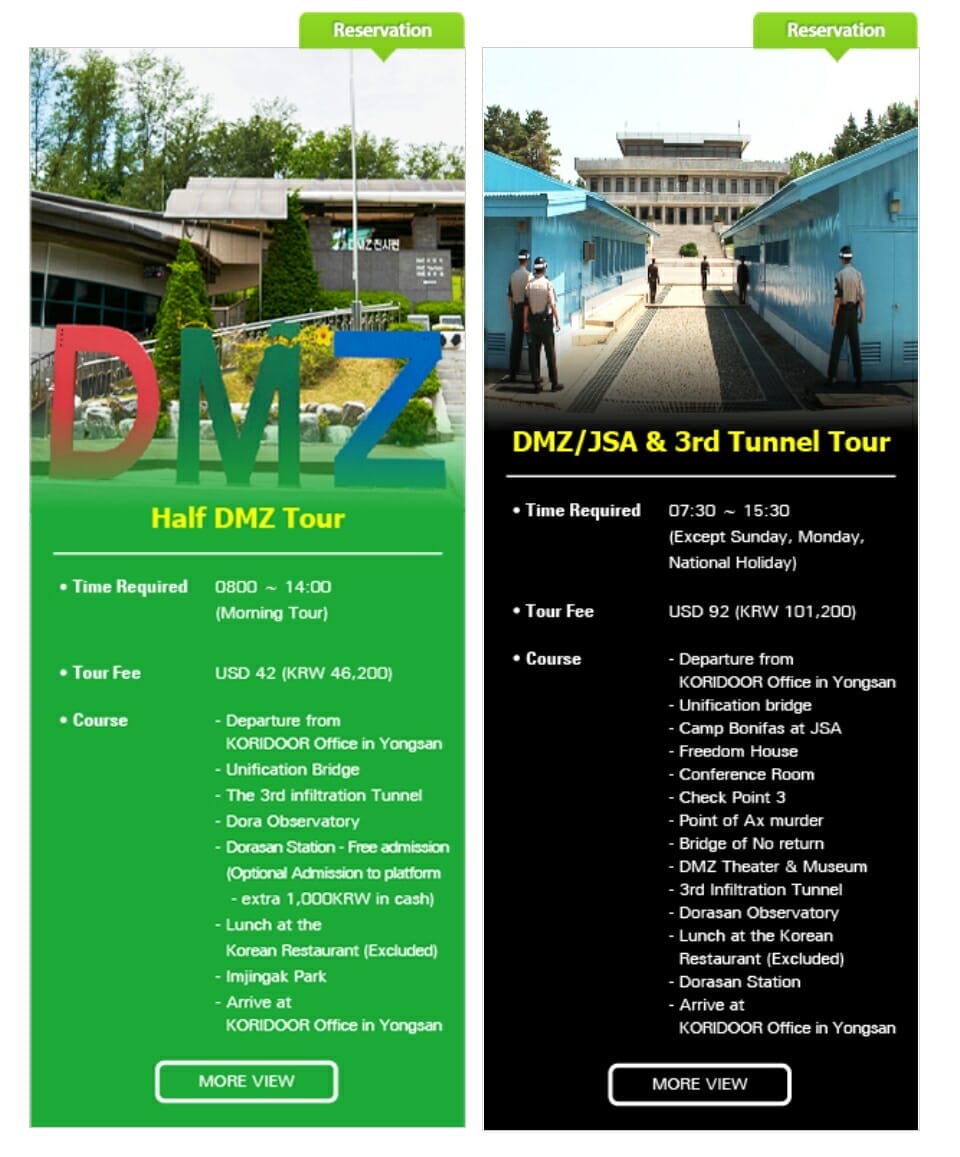
Departure Point: You will need to be at the KORIDOOR office in Yongshan before 7:30. Get there by subway.
Getting there by Subway:
- SAM GAK JI (삼각지) Station – line #4 and #6 : Way out to Exit No. 10 and walk straight about 500 Meters (8 mins) to “SeoJo Building” KORIDOOR Tour office on the 1st floor.
- NAM YOUNG (남영) Station – line # 1 : Way out to Exit No. 1 to the right and walk about 100 Meters (3 mins) to intersection, then turn right and walk about 120 Meters to “SeoJo Building” KORIDOOR Tour office on the 1st floor.
(Info from Koridoor.co.kr – and check this link for taxi directions AND a walking map of the area):
DMZ Korea Tour – Travel Tips
YOU MUST TAKE YOUR PASSPORT.
You must not to speak, gesture, approach, or respond to the North Korea guards.
Wear boots/shoes if doing the tunnel visit.
It’s all very controlled – so listen to the escort soldiers and don’t wander far – or else. The time for each stop is often short/rushed.
THINGS CHANGE:
There may now also be restrictions on visiting the cut tree / axe murder site and the Bridge of No Return because of disagreements with the north. When I visited these sights, they were only accessible from the bus window, anyhow.
The JSA tour has changed from an open spot (always-on tourist destination to a border military zone). Therefore, unlike the pre-booking system, confirmation is daily, and it’s done one day prior to the tour date.
Travels in South Korea – 2006
Join the Journey
Get my FREE book of Crazy Travels & occasional updates
Check your inbox or spam folder to confirm your subscription.
- Election 2024
- Entertainment
- Newsletters
- Photography
- Personal Finance
- AP Investigations
- AP Buyline Personal Finance
- AP Buyline Shopping
- Press Releases
- Israel-Hamas War
- Russia-Ukraine War
- Global elections
- Asia Pacific
- Latin America
- Middle East
- Election Results
- Delegate Tracker
- AP & Elections
- Auto Racing
- 2024 Paris Olympic Games
- Movie reviews
- Book reviews
- Personal finance
- Financial Markets
- Business Highlights
- Financial wellness
- Artificial Intelligence
- Social Media
A closer look at Panmunjom, the famous border town where a US soldier crossed into North Korea
FILE - A North Korean soldier looks at the southern side through a pair of binoculars at the border village of the Panmunjom, in the Demilitarized Zone, DMZ, that separates the two Koreas since the Korean War, in Paju, north of Seoul, South Korea, Tuesday, March 19, 2013. A series of low-slung buildings and somber soldiers dot the landscape of the DMZ, the swath of land between North and South Korea where a soldier on a tour crossed into North Korea on Tuesday, July 18, 2023, under circumstances that remain unclear. (AP Photo/Lee Jin-man, File)
FILE - A model of the Demilitarized Zone, DMZ, that separates the two halves of the Korean peninsula is displayed near Kaesong, North Korea, on Sept. 18, 2008. A series of low-slung buildings and somber soldiers dot the landscape of the DMZ, the swath of land between North and South Korea where a soldier on a tour crossed into North Korea on Tuesday, July 18, 2023, under circumstances that remain unclear. (AP Photo/David Guttenfelder, File)
FILE - North Korea’s flag flies on a tower high above the village of Ki Jong Dong, as seen from Observation Post Ouellette in the Demilitarized Zone, DMZ, the tense military border between the two Koreas, in Panmunjom, Korea, March 25, 2012. A series of low-slung buildings and somber soldiers dot the landscape of the DMZ, the swath of land between North and South Korea where a soldier on a tour crossed into North Korea on Tuesday, July 18, 2023, under circumstances that remain unclear. (AP Photo/Susan Walsh, File)
FILE - South Korean soldiers look at the North Korean side through binoculars at Dora Observation Post in the demilitarized zone, DMZ, near the border village of Panmunjom that separates the two Koreas since the Korean War, in Paju, north of Seoul, South Korea, Wednesday, May 27, 2009. A series of low-slung buildings and somber soldiers dot the landscape of the DMZ, the swath of land between North and South Korea where a soldier on a tour crossed into North Korea on Tuesday, July 18, 2023, under circumstances that remain unclear. (AP Photo/Lee Jin-man, File)
FILE - South Korean soldiers patrol while hikers visit the DMZ Peace Trail in the demilitarized zone in Goseong, South Korea, June 14, 2019. A series of low-slung buildings and somber soldiers dot the landscape of the DMZ, or demilitarized zone, the swath of land between North and South Korea where a soldier on a tour crossed into North Korea on Tuesday, July 18, 2023, under circumstances that remain unclear. (AP Photo/Ahn Young-joon, File)
- Copy Link copied
Low-slung buildings, blue huts and somber soldiers dot the border village of Panmunjom inside the DMZ, or demilitarized zone, the swath of land between North and South Korea where a U.S. soldier on a tour crossed into the North under circumstances that remained murky.
The soldier was on a tour of the storied border town, inside the heavily fortified 154-mile-long (248-kilometer-long) DMZ, when the crossing happened, U.S. officials said Tuesday. It remained unknown exactly what prompted the soldier’s actions, though U.S. officials said he was facing disciplinary action after he had been held in South Korea on assault charges. The soldier was believed to be in North Korean custody.
The DMZ is lined with observation posts on both sides, whose soldiers watch the border and each other carefully for any signs of transgression. North and South Korea remain technically in a state of war since the hostilities in Korean War ended and an armistice was signed — at Panmunjom — in 1953. Neither nation has direct jurisdiction over Panmunjom , where a concrete slab divides the two nations.
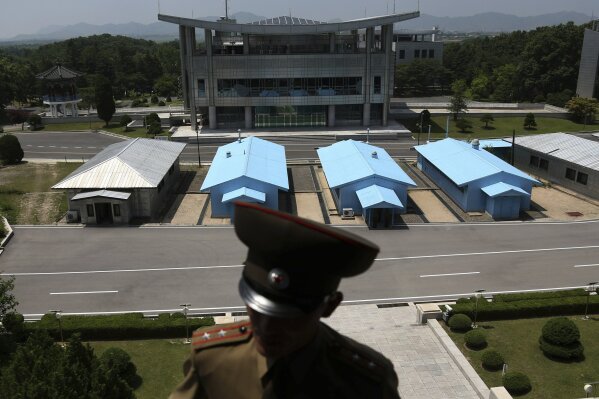
North Korea, whose formal name is the DPRK, or the Democratic People’s Republic of Korea, maintains tight controls on entry and has been known to punish those who illegally cross the border from South Korea into its territory. Not all of the frontier with South Korea is as strictly patrolled as the DMZ around Panmunjom, though it is unclear how intensively the North patrols its side in more remote areas.
The North under the Kim family and the third-generation current leader, Kim Jong Un, is a tightly controlled society, and very few Americans are in the country at any given time; the two countries have no diplomatic relations and typically conduct any necessary diplomacy through third countries.
While the South Korean side of the DMZ brings in frequent tourists, few North Koreans have ever ventured either to or near their side of the heavily fortified DMZ. On the South Korean side, though, the different areas where tourists are welcomed sometimes take pains to put on a positive spin, with colorful ribbons tied to railings and the occasional ribbon-wielding dancer performing not far from barbed wire and stone-faced soldiers. Cameras are OK in some locations and prohibited in others.
FILE - A model of the Demilitarized Zone, DMZ, that separates the two halves of the Korean peninsula is displayed near Kaesong, North Korea, on Sept. 18, 2008. (AP Photo/David Guttenfelder, File)
During the politically inflected 2018 Olympics in the South Korean town of Pyeongchang, Associated Press journalists were shown the baby blue-colored room in Panmunjom that’s the only spot where high-level talks are held between the two countries. In the room was a large wooden table where talks are held. The border runs right down the middle of it.
At one point during another 2018 visit at another site along the DMZ, an AP illustrator was sketching the view below when a South Korean soldier came over and tore four pages from his book.
Tours to the southern side of Panmunjom reportedly drew around 100,000 visitors a year before the pandemic, when South Korea restricted gatherings to slow the spread of COVID. The tours resumed fully last year.
There have been a small number of U.S. soldiers who went to North Korea during the Cold War, including Charles Jenkins , who deserted his army post in South Korea in 1965 and fled across the DMZ. He appeared in North Korean propaganda films and married a Japanese nursing student who had been abducted from Japan by North Korean agents. He died in Japan in 2017.
Associated Press journalists Paul Newberry, Cara Rubinsky, Claire Galofaro and Howie Rumberg contributed to this report.
A Closer Look at Panmunjom, the Famous Border Town Where a US Soldier Crossed Into North Korea
A series of low-slung buildings and somber soldiers dot the border village of Panmunjom inside the DMZ, or demilitarized zone

Lee Jin-man
FILE - A North Korean soldier looks at the southern side through a pair of binoculars at the border village of the Panmunjom, in the Demilitarized Zone, DMZ, that separates the two Koreas since the Korean War, in Paju, north of Seoul, South Korea, Tuesday, March 19, 2013. A series of low-slung buildings and somber soldiers dot the landscape of the DMZ, the swath of land between North and South Korea where a soldier on a tour crossed into North Korea on Tuesday, July 18, 2023, under circumstances that remain unclear. (AP Photo/Lee Jin-man, File)
Low-slung buildings, blue huts and somber soldiers dot the border village of Panmunjom inside the DMZ, or demilitarized zone, the swath of land between North and South Korea where a U.S. soldier on a tour crossed into the North under circumstances that remained murky.
The soldier was on a tour of the storied border town, inside the heavily fortified 154-mile-long (248-kilometer-long) DMZ, when the crossing happened, U.S. officials said Tuesday. It remained unknown exactly what prompted the soldier's actions, though U.S. officials said he was facing disciplinary action after he had been held in South Korea on assault charges. The soldier was believed to be in North Korean custody.
The DMZ is lined with observation posts on both sides, whose soldiers watch the border and each other carefully for any signs of transgression. North and South Korea remain technically in a state of war since the hostilities in Korean War ended and an armistice was signed — at Panmunjom — in 1953. Neither nation has direct jurisdiction over Panmunjom , where a concrete slab divides the two nations.
North Korea, whose formal name is the DPRK, or the Democratic People's Republic of Korea, maintains tight controls on entry and has been known to punish those who illegally cross the border from South Korea into its territory. Not all of the frontier with South Korea is as strictly patrolled as the DMZ around Panmunjom, though it is unclear how intensively the North patrols its side in more remote areas.
The North under the Kim family and the third-generation current leader, Kim Jong Un, is a tightly controlled society, and very few Americans are in the country at any given time; the two countries have no diplomatic relations and typically conduct any necessary diplomacy through third countries.
Photos You Should See - April 2024

While the South Korean side of the DMZ brings in frequent tourists, few North Koreans have ever ventured either to or near their side of the heavily fortified DMZ. On the South Korean side, though, the different areas where tourists are welcomed sometimes take pains to put on a positive spin, with colorful ribbons tied to railings and the occasional ribbon-wielding dancer performing not far from barbed wire and stone-faced soldiers. Cameras are OK in some locations and prohibited in others.
During the politically inflected 2018 Olympics in the South Korean town of Pyeongchang, Associated Press journalists were shown the baby blue-colored room in Panmunjom that's the only spot where high-level talks are held between the two countries. In the room was a large wooden table where talks are held. The border runs right down the middle of it.
At one point during another 2018 visit at another site along the DMZ, an AP illustrator was sketching the view below when a South Korean soldier came over and tore four pages from his book.
Tours to the southern side of Panmunjom reportedly drew around 100,000 visitors a year before the pandemic, when South Korea restricted gatherings to slow the spread of COVID. The tours resumed fully last year.
There have been a small number of U.S. soldiers who went to North Korea during the Cold War, including Charles Jenkins , who deserted his army post in South Korea in 1965 and fled across the DMZ. He appeared in North Korean propaganda films and married a Japanese nursing student who had been abducted from Japan by North Korean agents. He died in Japan in 2017.
Associated Press journalists Paul Newberry, Cara Rubinsky, Claire Galofaro and Howie Rumberg contributed to this report.
Copyright 2023 The Associated Press . All rights reserved. This material may not be published, broadcast, rewritten or redistributed.
Join the Conversation
Tags: Associated Press , politics , world news
America 2024

Health News Bulletin
Stay informed on the latest news on health and COVID-19 from the editors at U.S. News & World Report.
Sign in to manage your newsletters »
Sign up to receive the latest updates from U.S News & World Report and our trusted partners and sponsors. By clicking submit, you are agreeing to our Terms and Conditions & Privacy Policy .
You May Also Like
The 10 worst presidents.
U.S. News Staff Feb. 23, 2024

Cartoons on President Donald Trump
Feb. 1, 2017, at 1:24 p.m.

Photos: Obama Behind the Scenes
April 8, 2022

Photos: Who Supports Joe Biden?
March 11, 2020

RFK Jr.: By the Numbers
Laura Mannweiler April 26, 2024

Biden’s Student Loan Chief to Step Down
Lauren Camera April 26, 2024

What to Know: Bird Flu Virus in Milk
Cecelia Smith-Schoenwalder April 26, 2024

Inflation a Stubborn Foe for the Fed
Tim Smart April 26, 2024

The Curse of the Modern Vice President

‘A Rule for the Ages’
Lauren Camera April 25, 2024


IMAGES
VIDEO
COMMENTS
PREMIUM Panmunjom(JSA) tour with a North Korean defector Panmunjom is located inside the Demilitarized Zone(DMZ) and is the closet location to Nortth Korea for visitors to see. The tension is very high and only a limited number of people are allowed to visit Panmunjom at one time.
Visit the historic site where North and South Korea face each other on a UN-controlled tour. Learn about the Korean War, the armistice agreement, and the unification bridge on this half-day trip from Seoul.
Korean Demilitarized Zone (DMZ) and Joint Security Area (JSA) tour from Seoul. See the demarcation of North Korea and South Korea at the infamous border with an expert guide. Visit Imjingak Park, the Freedom Bridge, the 3rd Infiltration Tunnel and the DMZ exhibition hall. Stop by the JSA's Freedom House and learn about Bridge of No Return ...
The Joint Security Area (JSA) is the only part of DMZ where South and North Korean forces stand face-to-face. Why this tour? Visit not only JSA (Panmunjom) but also the War Memorial of Korea in one day. Feel the tension between North Korea and South Korea right next to the borderline. Gain in-depth knowledge about the Korean War.
Reconfirmation is required the day before and payment is made the day of travel. The PTC office is located on the sixth floor of the Lotte Hotel in central Seoul. This is convenient as the hotel is located just off subway line #2 at Euljiro 1-Ga station. PTC offers 3 types of tours. Tour #1 is to Panmunjom, tour #2 visits the DMZ only and tour ...
As the Panmunjom tour takes place in a spot where North and South Korea coexist, the following needs to be taken note of when applying for the tour. 1. Tourists must bring passport on tour day. 2. Dress code: No worn of faded jeans, exercise clothes, sleeveless shirts, miniskirts, sandals and slipper,
10:20 Briefing at Camp Bonifas. 10:30 JSA Panmunjom Tour. Tour of JSA (Joint Security Area), Peace House, Bridge of No Return, Freedom House, Axe Murder Incidents area etc. 12:20 Lunch (Bulgogi) & Imjingak Park Tour. 13:40 Leave for Seoul. 14:50 Dropoff at Hotel President or Lotte Hotel (Euljiro 1 (il)-ga) Meeting time could change.
Panmunjom is where the Korean War Armistice was signed in 1953. North and South Korea are still technically at war as peace treaty was never signed. It was agreed that a no-man's land 4 kilometres wide and 250 kilometres long stretching across the Korean Peninsula would be created. This is known as the Demilitarised Zone (DMZ).
Only within limits person can use the mono-rail into the tunnel. DMZ Fence tour. It is the only one symbol of divided country in the world. It is located apart 2km from MDL and we called South MDL and North. Alternative tour information. Panmunjom (JSA) No Tour Days for the 4th Quarter of 201..
Experience the intensity of the Korean Demilitarized Zone with a visit to the Joint Security Area (a.k.a. Panmunjom), connecting North Korea and South Korea. See monuments and relics of the Korean War and get to visit the infamous Third Tunnel.
Delving into the heart of the history, this tour skips the outer edges of the DMZ and takes you to the Joint Security Area (JSA), also known as Panmunjom. This was the site of talks and negotiation between the two sides during the Korean wars. You'll visit the historical war monuments at Unification Park before a Korean restaurant lunch, after ...
You can visit other areas of the Korean demilitarized zone with Korea DMZ Tours. If the DMZ is unavailable, you can still get close to the border with a Northern Limit Line Tour. In 1953, Panmunjom was the site where the signing of the Korean Armistice Agreement took place to end the Korean war.
As the Panmunjom JSA tour takes place in a spot where North and South Korea coexist, the following needs to be taken note of when applying for the tour. 1. You must be ready and waiting at the designated spot 20 minutes before the departure time on the day of the tour. 2. You must have your passport with you on the tour. 3.
Panmunjom and the DMZ is nearby the city of Kaesong in North Hwanghae Province. Visitors can either travel direct from Pyongyang (2-3 hour drive) or stay overnight in Kaesong and travel from there. Tourist buses first travel through a huge concrete arch into the car park. This arch has the word 'Reunification' written in huge white letters ...
About the DMZ. The Demilitarized Zone (DMZ) at Panmunjom is a heavily fortified buffer zone that separates North Korea and South Korea. The 4km wide DMZ stretches 250km (160miles) across the Korean peninsula and was created in 1953 during the armistice after the Korean War. Here I will recount my Panmunjom tour in December 2018.
Panmunjom (JSA) tour with a North Korean defector; How to get to Panmunjom. Panmunjom sits less than 40 miles from Seoul. The only way into this heavily restricted area is on an organized tour. To enter the JSA, visitors must pass through multiple checkpoints before arriving at Camp Bonifas, escorted by either US or South Korean soldiers. Note ...
In just one day, you will get a complete insight of the North and South relations through this exclusive tour. Why this tour? Visit the main part of Demilitarized Zone (DMZ) and Joint Security Area (JSA) in 1 day. - JSA (including Panmunjom): the only area in DMZ where South and North Korean forces stand face-to-face.
USO Tours run on Tuesday to Saturday, inclusive, except on national holidays. The price of the full-day USO Korea DMZ Tour is $92. Tour duration: 7:30 - 15:30. There is a lunch stop mid-tour, but this cost is NOT included. Departure Point: You will need to be at the KORIDOOR office in Yongshan before 7:30.
Panmunjom is in the demilitarized zone, or DMZ, a 2.5-mile-wide strip of land that's strewn with mines and lined with barbed wire. The DMZ is a buffer between the Koreas, which technically are ...
Tours to the southern side of Panmunjom reportedly drew around 100,000 visitors a year before the pandemic, when South Korea restricted gatherings to slow the spread of COVID. The tours resumed fully last year. There have been a small number of U.S. soldiers who went to North Korea during the Cold War, ...
Tours to the southern side of Panmunjom reportedly drew around 100,000 visitors a year before the pandemic, when South Korea restricted gatherings to slow the spread of COVID. The tours resumed ...